The Sinking and Wreck of the
Wilhelm Gustloff
January 30th, 1945
Wilhelm Gustloff
January 30th, 1945
Kriegsmarine blanket saved from the sinking Wilhelm Gustloff - January 30th, 1945 - 9:00pm
When the torpedoes from the S-13 exploded against the Gustloff, passengers began the stampede to escape the sinking liner. One of the male passengers was sitting in the cabin he shared when the liner was hit. Knowing the temperature outside, he bundled up and grabbed a Kriegsmarine blanket which was nearby. As the ship listed, he managed to climb into a lifeboat with the blanket wrapped around him and was lowered into the freezing sea. A few minutes later, the Wilhelm Gustloff disappeared forever beneath the Baltic waves. He was rescued from the water by the T-36 commanded by Capt. Robert Hering and taken back to land with the blanket still wrapped around himself. During the years, he kept it stowed away and when he died of cancer, it was inherited by his son. Eventually, he anonymously turned it over to a German auction house in 2008 to be sold along with other items from the personal collection.
At right is said blanket which we acquired for our Wilhelm Gustloff collection. This piece was purchased on November 22, 2008 at a military auction from Dresden, Germany from the Alschner Antique House. The letter which accompanies it is as follows:
"This article concerns a bog standard Kriegsmarine blanket from WWII, which belonged to a survivor of the ship Wilhelm Gustloff. Who struggled onto a lifeboat with this blanket during that fateful night, whose occupants were subsequently taken on board and rescued by a German torpedo boat, which I have been made aware of by his son. Sadly, his father - the owner of the blanket - died some years ago due to cancer. According to the son, the commander of the torpedo boat, Hering, rescued some hundred survivors..."
The blanket is a grey wool/rayon blend which measures 6' 4" long and 4' 4" wide. It has a 4" wide interwoven red stripe positioned near each end. Both the side edges of the blanket have the typical, tightly woven, interlocking, reinforcement threads to prevent fraying. One side of the blanket has the hand, chain stitched, script, "Kriegsmarine", in red cotton threads. The script is also visible on the other side as a mirror image. There is one large hole and several small ones (whether caused by moths, age, or from the sinking is unknown.)
All records from the auction, including the note stating the blanket's history, remains in our archive. The above description is a general translation from the German letter. An emotional piece which was on board that night and survived the worst sinking in history.
When the torpedoes from the S-13 exploded against the Gustloff, passengers began the stampede to escape the sinking liner. One of the male passengers was sitting in the cabin he shared when the liner was hit. Knowing the temperature outside, he bundled up and grabbed a Kriegsmarine blanket which was nearby. As the ship listed, he managed to climb into a lifeboat with the blanket wrapped around him and was lowered into the freezing sea. A few minutes later, the Wilhelm Gustloff disappeared forever beneath the Baltic waves. He was rescued from the water by the T-36 commanded by Capt. Robert Hering and taken back to land with the blanket still wrapped around himself. During the years, he kept it stowed away and when he died of cancer, it was inherited by his son. Eventually, he anonymously turned it over to a German auction house in 2008 to be sold along with other items from the personal collection.
At right is said blanket which we acquired for our Wilhelm Gustloff collection. This piece was purchased on November 22, 2008 at a military auction from Dresden, Germany from the Alschner Antique House. The letter which accompanies it is as follows:
"This article concerns a bog standard Kriegsmarine blanket from WWII, which belonged to a survivor of the ship Wilhelm Gustloff. Who struggled onto a lifeboat with this blanket during that fateful night, whose occupants were subsequently taken on board and rescued by a German torpedo boat, which I have been made aware of by his son. Sadly, his father - the owner of the blanket - died some years ago due to cancer. According to the son, the commander of the torpedo boat, Hering, rescued some hundred survivors..."
The blanket is a grey wool/rayon blend which measures 6' 4" long and 4' 4" wide. It has a 4" wide interwoven red stripe positioned near each end. Both the side edges of the blanket have the typical, tightly woven, interlocking, reinforcement threads to prevent fraying. One side of the blanket has the hand, chain stitched, script, "Kriegsmarine", in red cotton threads. The script is also visible on the other side as a mirror image. There is one large hole and several small ones (whether caused by moths, age, or from the sinking is unknown.)
All records from the auction, including the note stating the blanket's history, remains in our archive. The above description is a general translation from the German letter. An emotional piece which was on board that night and survived the worst sinking in history.
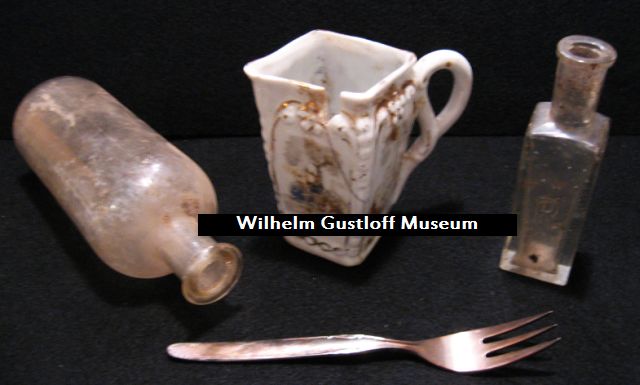
Artifacts recovered from the wreck of the Wilhelm Gustloff - 1980s
Photographed at right are four artifacts which were recovered from the wreck of the Wilhelm Gustloff in the 1980s by Polish sport divers. During this time, several divers went to the wreck gathering everything from hand rails and decking to portholes and interior effects. Recovered before diving limits were imposed upon the wreck, these, along with several other artifacts were divided up by said divers. One of our contacts in Germany, who is also a Gustloff collector, purchased several pieces for his personal collection. In 2009, we acquired and transferred these artifacts over to our Wilhelm Gustloff exhibit. They are as follows:
1. Medium Glass Bottle
- Used for medicine out of the ship's pharmacy, measures 15cm high with the marking "200" on the bottom. Left 'as is' from the wreck, still contains sediment inside and out. Very good condition.
2. Porcelain China Pot
- Probably a family piece from one of the fleeing refugees onboard, measures 8.5cm high, 9.5cm on the top from spout to handle edge. Originally had four painted scenes, one on each side. Two have been completely erased by the seawater, one is badly faded, and the final scene of a windmill is still intact, but damaged. Gold trim around the top and scenes is faded or missing, 1.5cm chip and hairline crack to the base present on the side with the intact painting. Left 'as is' from the wreck, contains sediment and rust throughout.
3. Small Glass Bottle
- Used for medicine out of the ship's pharmacy as well, measures 11cm high with the marking "R" on the front. Left 'as is' from the wreck, still contains sediment inside and out. Very good condition. (Images of the Wilhelm Gustloff's on board pharmacy can be seen to the right.)
4. Silver Fork
- Smaller 15cm cake or dessert fork in remarkable condition. Plain design aside from a small decoration in the middle of the piece. Because there was no damage to the piece aside from tarnishing, it has since been cleaned to its original condition. It is amazing how well silverware can cope underwater. The silverware in the RMS Republic museum photo fared even better than this for having been submerged for twice as long.
Photographed at right are four artifacts which were recovered from the wreck of the Wilhelm Gustloff in the 1980s by Polish sport divers. During this time, several divers went to the wreck gathering everything from hand rails and decking to portholes and interior effects. Recovered before diving limits were imposed upon the wreck, these, along with several other artifacts were divided up by said divers. One of our contacts in Germany, who is also a Gustloff collector, purchased several pieces for his personal collection. In 2009, we acquired and transferred these artifacts over to our Wilhelm Gustloff exhibit. They are as follows:
1. Medium Glass Bottle
- Used for medicine out of the ship's pharmacy, measures 15cm high with the marking "200" on the bottom. Left 'as is' from the wreck, still contains sediment inside and out. Very good condition.
2. Porcelain China Pot
- Probably a family piece from one of the fleeing refugees onboard, measures 8.5cm high, 9.5cm on the top from spout to handle edge. Originally had four painted scenes, one on each side. Two have been completely erased by the seawater, one is badly faded, and the final scene of a windmill is still intact, but damaged. Gold trim around the top and scenes is faded or missing, 1.5cm chip and hairline crack to the base present on the side with the intact painting. Left 'as is' from the wreck, contains sediment and rust throughout.
3. Small Glass Bottle
- Used for medicine out of the ship's pharmacy as well, measures 11cm high with the marking "R" on the front. Left 'as is' from the wreck, still contains sediment inside and out. Very good condition. (Images of the Wilhelm Gustloff's on board pharmacy can be seen to the right.)
4. Silver Fork
- Smaller 15cm cake or dessert fork in remarkable condition. Plain design aside from a small decoration in the middle of the piece. Because there was no damage to the piece aside from tarnishing, it has since been cleaned to its original condition. It is amazing how well silverware can cope underwater. The silverware in the RMS Republic museum photo fared even better than this for having been submerged for twice as long.
"Wilhelm Gustloff" - Disaster
Party stormed with inquiries
The offices of the Party and the Navy in all parts of the Reich were yesterday stormed by anxious persons, who suspect that their relatives were perhaps onboard the "Wilhelm Gustloff", which was torpedoed by a Russian submarine on January 30th at 9:00 pm in the Danzig Bay and sunk within 15 minutes. The number of victims of the "Wilhelm Gustloff" disaster is still not certain, since no office of the Party or of the Kriegsmarine can accurately say, how many Eastern refugees and members of the Wehrmacht were on board, when the ship left Gotenhafen.
932 saved
On the basis of the latest research, it must be assumed that not 8,000, as we reported yesterday, but 10 to 11,000 passengers were on board. Only 932 were saved. Of which 658 were members of the Kriegsmarine. Serious accusations are now being raised against the Danzig Party offices, who insisted that the "Wilhelm Gustloff" should depart on January 30th, even though the head of the Security Baltic Sea had pointed out that the necessary number of security units could not be placed before February 4.
The "Wilhelm Gustloff" departed nevertheless on the 30th of January in the evening with the completely inadequate securing from an outpost boat and two R-boats. All the decks of the "Wilhelm Gustloff" were so crowded that no one could move. At the embarkation it was said, the journey takes however only a few hours.When the ship was hit by the Russian torpedo at exactly 9 o'clock pm, just an hour after the departure, hardly anybody could escape from the lower decks. Many passengers were thrown into the sea at the time the ship capsized, frozen in the icy water before they could be helped.
Survivors report the horror scene, which took place after the explosion onboard the ship. All lights on board are extinguished at a stroke. In wild panic, the passengers tried to find a way to the deck despite the darkness. Hundreds of women and children were trampled to death on the stairs and corridors.
Women and children
In the fierce battle that took place around the few rescue boats, women and children were ruthlessly pushed overboard. After just ten minutes, the 25,000 - ton ship listed hard. Five minutes later, the "Wilhelm Gustloff" capsized and took many thousands with her into the depth. Others, who had fallen from the deck or hurled into the sea, fell into the wake of the sinking ship and disappeared into the flood. The "Wilhelm Gustloff" was finished in 1937 as a KdF ship and was taken over by the Kriegsmarine in 1940 first as a hospital ship. Since March 1941 she was the home of the submarine teaching division in Gotenhafen.
Party stormed with inquiries
The offices of the Party and the Navy in all parts of the Reich were yesterday stormed by anxious persons, who suspect that their relatives were perhaps onboard the "Wilhelm Gustloff", which was torpedoed by a Russian submarine on January 30th at 9:00 pm in the Danzig Bay and sunk within 15 minutes. The number of victims of the "Wilhelm Gustloff" disaster is still not certain, since no office of the Party or of the Kriegsmarine can accurately say, how many Eastern refugees and members of the Wehrmacht were on board, when the ship left Gotenhafen.
932 saved
On the basis of the latest research, it must be assumed that not 8,000, as we reported yesterday, but 10 to 11,000 passengers were on board. Only 932 were saved. Of which 658 were members of the Kriegsmarine. Serious accusations are now being raised against the Danzig Party offices, who insisted that the "Wilhelm Gustloff" should depart on January 30th, even though the head of the Security Baltic Sea had pointed out that the necessary number of security units could not be placed before February 4.
The "Wilhelm Gustloff" departed nevertheless on the 30th of January in the evening with the completely inadequate securing from an outpost boat and two R-boats. All the decks of the "Wilhelm Gustloff" were so crowded that no one could move. At the embarkation it was said, the journey takes however only a few hours.When the ship was hit by the Russian torpedo at exactly 9 o'clock pm, just an hour after the departure, hardly anybody could escape from the lower decks. Many passengers were thrown into the sea at the time the ship capsized, frozen in the icy water before they could be helped.
Survivors report the horror scene, which took place after the explosion onboard the ship. All lights on board are extinguished at a stroke. In wild panic, the passengers tried to find a way to the deck despite the darkness. Hundreds of women and children were trampled to death on the stairs and corridors.
Women and children
In the fierce battle that took place around the few rescue boats, women and children were ruthlessly pushed overboard. After just ten minutes, the 25,000 - ton ship listed hard. Five minutes later, the "Wilhelm Gustloff" capsized and took many thousands with her into the depth. Others, who had fallen from the deck or hurled into the sea, fell into the wake of the sinking ship and disappeared into the flood. The "Wilhelm Gustloff" was finished in 1937 as a KdF ship and was taken over by the Kriegsmarine in 1940 first as a hospital ship. Since March 1941 she was the home of the submarine teaching division in Gotenhafen.


The current count for the casualities for the Wilhelm Gustloff came from the Discovery Channel's TV documentary Unsolved History: Wilhelm Gustloff World's Deadliest Sea Disaster. A computer simulation of how the passengers reacted was created based on known facts of the sinking and population densities around the stairwells and escape hatches on each deck. Part of this computer generation can be viewed here. The end result was roughly 10,573 people on board - 1,230 Survivors and 9,343 dead.
There are many variations in the number of those thought to have been lost on the Wilhelm Gustloff. Several primary shown below give their accounts from the time. My personal notes and views on this can be read on the last page of the museum website.
There are many variations in the number of those thought to have been lost on the Wilhelm Gustloff. Several primary shown below give their accounts from the time. My personal notes and views on this can be read on the last page of the museum website.

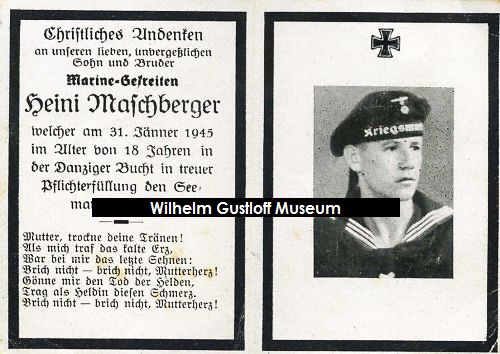
Christian Memory (Rememberance)
of our dear, unforgettable
Son and brother
Marine Corporal
(Heinrich) Heini Maschberger
which on 31 January 1945
at the age of 18 years in the Gulf of Gdansk is mourned in passing in the faithful duty of sailor.
Mother dry your tears!
When I met the wrinkled ore
Was with me in the last chord:
Do not break - not, break your mother's heart!
I'm gone to the death of the hero,
Bear as a heroine this pain.
Do not break - not, break your mother's heart!
of our dear, unforgettable
Son and brother
Marine Corporal
(Heinrich) Heini Maschberger
which on 31 January 1945
at the age of 18 years in the Gulf of Gdansk is mourned in passing in the faithful duty of sailor.
Mother dry your tears!
When I met the wrinkled ore
Was with me in the last chord:
Do not break - not, break your mother's heart!
I'm gone to the death of the hero,
Bear as a heroine this pain.
Do not break - not, break your mother's heart!
Wilhelm Gustloff Death Card from sinking:
Heinrich Maschberger is listed as 'Seemanstod' or 'Seemannstod' as on the card (Accidental death) in the Gulf of Gdansk. He was in all likelihood one of 918 Marines and U-Boat members from 2nd U-Boat Training Division that went down with the Wilhelm Gustloff since no other ships were known to be sunk on the 31st in the Baltic. Dated the day after the sinking.
Heinrich Maschberger is listed as 'Seemanstod' or 'Seemannstod' as on the card (Accidental death) in the Gulf of Gdansk. He was in all likelihood one of 918 Marines and U-Boat members from 2nd U-Boat Training Division that went down with the Wilhelm Gustloff since no other ships were known to be sunk on the 31st in the Baltic. Dated the day after the sinking.
Wilhelm Gustloff Life rings / Life Preservers
Reproduction life rings, most often associated with the sinking of the ship.
Two variations of the life ring were known to have been used on board - the differences lie within the lettering of the ship's name around the top. For one example, the 'ff' in Gustloff can be connected or separated. Shows signs of aging - paint loss around the rope handles, one can tell it has been painted more than once on both sides over the years and repairs have been made to it. Usual cracking and bumps / dents. There are no known original life rings that survived the sinking.
The first red and white life ring is a prop from the 2008 movie "Die Gustloff". The second white life ring is a reproduction created in the style of those used in the Gustloff movies. Below: The first photo of it was ripped off my website to be manipulated and used for the 2020 Sierra Leone 75th Anniversary of the Sinking of the Wilhelm Gustloff stamps in Africa. The Donald Duck cap & tally photo was also taken from the souvenir page and used without permission.
Reproduction life rings, most often associated with the sinking of the ship.
Two variations of the life ring were known to have been used on board - the differences lie within the lettering of the ship's name around the top. For one example, the 'ff' in Gustloff can be connected or separated. Shows signs of aging - paint loss around the rope handles, one can tell it has been painted more than once on both sides over the years and repairs have been made to it. Usual cracking and bumps / dents. There are no known original life rings that survived the sinking.
The first red and white life ring is a prop from the 2008 movie "Die Gustloff". The second white life ring is a reproduction created in the style of those used in the Gustloff movies. Below: The first photo of it was ripped off my website to be manipulated and used for the 2020 Sierra Leone 75th Anniversary of the Sinking of the Wilhelm Gustloff stamps in Africa. The Donald Duck cap & tally photo was also taken from the souvenir page and used without permission.
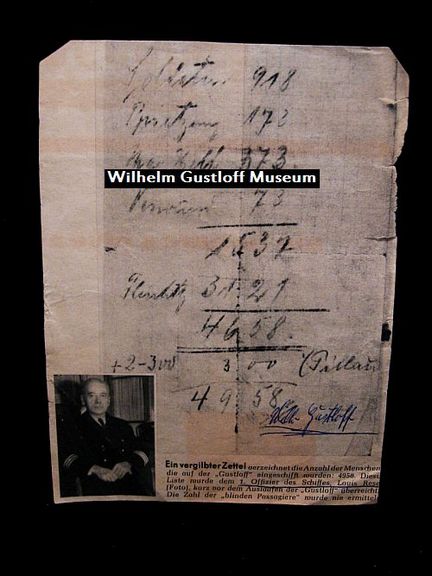
By all historical accounts, the tally of the people which were officially embarked on the Wilhelm Gustloff on 1/30/45 stopped around 5,000. This is a period newspaper clipping with a photograph of the actual list from that fateful day. The tally translates:
Soldaten (Soldiers) 918
**(The 918 soldiers mentioned were all from the 2. U-Boot-Lehrdivision and should have been brought to Kiel to fight on.)
Besatzung (crew) 172
Mar. Helfer (abbreviation for marine volunteer) 373
Verwund (abbreviation for wounded people) 73
---------
1537
Flüchtl (Abb. for refugee) 3121
---------
4658
+2-300 (An additional 200 to 300 / from) Pillau (Village in former Ostpreussen)
Wilh. Gustloff is written in blue pen on the paper. The article at the bottom translates:
"A yellowed slip of shows the number of people carried on the Gustloff: 4,958. This list was handed over by the First officer, Louis Reese, (Photo) shortly before the Gustloff's departure. The number of stowaways was never determined."
A lesser known fact was that the printer aboard the ship, Jeisle, printed some 10,000 meal ticket to be issued to the refugees for food during the voyage. Navy Nurse Waldemar Terres reported that by January 29th at 5pm, 7,956 meal tickets were issued. The additional 2,000 were distributed afterwards, but their count was not kept.
Soldaten (Soldiers) 918
**(The 918 soldiers mentioned were all from the 2. U-Boot-Lehrdivision and should have been brought to Kiel to fight on.)
Besatzung (crew) 172
Mar. Helfer (abbreviation for marine volunteer) 373
Verwund (abbreviation for wounded people) 73
---------
1537
Flüchtl (Abb. for refugee) 3121
---------
4658
+2-300 (An additional 200 to 300 / from) Pillau (Village in former Ostpreussen)
Wilh. Gustloff is written in blue pen on the paper. The article at the bottom translates:
"A yellowed slip of shows the number of people carried on the Gustloff: 4,958. This list was handed over by the First officer, Louis Reese, (Photo) shortly before the Gustloff's departure. The number of stowaways was never determined."
A lesser known fact was that the printer aboard the ship, Jeisle, printed some 10,000 meal ticket to be issued to the refugees for food during the voyage. Navy Nurse Waldemar Terres reported that by January 29th at 5pm, 7,956 meal tickets were issued. The additional 2,000 were distributed afterwards, but their count was not kept.
Gerhard Graßhoff - Survivor of the Wilhelm Gustloff Disaster
These documents were discovered in a large binder of paperwork recently purchased from Germany on the ship. Photos at left of survivor Gerhard Grasshoff and the interview done by Vanessa Philipp and Lisa Schiefner on March 6th, 2008.
"Wilhelm Gustloff" : From the Flagship to the Iron Coffin.
Interview: Gerhard Grasshoff (86):
Gerhard was born in 1922 in Uichteritz
These documents were discovered in a large binder of paperwork recently purchased from Germany on the ship. Photos at left of survivor Gerhard Grasshoff and the interview done by Vanessa Philipp and Lisa Schiefner on March 6th, 2008.
"Wilhelm Gustloff" : From the Flagship to the Iron Coffin.
Interview: Gerhard Grasshoff (86):
Gerhard was born in 1922 in Uichteritz

Alexander Ivanovich Marinesko (Russian: Александр Иванович Маринеско) (January 15, 1913 - November 25, 1963) was a Soviet naval officer and during World War II, the captain of the S-13 submarine, which sank the German ship Wilhelm Gustloff, with recent research showing that over 9,000 died when the ship sank.
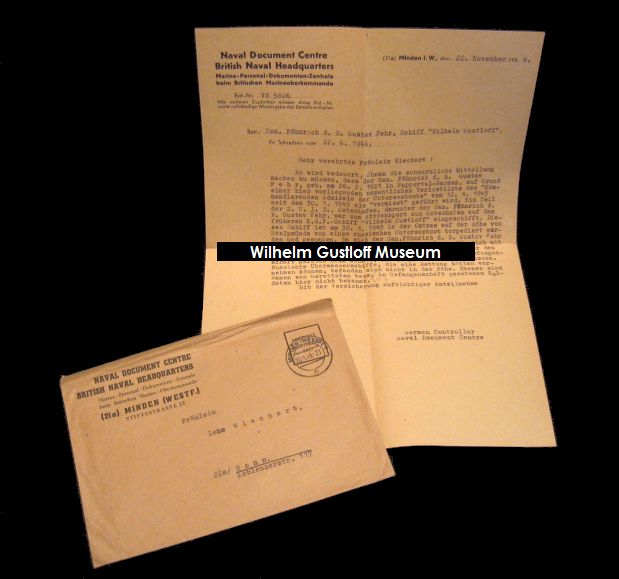
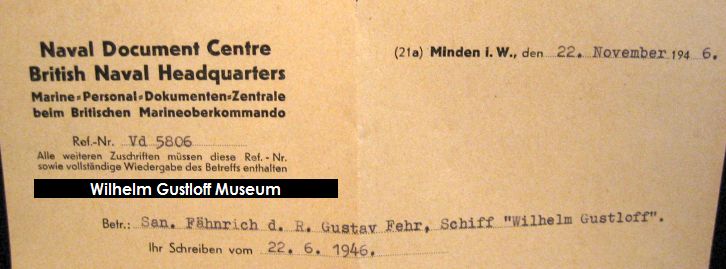
Letter from the Naval Document Centre, British Naval Headquarters
A letter to Mrs. Wiechert that her relative was lost with the Wilhelm Gustloff
English translation at right top
Original German transcription at right below.
A special thank you to Werner Hinke for translating this document for me!
A letter to Mrs. Wiechert that her relative was lost with the Wilhelm Gustloff
English translation at right top
Original German transcription at right below.
A special thank you to Werner Hinke for translating this document for me!
Naval Document Centre (21a) Minden i.W., den November 22nd, 1946.
British Naval Headquarters
Navy - Personnel - Documents - Central
At the British Navy High Command
Ref-Nr. Vd 5806
All further correspondence must include this
Ref. Num. as well as the complete reference.
Re:.San Ensign d.R. Gustav Fehr, ship "Wilhelm Gustloff"
Your letter dated 22.6.1946
Dear Miss Wiechert!
It is with sadness, that we need to make this painful notification. San. Ensign d.R. Gustav Fehr, born on 26.2.1921 in Wuppertal-Barmen, has been listed as "missing " as of the 30.1.1945. The Commanding Admiral of the U-boats has included his name on the list of missing persons on 12.4.45. We have reviewed this list. Some of the members of the 2. U.L.D., among them San Ensign d.R. Gustav Fehr, boarded the former K.d.F.ship "Wilhelm Gustloff". This ship was torpedoed on 31.1.45 by a Russian submarine and sank near Stolpemünde in the Baltic Sea. San Ensign Gustav Fehr was not among the survivors. You must therefore accept the idea that he is no longer among the living. The possibility of him becoming a Russian prisoner is non existent. There were no Russian surface ships in the vicinity. We have no record of soldiers rescued or imprisoned by the Russians.
With the assurance of our sincere sympathy.
German Controller
Naval Document Centre
British Naval Headquarters
Navy - Personnel - Documents - Central
At the British Navy High Command
Ref-Nr. Vd 5806
All further correspondence must include this
Ref. Num. as well as the complete reference.
Re:.San Ensign d.R. Gustav Fehr, ship "Wilhelm Gustloff"
Your letter dated 22.6.1946
Dear Miss Wiechert!
It is with sadness, that we need to make this painful notification. San. Ensign d.R. Gustav Fehr, born on 26.2.1921 in Wuppertal-Barmen, has been listed as "missing " as of the 30.1.1945. The Commanding Admiral of the U-boats has included his name on the list of missing persons on 12.4.45. We have reviewed this list. Some of the members of the 2. U.L.D., among them San Ensign d.R. Gustav Fehr, boarded the former K.d.F.ship "Wilhelm Gustloff". This ship was torpedoed on 31.1.45 by a Russian submarine and sank near Stolpemünde in the Baltic Sea. San Ensign Gustav Fehr was not among the survivors. You must therefore accept the idea that he is no longer among the living. The possibility of him becoming a Russian prisoner is non existent. There were no Russian surface ships in the vicinity. We have no record of soldiers rescued or imprisoned by the Russians.
With the assurance of our sincere sympathy.
German Controller
Naval Document Centre
Naval Document Centre (21a) Minden i.W., den November 22nd, 1946.
British Naval Headquarters
Marine - Personal - Dokumenten - Zentrale
beim Britischen Marineoberkommando
Ref-Nr. Vd 5806
Alle weiteren Zuschriften müssen diese Ref-Nr.
sowie vollständige Wiedergabe des Betreffs enthalten
Betr.: San. Fähnrich d. R. Gustav Fehr, Schiff "Wilhelm Gustloff"
Ihr Schreiben vom 22.6.1946.
Sehr verehrtes Fräulein Wiechert!
Es wird bedauert, Ihnen die schmerzliche Mitteilung machen zu müssen, dass der San. Fähnrich d. R. Gustav Fehr, geb. am 26.2.1921 in Wuppertal-Barmen, auf Grund mandierenden Admirals der Unterseeboote" vom 12.4.1945 seit dem 30.1.1945 als "vermisst" geführt wird. Ein Teil der 2.U.L.D., Gotenhafen, darunter der San. Fähnrich d. früheren K.d.F. - Schiff "Wilhelm Gustloff"eingeschifft. Dieses Schiff ist am 30.1.1945 in der Ostsee auf der Höhe von Stolpmünde von einem russischen Unterseeboot torpediert worden und gesunken. Da sich der San. Fähnrich d.R. Gustav Fehr nicht unter den geretteten befunden hat, müssen Sie sich mit dem gedanken vertraut machen, dass er nicht mehr unter den Lebenden weilt. Die Möglichkeit, dass er in russische Gefangen schaft geraten sein könnte, ist so gut wie ausgeschlossen. Russische Überwassweschiffe, die eine Rettung hätten vornehmen können, befanden sich nicht in der Nähe. Ebenso sind Namen von Geretteten bezw. in Gefangenschaft geratenen Soldaten heir nicht bekannt. Mit der Versicherung aufrichtiger Anteilnahme.
German Controller
Naval Document Centre
British Naval Headquarters
Marine - Personal - Dokumenten - Zentrale
beim Britischen Marineoberkommando
Ref-Nr. Vd 5806
Alle weiteren Zuschriften müssen diese Ref-Nr.
sowie vollständige Wiedergabe des Betreffs enthalten
Betr.: San. Fähnrich d. R. Gustav Fehr, Schiff "Wilhelm Gustloff"
Ihr Schreiben vom 22.6.1946.
Sehr verehrtes Fräulein Wiechert!
Es wird bedauert, Ihnen die schmerzliche Mitteilung machen zu müssen, dass der San. Fähnrich d. R. Gustav Fehr, geb. am 26.2.1921 in Wuppertal-Barmen, auf Grund mandierenden Admirals der Unterseeboote" vom 12.4.1945 seit dem 30.1.1945 als "vermisst" geführt wird. Ein Teil der 2.U.L.D., Gotenhafen, darunter der San. Fähnrich d. früheren K.d.F. - Schiff "Wilhelm Gustloff"eingeschifft. Dieses Schiff ist am 30.1.1945 in der Ostsee auf der Höhe von Stolpmünde von einem russischen Unterseeboot torpediert worden und gesunken. Da sich der San. Fähnrich d.R. Gustav Fehr nicht unter den geretteten befunden hat, müssen Sie sich mit dem gedanken vertraut machen, dass er nicht mehr unter den Lebenden weilt. Die Möglichkeit, dass er in russische Gefangen schaft geraten sein könnte, ist so gut wie ausgeschlossen. Russische Überwassweschiffe, die eine Rettung hätten vornehmen können, befanden sich nicht in der Nähe. Ebenso sind Namen von Geretteten bezw. in Gefangenschaft geratenen Soldaten heir nicht bekannt. Mit der Versicherung aufrichtiger Anteilnahme.
German Controller
Naval Document Centre
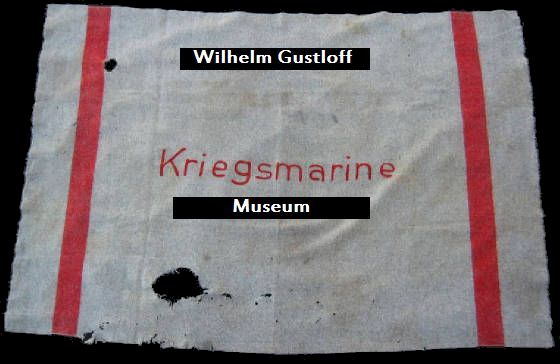
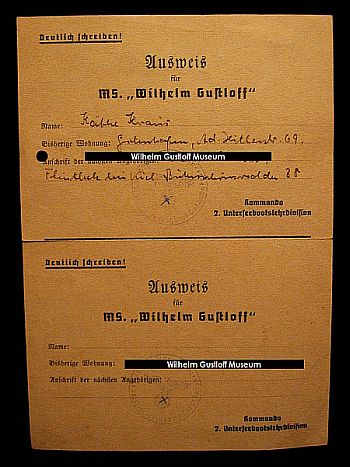
Original Boarding Passes for the Wilhelm Gustloff's Last Voyage
Operation Hannibal - January 30th, 1945.
Of the several hundred boarding passes that were the last thing to be printed from the Gustloff's on board printing press, only 5 are known to still exist. Presented here are two of these five original boarding passes for the Wilhelm Gustloff. Even better is that their story also survived the test of time.
Käthe Kraus, of Adolf Hitler-Strasse 69 in Gotenhafen, was a member of the Kriegsmarine working as a naval aid. In 1945 at the age of 38, she was issued these boarding passes for passage West on the Wilhelm Gustloff. However, due to the amount of 'top secret' paperwork that the Germans were trying to destroy, she recalled how she decided to stay behind to help with the task and take a liner that was leaving at a later date. This saved her life and these extraordinary pieces of history.
After the Wilhelm Gustloff sank, her tasks were finished and she gained passage 2 days later on February 2nd, 1945 on board the H.K.S. Vega leaving Gotenhafen. Her ausweis and 'special pass' from the Vega also survived and are shown below as part of our collection. In her later years living in Kiel, she became friends with her neighbor who was a WWII military collector specializing in minesweepers. Before moving away from Kiel, Mrs. Kraus gave B.W. (military collector name witheld for privacy) these documents for his collection and told him the story I wrote above. In late 2012, I was able to discover that B.W. had these documents still in his collection. After deciding to part with them to 'thin out' non-minesweeper items, I arranged to have them transferred to the Wilhelm Gustloff Museum.
The 1/30/45 ausweis is one of the few items from the Wilhelm Gustloff that are made as official reproductions. I have seen at least one where the bottom was cut off and it was sold as an 'original'. The bottom left has 'Faksimile Edition' (Reproduction Edition); followed by the document number and information. In order to cut off this reproduction giveaway, one would also have to cut off '2. Unterseebootslehrdivision' to get a clean straight cut. I also have one of these reproductions in the collection.
Operation Hannibal - January 30th, 1945.
Of the several hundred boarding passes that were the last thing to be printed from the Gustloff's on board printing press, only 5 are known to still exist. Presented here are two of these five original boarding passes for the Wilhelm Gustloff. Even better is that their story also survived the test of time.
Käthe Kraus, of Adolf Hitler-Strasse 69 in Gotenhafen, was a member of the Kriegsmarine working as a naval aid. In 1945 at the age of 38, she was issued these boarding passes for passage West on the Wilhelm Gustloff. However, due to the amount of 'top secret' paperwork that the Germans were trying to destroy, she recalled how she decided to stay behind to help with the task and take a liner that was leaving at a later date. This saved her life and these extraordinary pieces of history.
After the Wilhelm Gustloff sank, her tasks were finished and she gained passage 2 days later on February 2nd, 1945 on board the H.K.S. Vega leaving Gotenhafen. Her ausweis and 'special pass' from the Vega also survived and are shown below as part of our collection. In her later years living in Kiel, she became friends with her neighbor who was a WWII military collector specializing in minesweepers. Before moving away from Kiel, Mrs. Kraus gave B.W. (military collector name witheld for privacy) these documents for his collection and told him the story I wrote above. In late 2012, I was able to discover that B.W. had these documents still in his collection. After deciding to part with them to 'thin out' non-minesweeper items, I arranged to have them transferred to the Wilhelm Gustloff Museum.
The 1/30/45 ausweis is one of the few items from the Wilhelm Gustloff that are made as official reproductions. I have seen at least one where the bottom was cut off and it was sold as an 'original'. The bottom left has 'Faksimile Edition' (Reproduction Edition); followed by the document number and information. In order to cut off this reproduction giveaway, one would also have to cut off '2. Unterseebootslehrdivision' to get a clean straight cut. I also have one of these reproductions in the collection.
Photo Gallery at right:
1: The two ausweise for the Wilhelm Gustloff. The first for Mrs. Klaus, the second blank. Both stamped.
2: A close-up of Mrs. Klaus' ausweis that never made it back on board the doomed liner.
3: An aerial view of Gotenhafen 12/21/1944. The Wilhelm Gustloff is visible on the left south of the Hansa at the harbor entrance. Her bow is pointing NNE.
4: A color photo of the H.K.S. Vega in Gotenhafen in 1942 with 3 type VIIC-boats and the type IXA boat U-37. In her camouflage paint, this was the ship that Mrs. Kraus escaped Gotenhafen on. There was some issue as to if this ship was renamed the 'Wega' under Kriegsmarine control, but she is clearly the 'Vega' on her ausweis. The liner was later bombed on May 3rd, 1945. To see her history, click HERE.
5: The ausweis for Käthe Kraus on board the H.K.S. Vega.
6: The special pass or 'marching orders for business trip' pass. February 2nd, 1945 for passage to Kiel.
7: Back of the special pass.
8: Signature of the Kriegsmarine Kapitänleutnant (AMD) u. Adjutant.
1: The two ausweise for the Wilhelm Gustloff. The first for Mrs. Klaus, the second blank. Both stamped.
2: A close-up of Mrs. Klaus' ausweis that never made it back on board the doomed liner.
3: An aerial view of Gotenhafen 12/21/1944. The Wilhelm Gustloff is visible on the left south of the Hansa at the harbor entrance. Her bow is pointing NNE.
4: A color photo of the H.K.S. Vega in Gotenhafen in 1942 with 3 type VIIC-boats and the type IXA boat U-37. In her camouflage paint, this was the ship that Mrs. Kraus escaped Gotenhafen on. There was some issue as to if this ship was renamed the 'Wega' under Kriegsmarine control, but she is clearly the 'Vega' on her ausweis. The liner was later bombed on May 3rd, 1945. To see her history, click HERE.
5: The ausweis for Käthe Kraus on board the H.K.S. Vega.
6: The special pass or 'marching orders for business trip' pass. February 2nd, 1945 for passage to Kiel.
7: Back of the special pass.
8: Signature of the Kriegsmarine Kapitänleutnant (AMD) u. Adjutant.
Wilhelm Gustloff Ausweis:
Deutsch schreiben!
Ausweis für MS. "Wilhelm Gustloff"
Name: Käthe Kraus
Bisherige Wohnung: Gotenhafen, Adolf Hitler-Strasse 69
Anschrift der nächsten Angehörigen: Albert Kraus, Butenschönsredder, Flintbek bei Kiel
Kommando
2. Unterseebootslehrdivision
German post!
Pass for MS. "Wilhelm Gustloff"
Name: Käthe Kraus
Previous residence: Gotenhafen, Adolf Hitler-Strasse 69
Address of next of kin: (Yet to be translated)
Command
Second Submarine Training Division
Deutsch schreiben!
Ausweis für MS. "Wilhelm Gustloff"
Name: Käthe Kraus
Bisherige Wohnung: Gotenhafen, Adolf Hitler-Strasse 69
Anschrift der nächsten Angehörigen: Albert Kraus, Butenschönsredder, Flintbek bei Kiel
Kommando
2. Unterseebootslehrdivision
German post!
Pass for MS. "Wilhelm Gustloff"
Name: Käthe Kraus
Previous residence: Gotenhafen, Adolf Hitler-Strasse 69
Address of next of kin: (Yet to be translated)
Command
Second Submarine Training Division
Ausweis Nr. 333 für H.K.S. Vega
Herr/Frau Erl. / Kind (Name) (Vorname) - Käthe Kraus
Alter: 38
Bisherige Vohnung: Gotenhafen, Adolf Hitler-Straße 69
Anschrift der näch-sten Angehörigen: Albert Kraus, Butenschönsredder in Flintbek bei Kiel
Inhaber dieses Ausweises ist berechtigt, das Kriegshafengelände zwecks Einschiffung auf H.K.S. "Vega" zu betreten.
Kommando H.K.S. "Vega"
Verpflegungskarte: Datum morg. / mitt. / abds.
ID No. 333 for H.K.S. Vega
Mr / Ms
Erl / child (name) (first name) - Käthe Kraus
Age: 38
Existing Vohnung: Gdynia, Adolf Hitler-Strasse 69
Address of the next few members:
Holder of this certificate is entitled to the port area for the purpose of embarking on war HKS "Vega" to enter.
Command H.K.S. "Vega"
Catering Menu: Date morg. / Mitt. / Abds
Herr/Frau Erl. / Kind (Name) (Vorname) - Käthe Kraus
Alter: 38
Bisherige Vohnung: Gotenhafen, Adolf Hitler-Straße 69
Anschrift der näch-sten Angehörigen: Albert Kraus, Butenschönsredder in Flintbek bei Kiel
Inhaber dieses Ausweises ist berechtigt, das Kriegshafengelände zwecks Einschiffung auf H.K.S. "Vega" zu betreten.
Kommando H.K.S. "Vega"
Verpflegungskarte: Datum morg. / mitt. / abds.
ID No. 333 for H.K.S. Vega
Mr / Ms
Erl / child (name) (first name) - Käthe Kraus
Age: 38
Existing Vohnung: Gdynia, Adolf Hitler-Strasse 69
Address of the next few members:
Holder of this certificate is entitled to the port area for the purpose of embarking on war HKS "Vega" to enter.
Command H.K.S. "Vega"
Catering Menu: Date morg. / Mitt. / Abds
Letter written by a sailor fleeing Gotenhafen - 26.2.1945
Written by Sali Gedig to Adolf Stolz
Sali was on board another ship fleeing the port of Gotenhafen under heavy escort with 14,000 on board! He mentions the Gustloff sinking in his letter to portray the fears of having so many on a single ship....
"Wir hatten ein starkes Geleit mit. Es waren 14000 Menschen oben. Kannst Dir ja den Kasten vorstellen. Vor uns war die Gustloff untergegangen da waren oben 8000 Menschen. Kannst Dir unsere Stimmung vorstellen."
"We had a strong escort with us, 14,000 people were on the decks, so you can imagine the size of the ship. The Gustloff had gone down before us and they had 8,000 people on the top (decks). Imagine our mood."
A special thank you to Werner Hinke for translating this for me.
Written by Sali Gedig to Adolf Stolz
Sali was on board another ship fleeing the port of Gotenhafen under heavy escort with 14,000 on board! He mentions the Gustloff sinking in his letter to portray the fears of having so many on a single ship....
"Wir hatten ein starkes Geleit mit. Es waren 14000 Menschen oben. Kannst Dir ja den Kasten vorstellen. Vor uns war die Gustloff untergegangen da waren oben 8000 Menschen. Kannst Dir unsere Stimmung vorstellen."
"We had a strong escort with us, 14,000 people were on the decks, so you can imagine the size of the ship. The Gustloff had gone down before us and they had 8,000 people on the top (decks). Imagine our mood."
A special thank you to Werner Hinke for translating this for me.
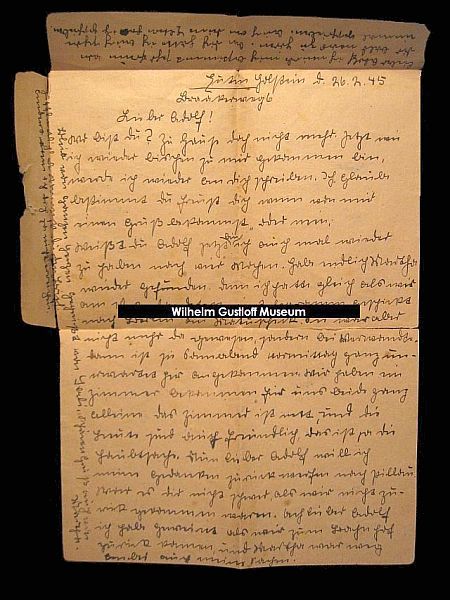
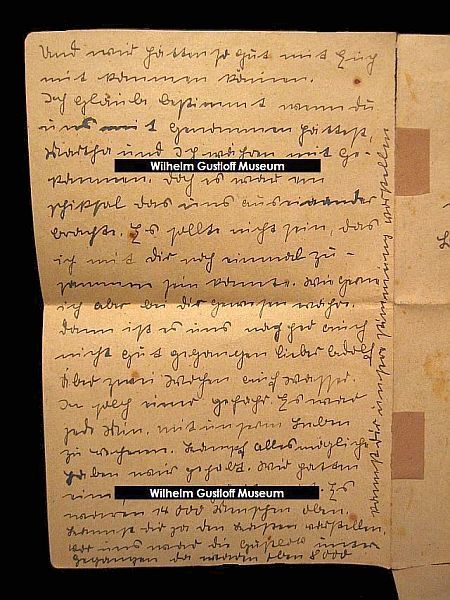
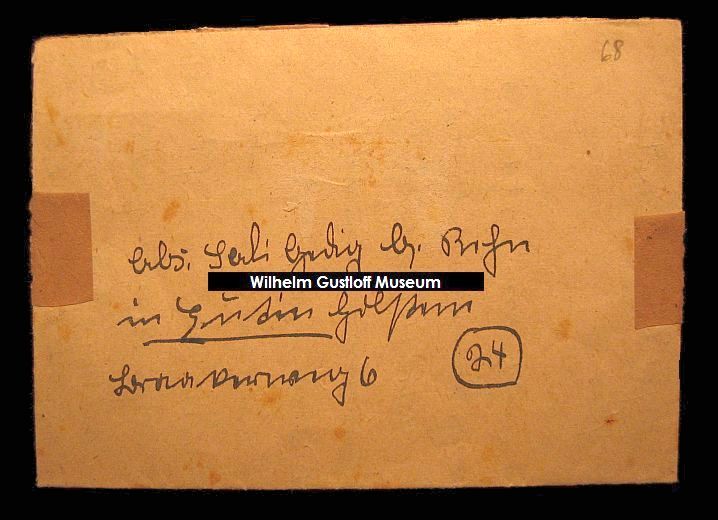
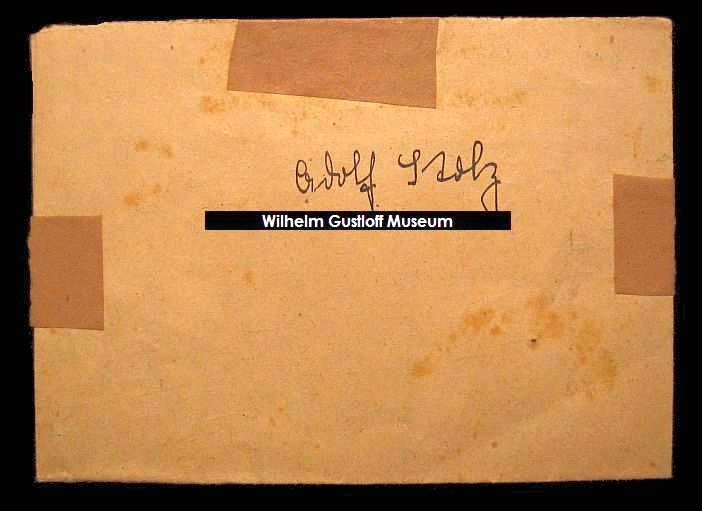
Letter written by Wilhelm Gustloff survivor Egon Jelsen - Civilian crew member.
Written from his hospital bed in Köslin - February 4th, 1945.
Translated by Werner Hinke.
*The first note is that Egon probably refers to being on board the Minensuchboot M375 or Minensuchboot M341 while being rescued.
*It is also interesting how Egon writes that the Wilhelm Gustloff is still in her Red Cross livery, when she has been painted her war gray for the past 4 years. However, recalling details can always be inaccurate or subjective in the shock of such an event. It has been said that many in Germany from the time up to today still believe today the ship set sail in her hospital livery.
Dear Rhoda,
Now we can thank God, I am safe. I wrote to you on January 20th from Gotenhafen that we intended to ship ourselves in on the Wilhelm Gustloff. We did this but in the same night, the ship was torpedoed by an enemy submarine. What happened then was hell in itself. I can hardly remember how I got into a lifeboat and then onto a fast PT boat. There were 40 on this boat taken to the nearest harbor and from there we went to a hospital in Köslin. I remember the Wilhelm Gustloff was overcrowded, the whole deck was occupied with people and when the ship went down, most of them must have drowned in the icy water. How many is anyone's guess. There are 70 survivors here in Köslin, most with frostbites and related things. The Wilhelm Gustloff was a hospital ship and marked as such, sure, there were also wounded soldiers onboard but nobody I have seen with any sort of arms. I cannot say yet whether Lina was rescued - nobody has shown us a passenger list yet.
What will happen now? I want to get out of here as fast as possible and go to Stettin. Right now that is impossible as there is a travel restriction on all passengers. Why?? I think the world should know what a cowardly deed it was to sink a marked Red Cross ship with thousands of women and children. This sort of thing should be made known and not kept secret. I just don't know whether I will ever find my way around in this world. I will try and forget, and when I get to Stettin, I will try to write again. Meanwhile I am here and I don't even own the gown I wear, but I thank God I am alive. I hope for the best. Uncle Egon.
Written from his hospital bed in Köslin - February 4th, 1945.
Translated by Werner Hinke.
*The first note is that Egon probably refers to being on board the Minensuchboot M375 or Minensuchboot M341 while being rescued.
*It is also interesting how Egon writes that the Wilhelm Gustloff is still in her Red Cross livery, when she has been painted her war gray for the past 4 years. However, recalling details can always be inaccurate or subjective in the shock of such an event. It has been said that many in Germany from the time up to today still believe today the ship set sail in her hospital livery.
Dear Rhoda,
Now we can thank God, I am safe. I wrote to you on January 20th from Gotenhafen that we intended to ship ourselves in on the Wilhelm Gustloff. We did this but in the same night, the ship was torpedoed by an enemy submarine. What happened then was hell in itself. I can hardly remember how I got into a lifeboat and then onto a fast PT boat. There were 40 on this boat taken to the nearest harbor and from there we went to a hospital in Köslin. I remember the Wilhelm Gustloff was overcrowded, the whole deck was occupied with people and when the ship went down, most of them must have drowned in the icy water. How many is anyone's guess. There are 70 survivors here in Köslin, most with frostbites and related things. The Wilhelm Gustloff was a hospital ship and marked as such, sure, there were also wounded soldiers onboard but nobody I have seen with any sort of arms. I cannot say yet whether Lina was rescued - nobody has shown us a passenger list yet.
What will happen now? I want to get out of here as fast as possible and go to Stettin. Right now that is impossible as there is a travel restriction on all passengers. Why?? I think the world should know what a cowardly deed it was to sink a marked Red Cross ship with thousands of women and children. This sort of thing should be made known and not kept secret. I just don't know whether I will ever find my way around in this world. I will try and forget, and when I get to Stettin, I will try to write again. Meanwhile I am here and I don't even own the gown I wear, but I thank God I am alive. I hope for the best. Uncle Egon.
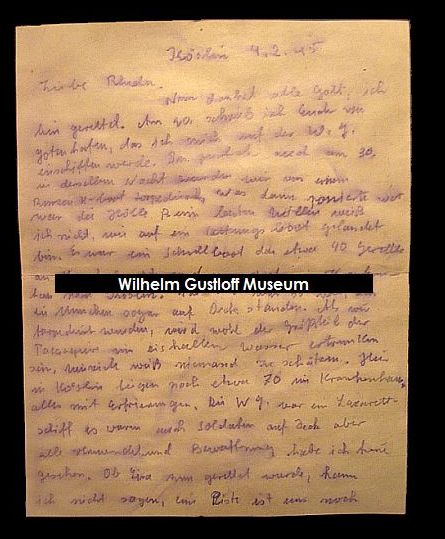
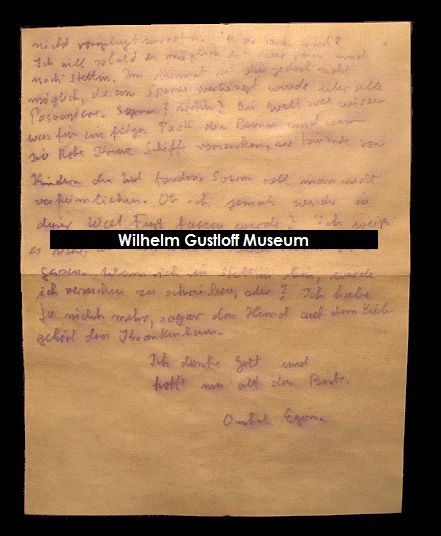
Wilhelm
Gustloff Wreck Keys
I purchased this from a well-known nautical collector in Germany who specializes in selling HAPAG memorabilia. In addition to the many other German nautical pieces he sells, I purchased two of these keys off of him. An identical key to these sold on March 22nd, 2014 among the 300 lots at the Atlantic Crossing Auctions in Southampton, England:
Lot 109 Wilhelm Gustloff, A ships key approx. 4 inches long with looped pinch grip handle and circular engineered barrel. Steel manufacture and tempered at one time. The key was recovered from the wreck of the Gustloff on a salvage dive c 1994 forty nine years after her sinking and is in fine condition with obvious salt water marks. Good (Shown at right with the red background from the auction catalog.)
These were originally purchased in Wismar in 1994 along with 2 other keys and 2 spoons from the wreck of the Wilhelm Gustloff. The seller also told me he had the opportunity to purchase a porthole from the Wilhelm Gustloff by the diver, but could not afford it at the time. How I wish I could've purchased that for the museum collection! The last photo is from a period Arbeitertum showing the same keys and locks they belonged to.
I purchased this from a well-known nautical collector in Germany who specializes in selling HAPAG memorabilia. In addition to the many other German nautical pieces he sells, I purchased two of these keys off of him. An identical key to these sold on March 22nd, 2014 among the 300 lots at the Atlantic Crossing Auctions in Southampton, England:
Lot 109 Wilhelm Gustloff, A ships key approx. 4 inches long with looped pinch grip handle and circular engineered barrel. Steel manufacture and tempered at one time. The key was recovered from the wreck of the Gustloff on a salvage dive c 1994 forty nine years after her sinking and is in fine condition with obvious salt water marks. Good (Shown at right with the red background from the auction catalog.)
These were originally purchased in Wismar in 1994 along with 2 other keys and 2 spoons from the wreck of the Wilhelm Gustloff. The seller also told me he had the opportunity to purchase a porthole from the Wilhelm Gustloff by the diver, but could not afford it at the time. How I wish I could've purchased that for the museum collection! The last photo is from a period Arbeitertum showing the same keys and locks they belonged to.
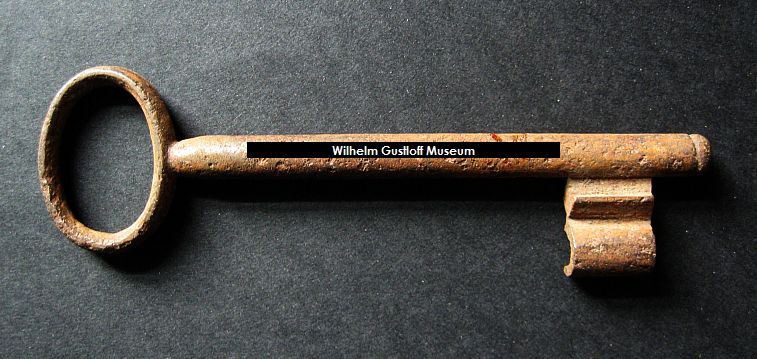
Sinking of the Wilhelm Gustloff - January 30th, 1945
List of dead, missing, and survivors by Heinz Schön
Much of the information we know today from the Wilhelm Gustloff is through the efforts of Heinz Schön, who was on board the Wilhelm Gustloff and survived her sinking. Interviewing witnesses and survivors, he began the Gustloff Archive and in 1952 published "The Sinking of the Wilhelm Gustloff".
Very few people realize that through his efforts, there is an incomplete list of those who were missing, died, and survived the sinking that night. While published in his works in Germany, I wanted to share his lists here for those who are seeking information on loved ones or family that were on board that fateful night. Heinz died on April 7th, 2013 and his ashes were laid to rest on the wreck on May 10th.
List of dead, missing, and survivors by Heinz Schön
Much of the information we know today from the Wilhelm Gustloff is through the efforts of Heinz Schön, who was on board the Wilhelm Gustloff and survived her sinking. Interviewing witnesses and survivors, he began the Gustloff Archive and in 1952 published "The Sinking of the Wilhelm Gustloff".
Very few people realize that through his efforts, there is an incomplete list of those who were missing, died, and survived the sinking that night. While published in his works in Germany, I wanted to share his lists here for those who are seeking information on loved ones or family that were on board that fateful night. Heinz died on April 7th, 2013 and his ashes were laid to rest on the wreck on May 10th.
Wilhelm Gustloff Death Card from sinking #2:
Jesus! † Maria! † Joseph!
Be ready because you do not know the day nor the hour when the Lord will come†
To the pious memory of our dear
Gertrud Schmitt born Herings
which sank on the 30th of January 1945, at ten o'clock pm, with the Wilhelm Gustloff
just before Collberg
The dear deceased was born on March 21, 1921,
and married on the March 27th, 1943 with Hans Schmitt to a happy marriage.
She had a loving heart especially for the poor,
so we hope that she has found a gracious judge above.
Their mourning relatives ask for a prayer for the dear deceased
so that she may soon rest in eternal peace.
Jesus! † Maria! † Joseph!
Be ready because you do not know the day nor the hour when the Lord will come†
To the pious memory of our dear
Gertrud Schmitt born Herings
which sank on the 30th of January 1945, at ten o'clock pm, with the Wilhelm Gustloff
just before Collberg
The dear deceased was born on March 21, 1921,
and married on the March 27th, 1943 with Hans Schmitt to a happy marriage.
She had a loving heart especially for the poor,
so we hope that she has found a gracious judge above.
Their mourning relatives ask for a prayer for the dear deceased
so that she may soon rest in eternal peace.

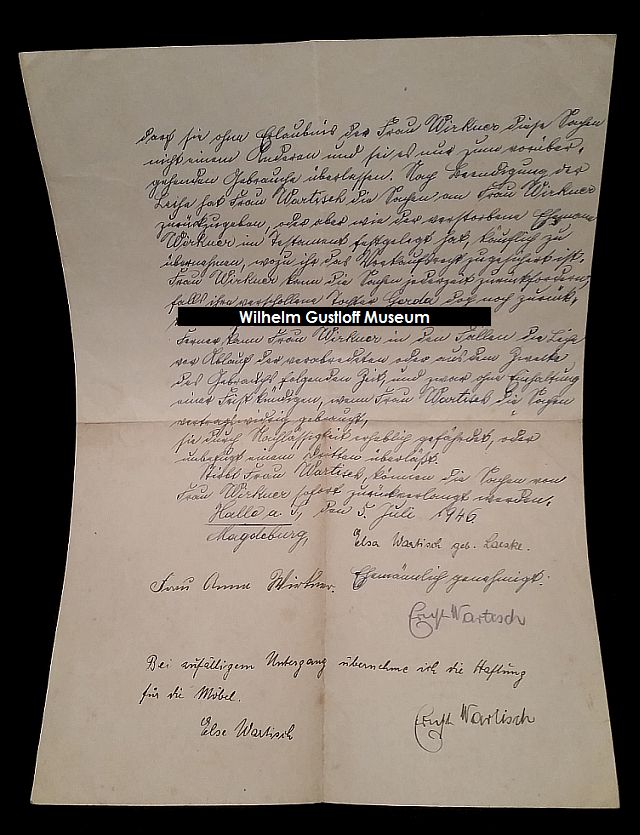
Loan Agreement (Leihvertrag) from July 5th, 1946.
*Thanks to Werner Hinke for translating as always! Excerpts from the letter below:
"We the above named hereby set down the following 'rent' contract. Ms. Anna Wirkner hands over to Ms. Else Wartisch the following things, used, that belonged to the step daughter Gerda Wirkner missing since the sinking of the ship Gustloff.
1 Dining room (giving an inventory)
1 Bedroom ( giving an inventory) ...."
At the end of the letter:
"In the case of the accidental sinking I take the responsibility (liability) for the furniture."
Signed by Else Wartisch and Ernst Wartisch
*Thanks to Werner Hinke for translating as always! Excerpts from the letter below:
"We the above named hereby set down the following 'rent' contract. Ms. Anna Wirkner hands over to Ms. Else Wartisch the following things, used, that belonged to the step daughter Gerda Wirkner missing since the sinking of the ship Gustloff.
1 Dining room (giving an inventory)
1 Bedroom ( giving an inventory) ...."
At the end of the letter:
"In the case of the accidental sinking I take the responsibility (liability) for the furniture."
Signed by Else Wartisch and Ernst Wartisch
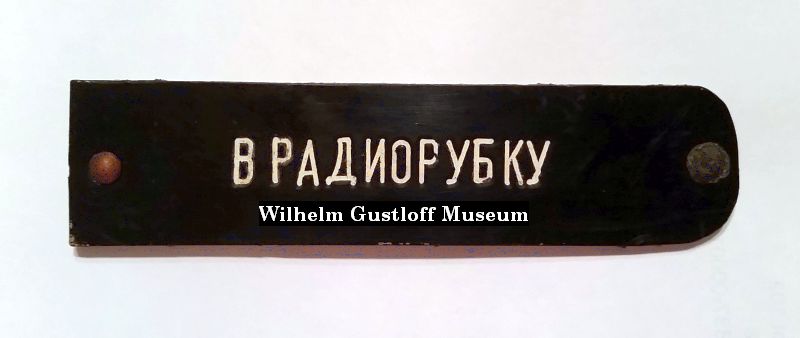
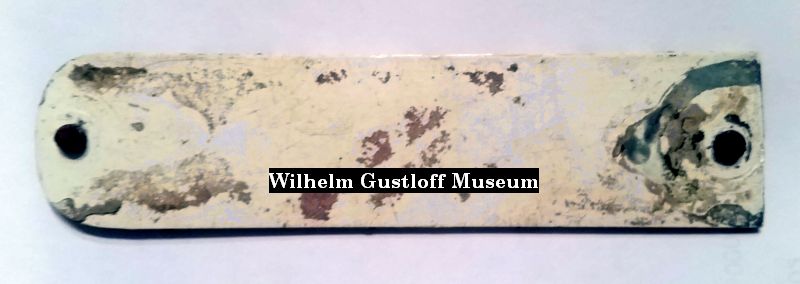
"Radio Room" door plaque from Alexander Marinesko's S-13 Submarine
I came across this piece online from a military collector in Latvia in 2016. Among the other WWII items he was selling, he had this listed as the radio room sign from the Soviet submarine S-13. I had tried to do some research on the S-13, but I was unable to find any information about her scrapping other than her stricken date of 12/17/1956. Since the price wasn't too high, I decided to go for it since he was able to provide a handwritten story to accompany the piece:
"The plaque came from Liepajas Tosmares shipyard territory, where according to the legend was cut into metal Marinesko's S-13 submarine. Liepajas Tosmares shipyard was a closed military area in Soviet times and was part of the Baltic naval war with the code name 29CP3. I got the plaque from workers of Tosmares shipyard about a year ago. Best regards from Liapaja, Latvia."
I came across this piece online from a military collector in Latvia in 2016. Among the other WWII items he was selling, he had this listed as the radio room sign from the Soviet submarine S-13. I had tried to do some research on the S-13, but I was unable to find any information about her scrapping other than her stricken date of 12/17/1956. Since the price wasn't too high, I decided to go for it since he was able to provide a handwritten story to accompany the piece:
"The plaque came from Liepajas Tosmares shipyard territory, where according to the legend was cut into metal Marinesko's S-13 submarine. Liepajas Tosmares shipyard was a closed military area in Soviet times and was part of the Baltic naval war with the code name 29CP3. I got the plaque from workers of Tosmares shipyard about a year ago. Best regards from Liapaja, Latvia."
It provides a great historical piece from the other side of the Wilhelm Gustloff story. If it could speak, what conversations did it hear as Marinesko killed thousands of people onboard the once great passenger liner?
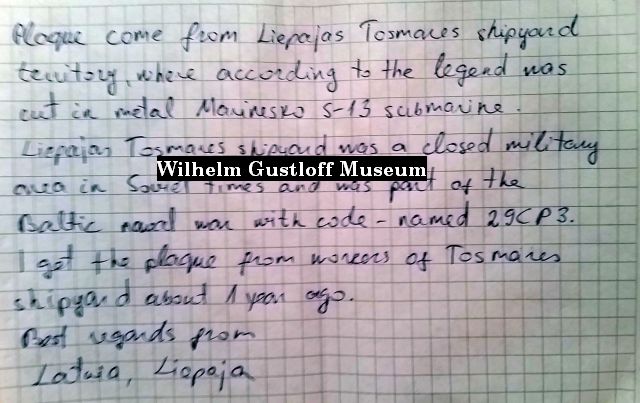
Wooden Deck Plank from the Wilhelm Gustloff Wreck
As the Soviet troops inched closer to Gotenhafen, some of the last evacuees arrived to board the Wilhelm Gustloff. Waltraud Grüter was one of those on board celebrating her 21st birthday. A member of the Marinehelfern or Women’s Naval Auxiliary, Waltraud boarded with her friend Waltraud Idselis and 371 of her comrades a few hours before the ship left port. Due to the lack of room on board, all of the girls were placed down on E Deck in the Gustloff's drained swimming pool surrounded by elaborate tile mosaics.
After the Wilhelm Gustloff sank on January 30th, 1945, debris began washing up along the coastlines closest to where the liner went down. On February 11th, 1945, someone discovered some of her debris washed up along the coastal town of Leba, Poland, roughly 50 miles SE of the wrecksite. This included a piece of her deck plank measuring 17”x5”x1” which was picked up off the beach and carved into a figure of the Madonna by an unknown person. Three years later on January 30th, 1948, the piece was presented to Waltraud Grüter to which she typed a note and placed it on the back of the wood:
In grateful memory of our meeting with my lifesavers
Mr. Heinz Schulz and Captain Freidrich Segelken.
The heroes of the night of January 31st, 1945.
The piece from the wreck which was transformed into a Madonna
Will now accompany me into my continued life
For which I express my thanks a thousand times.
Waltraud Grüter, Hamburg, January 30th, 1948.
The wood carving also came with her original Deutsche Rotes Kreuz, Helferin (German Red Cross Assistant) badge that was attached to her uniform the night of the sinking and survived with her.
After acquiring this piece, I wrote to a newspaper reporter, Christian Harborth, in Germany who interviewed Waltraud about the sinking for the online newspaper Hildesheimer Allgemeine Zeitung back in 2011. He was able to go visit Waltraud on my behalf where she is now 92 years old and suffering from dementia in a nursing home on January 27th, 2016. He wrote back to me: “I visited her yesterday, but she did not recognize me. I also showed her your photos, when Madonna she said 'Das bin ich‘, 'This is me' - meaning that they once belonged to her, (mine).“ In an effort to assist in finding out more, Christian ran a front page article in the newspaper on January 30th, 2016 in the hopes that someone out there may know more about the Madonna (possibly who carved it) and be able to give a greater voice to its story.
A special thanks to Werner Hinke for translating the back of this for me.
After the Wilhelm Gustloff sank on January 30th, 1945, debris began washing up along the coastlines closest to where the liner went down. On February 11th, 1945, someone discovered some of her debris washed up along the coastal town of Leba, Poland, roughly 50 miles SE of the wrecksite. This included a piece of her deck plank measuring 17”x5”x1” which was picked up off the beach and carved into a figure of the Madonna by an unknown person. Three years later on January 30th, 1948, the piece was presented to Waltraud Grüter to which she typed a note and placed it on the back of the wood:
In grateful memory of our meeting with my lifesavers
Mr. Heinz Schulz and Captain Freidrich Segelken.
The heroes of the night of January 31st, 1945.
The piece from the wreck which was transformed into a Madonna
Will now accompany me into my continued life
For which I express my thanks a thousand times.
Waltraud Grüter, Hamburg, January 30th, 1948.
The wood carving also came with her original Deutsche Rotes Kreuz, Helferin (German Red Cross Assistant) badge that was attached to her uniform the night of the sinking and survived with her.
After acquiring this piece, I wrote to a newspaper reporter, Christian Harborth, in Germany who interviewed Waltraud about the sinking for the online newspaper Hildesheimer Allgemeine Zeitung back in 2011. He was able to go visit Waltraud on my behalf where she is now 92 years old and suffering from dementia in a nursing home on January 27th, 2016. He wrote back to me: “I visited her yesterday, but she did not recognize me. I also showed her your photos, when Madonna she said 'Das bin ich‘, 'This is me' - meaning that they once belonged to her, (mine).“ In an effort to assist in finding out more, Christian ran a front page article in the newspaper on January 30th, 2016 in the hopes that someone out there may know more about the Madonna (possibly who carved it) and be able to give a greater voice to its story.
A special thanks to Werner Hinke for translating the back of this for me.
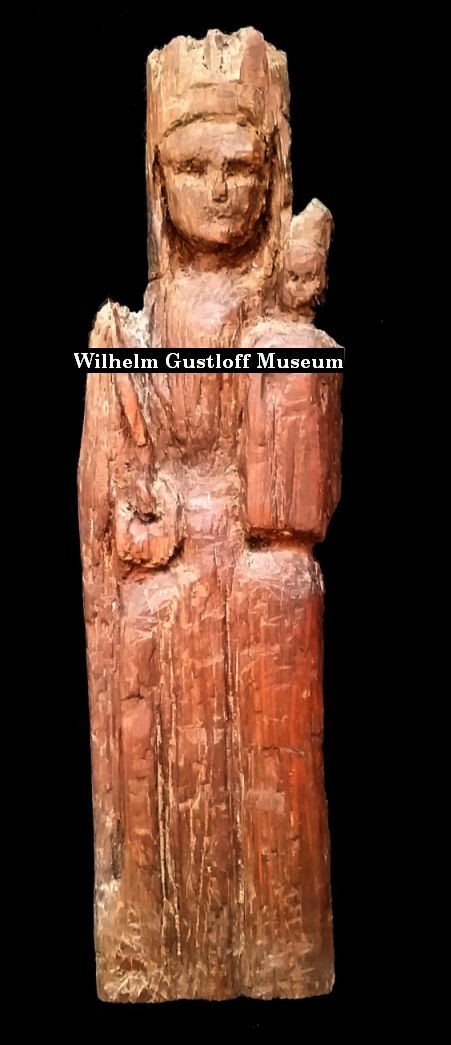
#1: Front of carving.
#2: Back of carving.
#3: Note on back.
#4: Location found - Fundort: Leba.
#5: Map of the wreck and Leba.
#6: Waltraud's Red Cross pin worn the night of the sinking.
#7: Photo from Christian Harborth of Waltraud Grüter holding a photo of her friend Waltraud Idselis and her boyfriend in 1944. Used in the 2011 article "I Want to Live" detailing her escape from the Wilhelm Gustloff.
#8: Online article regarding the Madonna carving in 2016.
#2: Back of carving.
#3: Note on back.
#4: Location found - Fundort: Leba.
#5: Map of the wreck and Leba.
#6: Waltraud's Red Cross pin worn the night of the sinking.
#7: Photo from Christian Harborth of Waltraud Grüter holding a photo of her friend Waltraud Idselis and her boyfriend in 1944. Used in the 2011 article "I Want to Live" detailing her escape from the Wilhelm Gustloff.
#8: Online article regarding the Madonna carving in 2016.
Mosaic Tile from the Wilhelm Gustloff's Swimming Pool
When the Wilhelm Gustloff set sail on January 30th, 1945, among those who were "lucky" enough to gain passage on board were 373 Marine Helferin or Women's Naval Auxiliary. Their accommodations were the Gustloff's drained swimming pool located in the forward section of E Deck. For a passenger liner that was built for simplicity and comfort, her swimming pool was lavishly tiled with a large mosaic of Neptune riding on a shell being pulled by horses from the sea. Just a few years prior, passengers gathered here to relax and play games during her many voyages. Since WWII began, her pool had been drained and now it was considered a safe place to be as the liner was fleeing the Russians.
Then the S-13 took up her position on the Wilhelm Gustloff's port side and fired three torpedoes at the liner. The first torpedo hit at the bow, but the second found its mark at the swimming pool. The casual conversation and banter between the women soon erupted into screams of chaos and agony. The explosion rocked the swimming pool and surrounding locker rooms shattering the tiles and turning them into flying knives. Metal, concrete, and timbers flew into the pool as the glass ceiling shattered and pierced the women below. Water rushed in drowning them within seconds as they never had a chance to escape. Only two or three are known to have escaped the pool and the ship that night.
I have become friends with several well-known divers over the years, and one of them recently contacted me about a piece he had sitting in the darkness of his basement for many years and thought it deserved a new home. During one of his dives on the wreck, he was floating over the area between the bow and severed hull. This debris field was created when the explosives used to collapse the wreck went off, ripping through the bridge, Smoking Lounge, crew's quarters, and the swimming pool. The contents of these rooms spilled out onto the Baltic Sea floor. He recalled how he could look into the wreck "as if it were a 3 story building that had just collapsed." He then saw what looked like a brick sticking out of the mud. He grabbed it, realizing it was a heavier piece. Still unable to see what it was, he pushed off some of the mud to reveal some tile. Once the tile was revealed, he decided to raise it to the surface. After attaching lifting balloons, the large piece of the Wilhelm Gustloff began its ascent to the surface. Soon, it saw light for the first time since 1945. After his crew helped him lift it onto the boat, he poured nothing but seawater on the piece.
With his diving buddies standing around him, it was revealed that this is the only known piece of the Neptune mosaic from the Wilhelm Gustloff's swimming pool ever recovered! Weighing in at 35lbs, it measures 18"x14"x5" at the highest spot. He was looking for a better home since it sat in his basement since he recovered it. I am more than thrilled that he elected to see the piece come into the museum collection where it now stands as the centerpiece of the collection.
I have spent several hours trying to locate where exactly this piece came from on the mosaic. With the assistance of my followers online, the section was discovered and outlined in red in a photo on the right. The color images shown are of a 1:5 scale model from the movie Die Gustloff with the Marine Helferin inserted through CGI, but the mosaic is not accurate. An additional image is one I colorized and overlayed the CGI mosaic on the top. Blohm + Voss was not able to give me more information regarding details of the pool's construction.
Every last piece was saved after the tile was unpacked and cleaned off. Included on the right are the pieces that fell off in transit. 3 vials of rusticles from the Wilhelm Gustloff and a few shards of green tile that were found in the bottom of the wrappings.
Below: The finished pool in March of 1938. The mosaic was made up of around 74,000 individual tiles!
When the Wilhelm Gustloff set sail on January 30th, 1945, among those who were "lucky" enough to gain passage on board were 373 Marine Helferin or Women's Naval Auxiliary. Their accommodations were the Gustloff's drained swimming pool located in the forward section of E Deck. For a passenger liner that was built for simplicity and comfort, her swimming pool was lavishly tiled with a large mosaic of Neptune riding on a shell being pulled by horses from the sea. Just a few years prior, passengers gathered here to relax and play games during her many voyages. Since WWII began, her pool had been drained and now it was considered a safe place to be as the liner was fleeing the Russians.
Then the S-13 took up her position on the Wilhelm Gustloff's port side and fired three torpedoes at the liner. The first torpedo hit at the bow, but the second found its mark at the swimming pool. The casual conversation and banter between the women soon erupted into screams of chaos and agony. The explosion rocked the swimming pool and surrounding locker rooms shattering the tiles and turning them into flying knives. Metal, concrete, and timbers flew into the pool as the glass ceiling shattered and pierced the women below. Water rushed in drowning them within seconds as they never had a chance to escape. Only two or three are known to have escaped the pool and the ship that night.
I have become friends with several well-known divers over the years, and one of them recently contacted me about a piece he had sitting in the darkness of his basement for many years and thought it deserved a new home. During one of his dives on the wreck, he was floating over the area between the bow and severed hull. This debris field was created when the explosives used to collapse the wreck went off, ripping through the bridge, Smoking Lounge, crew's quarters, and the swimming pool. The contents of these rooms spilled out onto the Baltic Sea floor. He recalled how he could look into the wreck "as if it were a 3 story building that had just collapsed." He then saw what looked like a brick sticking out of the mud. He grabbed it, realizing it was a heavier piece. Still unable to see what it was, he pushed off some of the mud to reveal some tile. Once the tile was revealed, he decided to raise it to the surface. After attaching lifting balloons, the large piece of the Wilhelm Gustloff began its ascent to the surface. Soon, it saw light for the first time since 1945. After his crew helped him lift it onto the boat, he poured nothing but seawater on the piece.
With his diving buddies standing around him, it was revealed that this is the only known piece of the Neptune mosaic from the Wilhelm Gustloff's swimming pool ever recovered! Weighing in at 35lbs, it measures 18"x14"x5" at the highest spot. He was looking for a better home since it sat in his basement since he recovered it. I am more than thrilled that he elected to see the piece come into the museum collection where it now stands as the centerpiece of the collection.
I have spent several hours trying to locate where exactly this piece came from on the mosaic. With the assistance of my followers online, the section was discovered and outlined in red in a photo on the right. The color images shown are of a 1:5 scale model from the movie Die Gustloff with the Marine Helferin inserted through CGI, but the mosaic is not accurate. An additional image is one I colorized and overlayed the CGI mosaic on the top. Blohm + Voss was not able to give me more information regarding details of the pool's construction.
Every last piece was saved after the tile was unpacked and cleaned off. Included on the right are the pieces that fell off in transit. 3 vials of rusticles from the Wilhelm Gustloff and a few shards of green tile that were found in the bottom of the wrappings.
Below: The finished pool in March of 1938. The mosaic was made up of around 74,000 individual tiles!
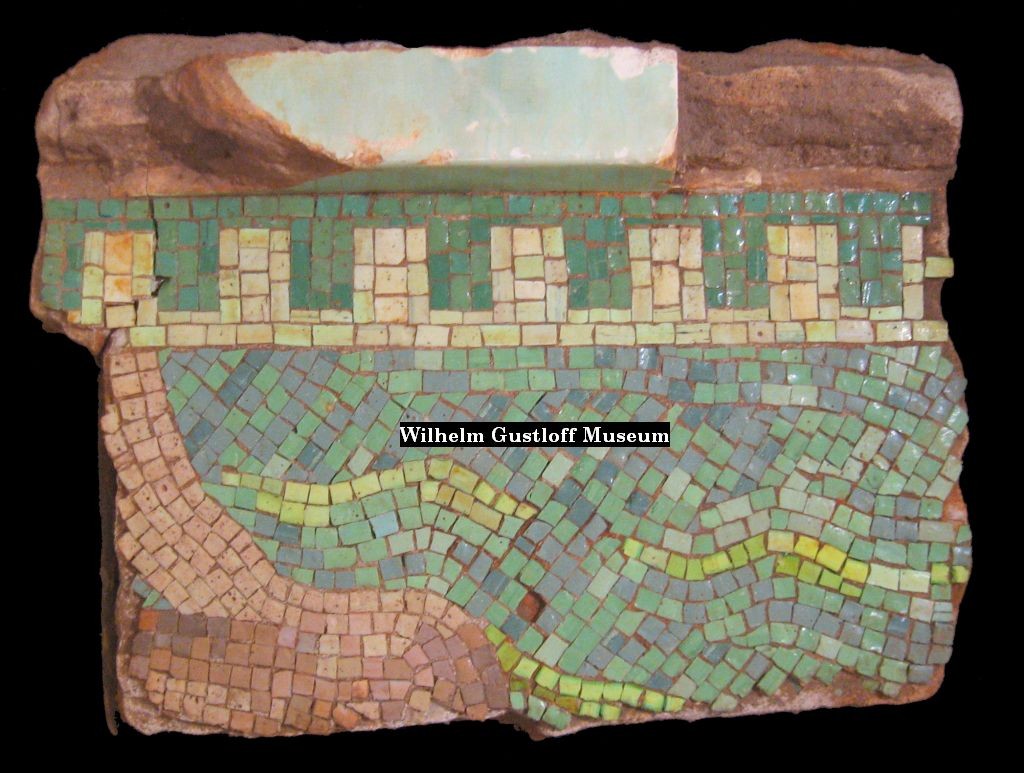

Two of the most graphic images relating to the Wilhelm Gustloff: "Bodies washed ashore along the Pomeranian coastline for weeks after the tragic Gustloff sinking. Most of the victims died from prolonged exposure to the icy waters." This is the same area where the deck wood carved into the Madonna was discovered laying on the beaches among the dead.
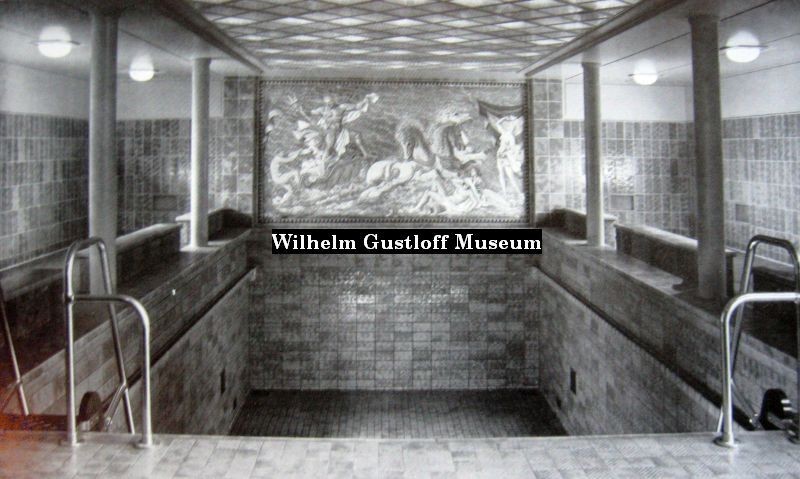
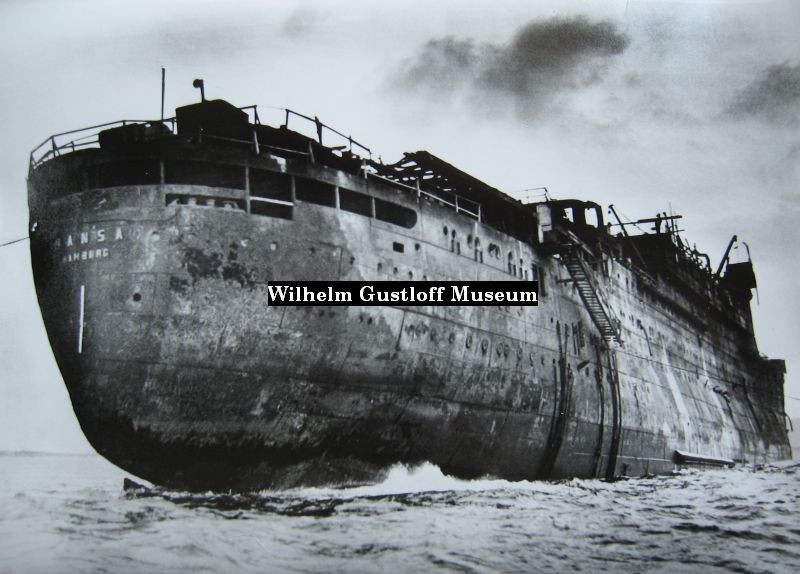
The Hansa was docked next to the Wilhelm Gustloff in Gotenhafen during the war and left with her on the fateful night of January 30th, 1945. She was forced to return due to mechanical trouble and returned to port. After being used to evacuate refugees, on March 6th, she hit a mine off Warnemünde and capsized near the harbor entrance in shallow water. The starboard side of its hull sticking up 5 meters from the water. The ship was eventually uprighted and made able to float again (photo) before being taken to the port of Warnemünde on December 15, 1949 for her conversion into a new passenger ship (above right). She was delivered to the Soviet Union in 1955 as the Sovetskiy Soyuz and scrapped in 1982.
The last three photos come from the Belgian - German diving expedition that recovered the tile mosaic. Their ship, the M.S. Michael Glinka, in port. Working to raise the tile and other items from the wreck. The tile on deck just after it was recovered. The diver told me he when he found it in the mud, he touched it and the mud cleared away to reveal the piece. All they had to do once the tile was on deck was to rinse it off with sea water and it looked like new.

January, 1945 - Gotenhafen. Full-fledged panic is erupting in East Prussia. Tales of Russian revenge for the Nazi invasion of the Motherland spread like wildfire all the way to the Wilhelm Gustloff's port in Gotenhafen's Oxhöft Pier. Hundreds of thousands of German refugees continue to stream in to the Danzig, hoping for safe passage to the West. Alarm widens even more after news of massacres in Nemmersdorf filters through. On a counteroffensive, the German 4th Army managed to temporarily recapture Nemmersdorf, the first town within German borders to be run-over by the Soviets in October 1944. Nazi news agencies are quick to document the Soviet brutality. Newsreels exhibit horrifying images of rape and murder (especially women and children) with the hope that the world will be appalled over the brutality of the Bolsheviks. It was also hoped after seeing these images, Germans would rise up to exact revenge on the Soviets for their actions. A defiant Hitler hysterically calls for all able-bodied men to defend Germany. Many of these "men" are boys as young as 15 or senior citizens of the Volksstrum - Hitler's desperately assembled homeland defense army where any male capable of fighting was thrown into battle (often with only a gun and an armband to identify them).
The western world was not sympathetic and rather than rise up against the Soviets, the footage caused mass panic. Newsreels, newspapers, radio reports, and tales of Red Army carnage only serve to intensify the panic within eastern greater Germany. From the decks of the Wilhelm Gustloff, sounds of advancing artillery grow louder with each passing day. Despite heroic efforts to hold the front, the Reich is collapsing. A major offensive launched by the Soviets in mid-January accelerates the exodus from East Prussia. Many ethnic Germans cut off from the Danzig by the Red
The western world was not sympathetic and rather than rise up against the Soviets, the footage caused mass panic. Newsreels, newspapers, radio reports, and tales of Red Army carnage only serve to intensify the panic within eastern greater Germany. From the decks of the Wilhelm Gustloff, sounds of advancing artillery grow louder with each passing day. Despite heroic efforts to hold the front, the Reich is collapsing. A major offensive launched by the Soviets in mid-January accelerates the exodus from East Prussia. Many ethnic Germans cut off from the Danzig by the Red
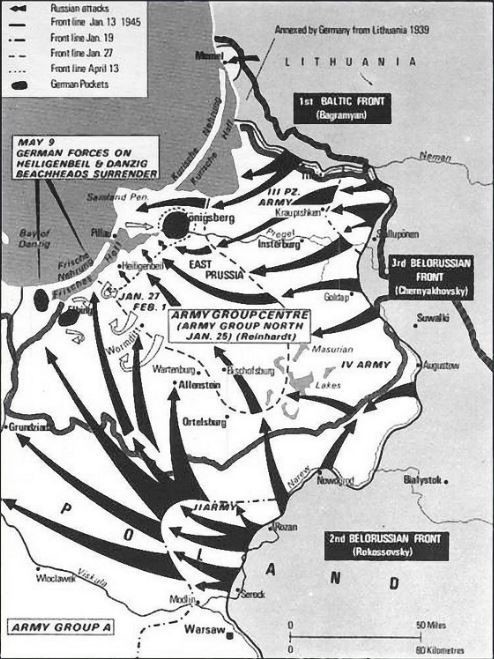
Army troops negotiate passage across the frozen Frisches Haff, a freshwater lagoon on the Baltic coast. Soviet planes circle in the sky, bombing defenseless refugees. Direct hits are not necessary - weakening the ice is enough to send families with their wagons and horses through to an icy death. To the many refugees streaming toward ports in the Danzig, escape to the West is the only hope of avoiding certain suffering and death. Hitler's brutal 'war of extermination' that begun in June 1941 in the East and causing unprecedented human suffering - has turned upon him with a vengeance.
Operation Hannibal
Hope is in the form of Operation Hannibal. Eventually to become the most successful wartime evacuation in history, Hannibal will be responsible for transporting 2 million Germans safely to the West. Despite Hitler's refusal to yield an inch, Gross Admiral Karl Dönitz of the Navy manages to send the one word coded signal "HANNIBAL" on January 21st for his submariners to flee to the West. Unlike Hitler, Dönitz accepts the true nature of the desperate situation and uses this opportunity to evacuate all Germans possible - including refugees.
On January 22nd, 1945, the Gustloff begins preparations to accept thousands of refugees. There are also obvious challenges involved in getting the ship running properly. With the exception of minor test runs, the Gustloff's engines have not been operated in over 4 years. Ships of all shapes and sizes are assembled and prepared for sailing West. Joining the Wilhelm Gustloff will be the ships Cap Arcona, Robert Ley, Hamburg, Hansa, Deutschland, Potsdam, Pretoria, Berlin, General von Steuben, Monte Rosa, Antonio Delfino, Winrich von Kniprode, Ubena, Goya, along with numerous cargo vessels down to tug boats. All are directly under the command of Donitz to ensure urgency.
The Soviet Submarine
Meanwhile, a maverick submarine captain with the Soviet Navy arrives in Gulf of Danzig waters. Captain Alexander Marinesko of the Soviet submarine S-13 is under the gun. On January 2nd, 1945 he is supposed to leave port in Turku, Finland to patrol the Baltic with a team of three other Soviet subs. Unfortunately, his New Year's Eve celebrations go out of control. He disappears on December 31st, 1944 for a three-day binge on alcohol and brothels. Despite all efforts of his shielding crew, they cannot locate him.
At sea, Marinesko is a skilled and decisive submarine captain who enjoys the admiration and devotion of his crew - and never touches a drop of alcohol. On land, he is volatile and impulsive, with a history of drinking beyond excess. The crew finally locates him, dries him out in a sauna, and returns him to base one day after the other subs have left.
Soviet security forces (NKVD - precursor to the KGB) are livid and suspect Marinesko of treachery. They want him court martialed. On the other hand, the Navy is more "forgiving". Stalin has pressured the Navy for all possible resources deployed to destroy the facists. His loyal crew wants him back and could cause even more problems if denied. Finally, after numerous days of interrogation and waiting in limbo, Marinesko heads out to the Baltic aboard the S-13 on January 11th, 1945. He still commands his vessel at sea,
Operation Hannibal
Hope is in the form of Operation Hannibal. Eventually to become the most successful wartime evacuation in history, Hannibal will be responsible for transporting 2 million Germans safely to the West. Despite Hitler's refusal to yield an inch, Gross Admiral Karl Dönitz of the Navy manages to send the one word coded signal "HANNIBAL" on January 21st for his submariners to flee to the West. Unlike Hitler, Dönitz accepts the true nature of the desperate situation and uses this opportunity to evacuate all Germans possible - including refugees.
On January 22nd, 1945, the Gustloff begins preparations to accept thousands of refugees. There are also obvious challenges involved in getting the ship running properly. With the exception of minor test runs, the Gustloff's engines have not been operated in over 4 years. Ships of all shapes and sizes are assembled and prepared for sailing West. Joining the Wilhelm Gustloff will be the ships Cap Arcona, Robert Ley, Hamburg, Hansa, Deutschland, Potsdam, Pretoria, Berlin, General von Steuben, Monte Rosa, Antonio Delfino, Winrich von Kniprode, Ubena, Goya, along with numerous cargo vessels down to tug boats. All are directly under the command of Donitz to ensure urgency.
The Soviet Submarine
Meanwhile, a maverick submarine captain with the Soviet Navy arrives in Gulf of Danzig waters. Captain Alexander Marinesko of the Soviet submarine S-13 is under the gun. On January 2nd, 1945 he is supposed to leave port in Turku, Finland to patrol the Baltic with a team of three other Soviet subs. Unfortunately, his New Year's Eve celebrations go out of control. He disappears on December 31st, 1944 for a three-day binge on alcohol and brothels. Despite all efforts of his shielding crew, they cannot locate him.
At sea, Marinesko is a skilled and decisive submarine captain who enjoys the admiration and devotion of his crew - and never touches a drop of alcohol. On land, he is volatile and impulsive, with a history of drinking beyond excess. The crew finally locates him, dries him out in a sauna, and returns him to base one day after the other subs have left.
Soviet security forces (NKVD - precursor to the KGB) are livid and suspect Marinesko of treachery. They want him court martialed. On the other hand, the Navy is more "forgiving". Stalin has pressured the Navy for all possible resources deployed to destroy the facists. His loyal crew wants him back and could cause even more problems if denied. Finally, after numerous days of interrogation and waiting in limbo, Marinesko heads out to the Baltic aboard the S-13 on January 11th, 1945. He still commands his vessel at sea,
but needs a big score to mitigate his misdeeds while on land. He will find it soon enough.
The Wilhelm Gustloff - The Ship of Hope
The "German Dunkirk" spearheaded by Gross Admiral Donitz is about to begin. The Wilhelm Gustloff once again finds itself in the role as flagship in Gotenhafen. This time however, it is not a gleaming white flagship of the KdF cruise program. It is a naval gray ship of hope for anxious throngs of refugees who are lucky enough to make it as far as the docks. On January 28th, 1945, the Wilhelm Gustloff is ordered to be ready to leave within 48 hours.
The scene in Gotenhafen is panic-laced chaos. Thousands and thousands of refugees - mostly women and children - jam the harbor. You won't find many able-bodied men. Those who can fight the Russians have already been procured for duty (feared SS Stormtroopers patrolling the crowds ensure none are overlooked). Many are not well - having endured bitter cold and long distances by carriage or foot in unforgiving January weather. Thousands do not make it to the Danzig ports. Unimaginable death litters the roadsides and in places like the frozen Frisches Haff lagoon. Despite the mass of pulsating humanity on the docks, boarding the Gustloff is relatively orderly in the early stages. In the standard Nazi-style, originally people were required to have a
The Wilhelm Gustloff - The Ship of Hope
The "German Dunkirk" spearheaded by Gross Admiral Donitz is about to begin. The Wilhelm Gustloff once again finds itself in the role as flagship in Gotenhafen. This time however, it is not a gleaming white flagship of the KdF cruise program. It is a naval gray ship of hope for anxious throngs of refugees who are lucky enough to make it as far as the docks. On January 28th, 1945, the Wilhelm Gustloff is ordered to be ready to leave within 48 hours.
The scene in Gotenhafen is panic-laced chaos. Thousands and thousands of refugees - mostly women and children - jam the harbor. You won't find many able-bodied men. Those who can fight the Russians have already been procured for duty (feared SS Stormtroopers patrolling the crowds ensure none are overlooked). Many are not well - having endured bitter cold and long distances by carriage or foot in unforgiving January weather. Thousands do not make it to the Danzig ports. Unimaginable death litters the roadsides and in places like the frozen Frisches Haff lagoon. Despite the mass of pulsating humanity on the docks, boarding the Gustloff is relatively orderly in the early stages. In the standard Nazi-style, originally people were required to have a
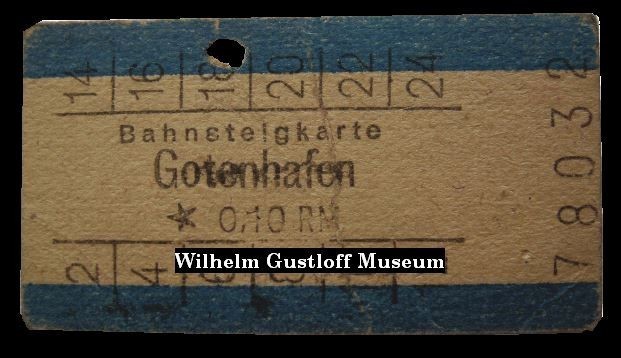
ticket just to reach the piers where the big ships lay waiting. Helga Grahn from Zoppot had one of these tickets (above) as did her mother so they could travel on the Gustloff. Her girlfriend came to see both of them off on the evacuation and try to get on herself. Armed sentries guard the gangways to keep out those without priority or privilege.
The ship's printing press, once used to create colorful cruise agendas, now cranks out the coveted "Identity Pass", or Ausweis that was the second step in accessing the Wilhelm Gustloff. The precious piece of paper with the Gothic type offers hope. As expected, the first right to these passes is provided for the u-boat officers, crew members, and a few hundred members of the Women's Naval Auxiliary. Wounded soldiers arriving by train are also given priority. Privileged refugees then get their turn. The first ones to receive passes are those with connections - to family and friends on board, or to those with local influence. Of course, those with money attempt to buy them. We will never know how many underhanded deals are made. One thing is sure - as more and more privileged board, tension and envy mount in ordinary refugees crowded around the gangways.
The ship's printing press, once used to create colorful cruise agendas, now cranks out the coveted "Identity Pass", or Ausweis that was the second step in accessing the Wilhelm Gustloff. The precious piece of paper with the Gothic type offers hope. As expected, the first right to these passes is provided for the u-boat officers, crew members, and a few hundred members of the Women's Naval Auxiliary. Wounded soldiers arriving by train are also given priority. Privileged refugees then get their turn. The first ones to receive passes are those with connections - to family and friends on board, or to those with local influence. Of course, those with money attempt to buy them. We will never know how many underhanded deals are made. One thing is sure - as more and more privileged board, tension and envy mount in ordinary refugees crowded around the gangways.

The Wilhelm Gustloff fleeing Gotenhafen
Artist: Steffen Reichow - 2010
Acrylic on canvas, 40cm x 30cm.
Wilhelm Gustloff Museum Collection
Artist: Steffen Reichow - 2010
Acrylic on canvas, 40cm x 30cm.
Wilhelm Gustloff Museum Collection
With less than two days until departure, Captain Petersen took charge of preparing the Wilhelm Gustloff for the voyage west. She was far from ready for such a trip. The most pressing issue was that 10 of her 22 lifeboats were gone. After four years as a floating barracks, lifeboats have gradually disappeared from their davits - requisitioned for other duties in the harbor such as creating smoke screens to obscure Allied air raids. To remedy the situation, Joachim Dorfmann, the Gustloff's Second Officer went with a dozen men around the harbor rounding up boats, rafts, and dinghies to be loaded on board. These were strapped down to her Sun Deck and aft spaces that could be spared. The next issue was that the Wilhelm Gustloff's power was provided by a station on the mainland since she tied up here in 1940. Now, fuel needed to be found and loaded so she could make the voyage. Not to mention that she was missing a full crew, her upkeep was ignored for much of the war, and her engines haven't been started in over 4 years. Captain Petersen wondered if they would even turn on when ordered?
To complicate matters more, the Wilhelm Gustloff would not have two, but four captains for her evacuation voyage. While Captain Friedrich Petersen (below left) would remain in charge of the ship and its crew, Korvettenkapitän Wilhelm Zahn (below right) was brought on as the military transport leader in charge of the 2,000 submariners on the Gustloff. Captain Carl Köhler and Captain Heinrich Weller were also brought onto the bridge as senior watch officers. This quickly became an issue as Petersen and Zahn expressed their dislike for one another through a series of arguments as to how the ship should be prepared. The arguments on the bridge paled in comparison to what was happening down in the streets. The streams of people coming into Gotenhafen began peacefully enough. Weary, tired, and injured refugees waited their turn to climb the gangplank and take their place in a corner on the Gustloff. As the days progressed and the Red Army could soon be heard in the distance, panic began to set in to obtain passage west. With artillery fire growing louder by the day, people traded babies and bartered what they had for a boarding pass. Stories of mothers getting on and dropping their babies over the side of the ship to waiting friends so they may use the child to get on were said to be a common occurrence.
To complicate matters more, the Wilhelm Gustloff would not have two, but four captains for her evacuation voyage. While Captain Friedrich Petersen (below left) would remain in charge of the ship and its crew, Korvettenkapitän Wilhelm Zahn (below right) was brought on as the military transport leader in charge of the 2,000 submariners on the Gustloff. Captain Carl Köhler and Captain Heinrich Weller were also brought onto the bridge as senior watch officers. This quickly became an issue as Petersen and Zahn expressed their dislike for one another through a series of arguments as to how the ship should be prepared. The arguments on the bridge paled in comparison to what was happening down in the streets. The streams of people coming into Gotenhafen began peacefully enough. Weary, tired, and injured refugees waited their turn to climb the gangplank and take their place in a corner on the Gustloff. As the days progressed and the Red Army could soon be heard in the distance, panic began to set in to obtain passage west. With artillery fire growing louder by the day, people traded babies and bartered what they had for a boarding pass. Stories of mothers getting on and dropping their babies over the side of the ship to waiting friends so they may use the child to get on were said to be a common occurrence.

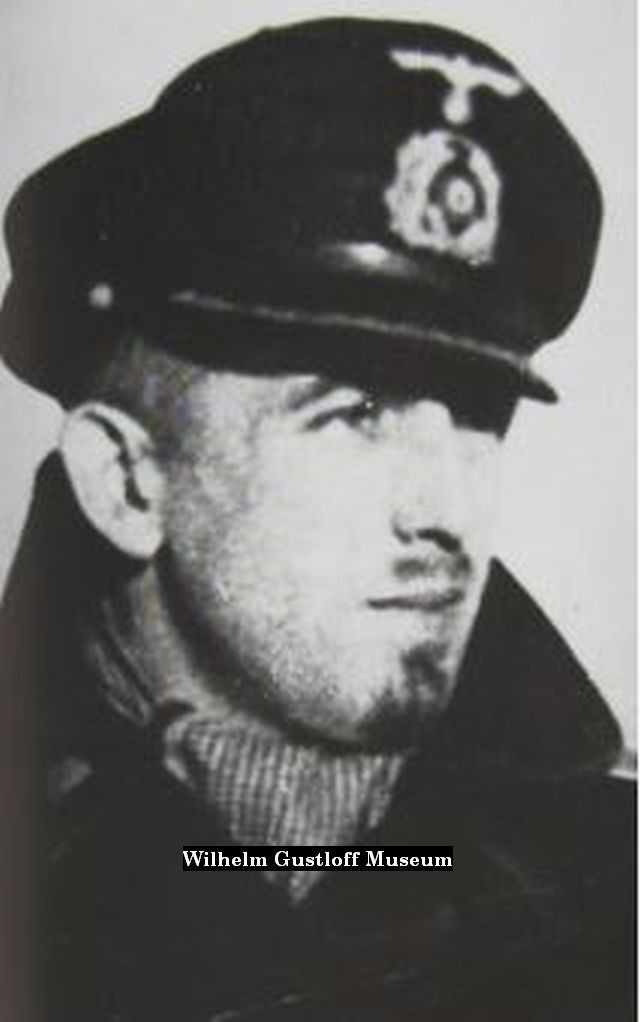
Still, there were those who never had to endure such hardships because they were already on board the liner. Gerhard Grasshoff was already on the ship as a sergeant since November, 1944. He and his colleagues were ordered to move cabins from the port side of the ship to make way for those coming on. Once on the Wilhelm Gustloff, refugees had to navigate crowded passageways and standing room only lounges. The spacious upper deck rooms were turned into infirmaries for the wounded and it was said the Arbor was turned into a maternity ward.
By January 29th, the Wilhelm Gustloff received orders to depart for Kiel. She would be leaving in a convoy with the Hansa, torpedo boat Löwe, and the torpedo collecting boat TF-1 on their way to Kiel. It was rumored that first, the Gustloff would stop in Stettin. The Gustloff's fueling was complete, and her Chief Engineer was ordered to turned on her engines for the first time since November of 1940. Even after being silent for so long, her engines purred to life and smoke begin pouring out of her funnel once more. In addition to having numerous lifeboats on board on top of 12 of her original ones, anti-aircraft guns were mounted to her decks as her only line of defense. She was given 3 x 105mm and 8 x 20mm guns according to Wikipedia.
Down on the docks, the mass of bodies continued to rush onto the Wilhelm Gustloff. Tickets and boarding passes no longer mattered and those manning the checkpoints could not keep the crowds back. Those who were in a position of power demanded entry and threatened the sentries with jail time or death. Captain Petersen saw the situation would soon reach a point where he could no longer maintain control and ordered the liner to drop her lines and move several yards off into the harbor. Boarding would continue by tender in an orderly fashion. Louis Reese, the Gustloff's First Officer, could no longer keep count of those streaming onto the ship. He watched his tally as it passed 3,000, then 4,000, and finally 5,000. The official tally stopped just under 5,000 people on the ship at the time. Still, thousands more still made their way onto the ship after the count had stopped. This is where the true number of those on board that day will never be known, as an accurate account does not exist to show the full extent of her human cargo.
By January 29th, the Wilhelm Gustloff received orders to depart for Kiel. She would be leaving in a convoy with the Hansa, torpedo boat Löwe, and the torpedo collecting boat TF-1 on their way to Kiel. It was rumored that first, the Gustloff would stop in Stettin. The Gustloff's fueling was complete, and her Chief Engineer was ordered to turned on her engines for the first time since November of 1940. Even after being silent for so long, her engines purred to life and smoke begin pouring out of her funnel once more. In addition to having numerous lifeboats on board on top of 12 of her original ones, anti-aircraft guns were mounted to her decks as her only line of defense. She was given 3 x 105mm and 8 x 20mm guns according to Wikipedia.
Down on the docks, the mass of bodies continued to rush onto the Wilhelm Gustloff. Tickets and boarding passes no longer mattered and those manning the checkpoints could not keep the crowds back. Those who were in a position of power demanded entry and threatened the sentries with jail time or death. Captain Petersen saw the situation would soon reach a point where he could no longer maintain control and ordered the liner to drop her lines and move several yards off into the harbor. Boarding would continue by tender in an orderly fashion. Louis Reese, the Gustloff's First Officer, could no longer keep count of those streaming onto the ship. He watched his tally as it passed 3,000, then 4,000, and finally 5,000. The official tally stopped just under 5,000 people on the ship at the time. Still, thousands more still made their way onto the ship after the count had stopped. This is where the true number of those on board that day will never be known, as an accurate account does not exist to show the full extent of her human cargo.
Dockside, Helga Grahn made a split second decision in the mob of refugees. She chose to give her ausweis to her girlfriend so she could travel with her mother on the Gustloff and be together. Helga decided to go with her love Second Lieutenant Karl-Heinz Bruhn to Travemünde on April 12th, 1945 with the U-Boot 3018 (called U-Rose). She bid her girlfriend and mother farewell and disappeared into the crowd. Käthe Kraus also made a last minute decision standing next to the huge gray ocean liner. She heard that co-workers were under pressure and out of time due to the amount of 'top secret' paperwork that the Germans were trying to destroy, she recalled how she decided to stay behind to help with the task and take a liner that was leaving at a later date. She slid her two official boarding passes away and left the piers to continue her work.
As the Soviet troops inched closer to Gotenhafen, some of the last evacuees arrived to board the Wilhelm Gustloff. Waltraud Grüter was one of those on board celebrating her 21st birthday. A member of the Marinehelfern or Women’s Naval Auxiliary, Waltraud boarded with her friend Waltraud Idselis and 371 of her comrades a few hours before the ship left port. Due to the lack of room on board, all of the girls were placed down on E Deck in the Gustloff's drained swimming pool surrounded by elaborate tile mosaics. Finally, at 12:15pm on January 30th, 1945, the Wilhelm Gustloff was ready and began to pull away from Oxhöft Pier and out of Gotenhafen harbor.
As the Soviet troops inched closer to Gotenhafen, some of the last evacuees arrived to board the Wilhelm Gustloff. Waltraud Grüter was one of those on board celebrating her 21st birthday. A member of the Marinehelfern or Women’s Naval Auxiliary, Waltraud boarded with her friend Waltraud Idselis and 371 of her comrades a few hours before the ship left port. Due to the lack of room on board, all of the girls were placed down on E Deck in the Gustloff's drained swimming pool surrounded by elaborate tile mosaics. Finally, at 12:15pm on January 30th, 1945, the Wilhelm Gustloff was ready and began to pull away from Oxhöft Pier and out of Gotenhafen harbor.
The Sinking of the M.S. Wilhelm Gustloff
January 30th, 1945
January 30th, 1945

Fleeing from a brutal Soviet Red Army onslaught, the Wilhelm Gustloff is ready to leave port jammed with over 10,000 German refugees, naval personnel, and wounded soldiers aboard. The vessel is designed to hold a maximum of 1,880 passengers and crew. Of the refugees, a staggering 4,000 are infants, children, and youths on their way to promising safety in the West. Minus 18° Celsius, 0° Fahrenheit weather grips the Oxhöft Pier in Gotenhafen on Tuesday, January 30th, 1945.
For the first time in four years, the former flagship of Nazi pleasure cruising sets a course towards the sea and Kiel on mainland Germany. Icebreakers busily work to carve a path through the Bay of Danzig to allow passage to the unforgiving winter waters of the Baltic Sea. On the bridge, disagreement and tension is budding. Two main senior officers command the ship. Both Petersen and Zahn continue their arguing, now focused on the course the Gustloff should take. Köhler and Weller are also there to add their opinions from their respective places of command.
Around 12:30pm, the Wilhelm Gustloff departs. Unlike its days of joyful peacetime cruising, there are no music bands, flag waving or cheerful send-offs. Instead, anxious hope for the very survival of family members and friends privileged enough to be aboard is evident. Envy and frustration from those who could not board filter through the dejected crowd left at the harbor. Their only hope is to gain passage on one of the other passenger ships anchored at their piers. The Gustloff's pier mate - the Hansa, would also be leaving at the same time with the Gustloff and the torpedoboat Löwe as an escort. The painting at right shows what this would have looked like in calmer weather. Shortly after her departure, a final round of refugees came on board the when the ship Reval had to transfer almost 600 people to the Gustloff. The Wilhelm Gustloff sailed out of Gotenhafen and a transmission was intercepted by what is assumed to be a British station noting her movements at 3:06pm.
ADM (2)
To: ID8G ZIP/ZTPG/334700
From: NS
4282 KC/S T00 1416 T0 1 1506/30/1/45
From: 'Gustloff'
'W. GUSTLOFF' WITH TF.1 LEFT GDYNIA AT 1230. 'LOEWE' WILL FOLLOW ON AS SHE IS TAKING ON OIL. PASSAGE WEST CXXXX VIA WAYS 76, 58, 56, AND 53. W/T WATCH ON 4860 KC/S, 'LO.1', CONVOY WAVE AND RECEIVING WATCH ON 4282 KC/S. 'GUSTLOFF' 991 SOLDIERS, 373 WOMEN NAVAL AUXILIARIES, 3385 CIVILIANS, TF.1: 48 SOLDIERS.
0437/2/2/45 ++++CEL/FA
With the weather as cold and snowy as it was, few could survive for long on her decks and most filled the cramped corridors where one could only stand. As the convoy began their voyage, the Hansa radioed that she was having engine trouble and had to turn back to Gotenhafen. Apparently, time at the pier did not bode well for her machinery. The TF-1 met the same fate and also had to turn around back to port. It was now just the Wilhelm Gustloff and Löwe left to finish the voyage to Kiel.
The situation outside deteriorated as the two ships pressed on. Heavy snowfall was mixed with hail pelting every section of the 684 foot long ship. The wind came howling out of the WNW in near gale strength. Foam from breaking waves is blown into streaks along wind direction. Moderate amounts of airborne spray hit anyone on is standing out on the decks where the temperature is now beginning to hit negative numbers.
Below deck, thousands of passengers attempt to settle into their assigned areas for the journey. Last minute arrivals carve out any reasonable living space they are lucky to find. Every possible space on the ship is occupied. All are instructed over the loudspeaker to wear the lifejackets provided to them. Under no circumstances are they to remove them. Above deck, wind, snow, and hail continue to pelt the Gustloff. The seas become rougher as the bay is left behind. Seasickness begins to set in for many. Unable to relieve themselves overboard, on board toliets become clogged and the stench nauseating.
For the first time in four years, the former flagship of Nazi pleasure cruising sets a course towards the sea and Kiel on mainland Germany. Icebreakers busily work to carve a path through the Bay of Danzig to allow passage to the unforgiving winter waters of the Baltic Sea. On the bridge, disagreement and tension is budding. Two main senior officers command the ship. Both Petersen and Zahn continue their arguing, now focused on the course the Gustloff should take. Köhler and Weller are also there to add their opinions from their respective places of command.
Around 12:30pm, the Wilhelm Gustloff departs. Unlike its days of joyful peacetime cruising, there are no music bands, flag waving or cheerful send-offs. Instead, anxious hope for the very survival of family members and friends privileged enough to be aboard is evident. Envy and frustration from those who could not board filter through the dejected crowd left at the harbor. Their only hope is to gain passage on one of the other passenger ships anchored at their piers. The Gustloff's pier mate - the Hansa, would also be leaving at the same time with the Gustloff and the torpedoboat Löwe as an escort. The painting at right shows what this would have looked like in calmer weather. Shortly after her departure, a final round of refugees came on board the when the ship Reval had to transfer almost 600 people to the Gustloff. The Wilhelm Gustloff sailed out of Gotenhafen and a transmission was intercepted by what is assumed to be a British station noting her movements at 3:06pm.
ADM (2)
To: ID8G ZIP/ZTPG/334700
From: NS
4282 KC/S T00 1416 T0 1 1506/30/1/45
From: 'Gustloff'
'W. GUSTLOFF' WITH TF.1 LEFT GDYNIA AT 1230. 'LOEWE' WILL FOLLOW ON AS SHE IS TAKING ON OIL. PASSAGE WEST CXXXX VIA WAYS 76, 58, 56, AND 53. W/T WATCH ON 4860 KC/S, 'LO.1', CONVOY WAVE AND RECEIVING WATCH ON 4282 KC/S. 'GUSTLOFF' 991 SOLDIERS, 373 WOMEN NAVAL AUXILIARIES, 3385 CIVILIANS, TF.1: 48 SOLDIERS.
0437/2/2/45 ++++CEL/FA
With the weather as cold and snowy as it was, few could survive for long on her decks and most filled the cramped corridors where one could only stand. As the convoy began their voyage, the Hansa radioed that she was having engine trouble and had to turn back to Gotenhafen. Apparently, time at the pier did not bode well for her machinery. The TF-1 met the same fate and also had to turn around back to port. It was now just the Wilhelm Gustloff and Löwe left to finish the voyage to Kiel.
The situation outside deteriorated as the two ships pressed on. Heavy snowfall was mixed with hail pelting every section of the 684 foot long ship. The wind came howling out of the WNW in near gale strength. Foam from breaking waves is blown into streaks along wind direction. Moderate amounts of airborne spray hit anyone on is standing out on the decks where the temperature is now beginning to hit negative numbers.
Below deck, thousands of passengers attempt to settle into their assigned areas for the journey. Last minute arrivals carve out any reasonable living space they are lucky to find. Every possible space on the ship is occupied. All are instructed over the loudspeaker to wear the lifejackets provided to them. Under no circumstances are they to remove them. Above deck, wind, snow, and hail continue to pelt the Gustloff. The seas become rougher as the bay is left behind. Seasickness begins to set in for many. Unable to relieve themselves overboard, on board toliets become clogged and the stench nauseating.
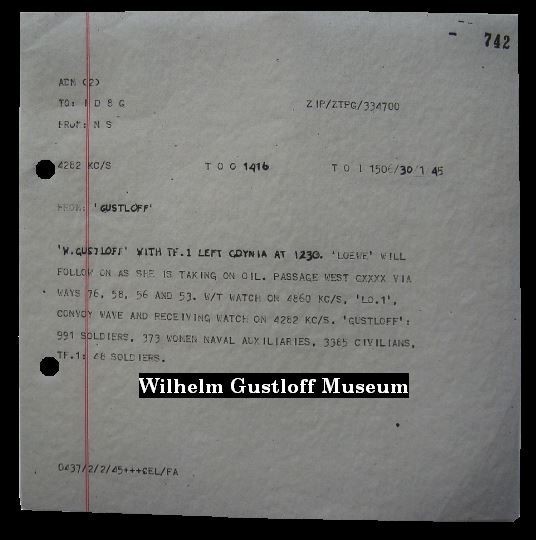
Most refugees were in such shock after escaping with their lives, they just found an area of the ship to huddle in for the long voyage. Below decks, the situation was far worse. Cabins that were already cramped with the standard 2 or 4 passengers were double or triple that size. Hallways that were only 5 or 6 feet across were virtual barricades with humans acting as the obstacles. The Gustloff's restroom facilities were maxed out and broken from such mass use. Excrement flowed up and out of the toilets and onto the floors of the mid-ship lavatories. Those cornered in cabins were forced to do their business in whatever corner they were in without the use of anything to clean themselves. Combined with the heat, sweat, and dirty nature of those who haven't had a bath in days or weeks, the smell was suffocating to those who recalled it. Even so, for many it is a small price to pay for the hardships endured.
Up on the bridge, arguments among the four captains and senior officers continue. They hotly debate such things as route, optimal speed and whether the Gustloff should be following a zigzag course to avoid detection. One thing the captains can agree on: they are not pleased with the inadequacy of their escort. The Gustloff is supposed to be accompanied by the Hansa and two aging torpedo boats. Two had to turn back just as the voyage begun.
Petersen and Zahn are at each others throats from everything to why the lifeboats aren't swung out incase of an emergency to the decision to sail without more protection from escorts. Two issues would become central to the Wilhelm Gustloff's fate. The first was the path the Gustloff would take to Kiel. Two options presented themselves. They could sail the ship closer to the shore, where there was the danger of running into a mine, but the waters were too shallow for a submarine to operate in. They could also use the shipping channel Lane No. 58 that runs north of the Stolpe Bank. There would be no danger of mines, but Soviet submarines could be lurking in the deep. Since the general agreement seemed to be that submarines could not operate in such severe weather conditions, the Wilhelm Gustloff made for the open shipping channel away from the coast. Approximately 1.5 hours after leaving Gotenhafen, the Gustloff settles into a course further away from the coast in Lane No. 58 - an officially mine swept channel. It was also decided that rather than a zig-zag pattern, the ship would run a straight course towards Kiel.
Zahn was demanding that his men reach the port with all speed to help the war effort and man the new Type XXI u-boats being perfected after a slew of production issues arose during their construction. The final decision that needed to be made came when the Gustloff's radio technician, Rudi Lange, received word around 6:00pm that a convoy of minesweepers was also sailing in the channel and coming from the opposite direction. They were currently sailing in the dark without any lights to avoid detection from the enemy. Continuing on this path risked the one of the largest passenger liners in the German fleet having a head-on collision with a minesweeper. They could turn on the ship's navigation lights to alert the convoy to the presence, but who else would they also give their location away to? Rudi Lange hadn't received any messages of enemy ships, planes, or submarines in the area. Unfortunately for the Petersen and Zahn, the enemy's submarines were spotted in the area, but the bad weather caused messages to not get through or deciphered by Lange. If they were spotted by planes, the anti-aircraft guns were already frozen and useless on the deck. The Löwe would be useless in such an attack. Zahn wanted the navigation lights turned off to follow war protocol and Petersen wants them on. After continued arguing, Petersen flips the switch up and red and green shone across the sea through the darkness. The Wilhelm Gustloff's fate was sealed.
Despite the bitter cold outside, heat and humidity is rising below decks. Many ignore Petersen's order to keep lifejackets on - a risk they're willing to take to relieve tremendous discomfort. Cries are heard from some of the thousands of children on board. Those able to stomach it are offered soup, sandwiches, and other basic food items. Some are even able to be lulled to sleep. In the enclosed glad deck below the bridge, wounded soldiers and pregnant mothers are cared for. The Hitler Suite, an elaborate set of rooms for the Führer were occupied by the mayor of Gotenhafen and his family. This was the first time the suite would see anyone staying there.
The S-13 Spots the Wilhelm Gustloff
Soviet submarine captain Alexander Marinesko slips into the Gulf of Danzig without informing his central command. Having patrolled with other Russian submarines off the coast near Memel, opportunities are scant. Aware of enemy activity around ports in the Danzig, he hopes for better odds. Also aware of a court-martial hanging over him for previous onshore indiscretions, he needs better odds. It is a calculated risk for the bold captain and his crew of 47 men.
Now he was topside and charging his batteries for his 780 ton, 256 foot long S-13 built in 1934 and around 8:00pm, he noticed lights in the distance. At first, he mistook them for the Hel Lighthouse on the coast. When he caught a break in weather, he went to look through his periscope and recalled, "I saw a silhouette of an ocean liner. It was enormous. It even had some lights showing. There and then I decided it was about 20,000 tons, certainly not less. And I was quite sure it was packed with men who had trampled on Mother Russia and were now fleeing for their lives. It had to be sunk, I decided, and the S-13 would do the job."
Back on the Wilhelm Gustloff, passengers tried to pass the time as best they could. No one is aware of the danger lurking in the darkness. The u-boat sensing equipment on board the escorting torpedo boat Löwe has frozen and is useless. Crews on both vessels must rely on outlooks - a tough order in these conditions. Cheerful music piping through the ship's speakers is interrupted sometime after 8:00pm. Hitler, live on the radio, makes an impassioned speech to commemorate the 12th anniversary of the Nazi rise to power. It echoes through the corridors of the ship. No doubt, it provides comfort to some while invoking quiet cynicism from many others.
While the speech is being broadcast, Marinesko catches up with the Wilhelm Gustloff and overtakes her on the port side in the shallow water off land. This was a daring move as he risked running aground, but gained the advantage of surprise. Marinesko has four torpedoes loaded into the S-13's tubes. Each one bears a special message for the Germans:
Torpedo #1 - For the Motherland
Torpedo #2 - For Stalin
Torpedo #3 - For the Soviet people
Torpedo #4 - For Leningrad
Up on the bridge, arguments among the four captains and senior officers continue. They hotly debate such things as route, optimal speed and whether the Gustloff should be following a zigzag course to avoid detection. One thing the captains can agree on: they are not pleased with the inadequacy of their escort. The Gustloff is supposed to be accompanied by the Hansa and two aging torpedo boats. Two had to turn back just as the voyage begun.
Petersen and Zahn are at each others throats from everything to why the lifeboats aren't swung out incase of an emergency to the decision to sail without more protection from escorts. Two issues would become central to the Wilhelm Gustloff's fate. The first was the path the Gustloff would take to Kiel. Two options presented themselves. They could sail the ship closer to the shore, where there was the danger of running into a mine, but the waters were too shallow for a submarine to operate in. They could also use the shipping channel Lane No. 58 that runs north of the Stolpe Bank. There would be no danger of mines, but Soviet submarines could be lurking in the deep. Since the general agreement seemed to be that submarines could not operate in such severe weather conditions, the Wilhelm Gustloff made for the open shipping channel away from the coast. Approximately 1.5 hours after leaving Gotenhafen, the Gustloff settles into a course further away from the coast in Lane No. 58 - an officially mine swept channel. It was also decided that rather than a zig-zag pattern, the ship would run a straight course towards Kiel.
Zahn was demanding that his men reach the port with all speed to help the war effort and man the new Type XXI u-boats being perfected after a slew of production issues arose during their construction. The final decision that needed to be made came when the Gustloff's radio technician, Rudi Lange, received word around 6:00pm that a convoy of minesweepers was also sailing in the channel and coming from the opposite direction. They were currently sailing in the dark without any lights to avoid detection from the enemy. Continuing on this path risked the one of the largest passenger liners in the German fleet having a head-on collision with a minesweeper. They could turn on the ship's navigation lights to alert the convoy to the presence, but who else would they also give their location away to? Rudi Lange hadn't received any messages of enemy ships, planes, or submarines in the area. Unfortunately for the Petersen and Zahn, the enemy's submarines were spotted in the area, but the bad weather caused messages to not get through or deciphered by Lange. If they were spotted by planes, the anti-aircraft guns were already frozen and useless on the deck. The Löwe would be useless in such an attack. Zahn wanted the navigation lights turned off to follow war protocol and Petersen wants them on. After continued arguing, Petersen flips the switch up and red and green shone across the sea through the darkness. The Wilhelm Gustloff's fate was sealed.
Despite the bitter cold outside, heat and humidity is rising below decks. Many ignore Petersen's order to keep lifejackets on - a risk they're willing to take to relieve tremendous discomfort. Cries are heard from some of the thousands of children on board. Those able to stomach it are offered soup, sandwiches, and other basic food items. Some are even able to be lulled to sleep. In the enclosed glad deck below the bridge, wounded soldiers and pregnant mothers are cared for. The Hitler Suite, an elaborate set of rooms for the Führer were occupied by the mayor of Gotenhafen and his family. This was the first time the suite would see anyone staying there.
The S-13 Spots the Wilhelm Gustloff
Soviet submarine captain Alexander Marinesko slips into the Gulf of Danzig without informing his central command. Having patrolled with other Russian submarines off the coast near Memel, opportunities are scant. Aware of enemy activity around ports in the Danzig, he hopes for better odds. Also aware of a court-martial hanging over him for previous onshore indiscretions, he needs better odds. It is a calculated risk for the bold captain and his crew of 47 men.
Now he was topside and charging his batteries for his 780 ton, 256 foot long S-13 built in 1934 and around 8:00pm, he noticed lights in the distance. At first, he mistook them for the Hel Lighthouse on the coast. When he caught a break in weather, he went to look through his periscope and recalled, "I saw a silhouette of an ocean liner. It was enormous. It even had some lights showing. There and then I decided it was about 20,000 tons, certainly not less. And I was quite sure it was packed with men who had trampled on Mother Russia and were now fleeing for their lives. It had to be sunk, I decided, and the S-13 would do the job."
Back on the Wilhelm Gustloff, passengers tried to pass the time as best they could. No one is aware of the danger lurking in the darkness. The u-boat sensing equipment on board the escorting torpedo boat Löwe has frozen and is useless. Crews on both vessels must rely on outlooks - a tough order in these conditions. Cheerful music piping through the ship's speakers is interrupted sometime after 8:00pm. Hitler, live on the radio, makes an impassioned speech to commemorate the 12th anniversary of the Nazi rise to power. It echoes through the corridors of the ship. No doubt, it provides comfort to some while invoking quiet cynicism from many others.
While the speech is being broadcast, Marinesko catches up with the Wilhelm Gustloff and overtakes her on the port side in the shallow water off land. This was a daring move as he risked running aground, but gained the advantage of surprise. Marinesko has four torpedoes loaded into the S-13's tubes. Each one bears a special message for the Germans:
Torpedo #1 - For the Motherland
Torpedo #2 - For Stalin
Torpedo #3 - For the Soviet people
Torpedo #4 - For Leningrad
It would be the last speech Hitler makes and before he signs off, he states, "However grave the crisis may be at the moment, it will, despite everything, finally be mastered by our unalterable will, by our readiness for sacrifice and by our abilities. We shall overcome this calamity, too, and this fight." The timing of everything is suited for a Shakespearean play.
Shortly before 9:00, Gerhard Grasshoff and his comrades went on guard duty. They put on their coats and field boots to face the cold and snow. Alexander Marinekso orders all 4 torpedoes fired from the S-13 just after 9. Three torpedoes speed toward his unknown, but enormous target. One torpedo - For Stalin - remains behind. It is stuck in its launching tube with its primer fully armed, threatening to blow up the submarine to bits with the slightest jolt. If not for the quick and delicate actions of the crew on the S-13 to disarm it, history may never have known what hit the Gustloff. On the bridge, there is a cautious sense of relief among the four captains that they have now reached the Stolpe Bank. They share a sentiment that the most dangerous waters are now behind them.
Shortly before 9:00, Gerhard Grasshoff and his comrades went on guard duty. They put on their coats and field boots to face the cold and snow. Alexander Marinekso orders all 4 torpedoes fired from the S-13 just after 9. Three torpedoes speed toward his unknown, but enormous target. One torpedo - For Stalin - remains behind. It is stuck in its launching tube with its primer fully armed, threatening to blow up the submarine to bits with the slightest jolt. If not for the quick and delicate actions of the crew on the S-13 to disarm it, history may never have known what hit the Gustloff. On the bridge, there is a cautious sense of relief among the four captains that they have now reached the Stolpe Bank. They share a sentiment that the most dangerous waters are now behind them.

Artist representation of the sinking.
In addition to their first meal since departure, a round of cognac is poured to toast good fortune. Captain Weller remains on duty at the bridge. Shortly after Gerard stepped outside, the first torpedo struck the Wilhelm Gustloff's port side and shook the entire ship about 9:16pm. It struck the forward crew cabins and cargo areas in the bow, blasting a hole in the side of the ship with a huge water plume shooting up in the air. Many crew members housed here were killed instantly. Immediately, the thought was they had hit a mine.
A few seconds later, the second torpedo strikes further aft than the first. It strikes the area which holds the Wilhelm Gustloff's swimming pool and 373 of the Women's Naval Auxiliary. The torpedo first blew through the locker rooms on the port side, then shattering the beautiful tile mosaics and turning them into lethal pieces of flying shrapnel that was sure to have killed many of the women where they slept. The large glass ceiling over the pool also shattered, coming down onto the women and impaling them to the bottom of the pool. For a brief time, the swimming pool turned red with the blood of those injured in the blast. The explosion and smoke soon gave way to a torrent of water flooding the area for the first time in years. But this time, floating corpses and body parts swim in its water rather than excited passengers. Of the 373 Marinehelfern kept there and in the surrounding cabins, only two or three are known to have escaped.
Waltraud Grüter was lucky because while she was in a lower cabin of the ship, she was not in the pool itself when the second torpedo hit. She began her escape recalling that "each hit sounded like a closet full of glasses tipping over." The third torpedo was next. It hit the Wilhelm Gustloff in her engine room midship and knocked out her power with the incoming rush of seawater, smoke, and fire. For a few moments, one can only hear the mayhem of screaming and shouting, along with the rushing in of water. Everyone could feel the ship already begin to list to the port side. The Wilhelm Gustloff's emergency lights flickered on - illuminating chaos in a dull light that makes the desperate boarding in Gotenhafen look like a relaxed party. Indescribable chaos ensued for those 10,000 on board in the following hour.
Sinking
Captain Weller tried to call the engine room for a status update, but there was no reply. Petersen ordered the watertight doors closed, sealing off those crew still alive in the bow. They were the few on board that knew how to operate the lifeboats. Rudi Lange tried to send out an SOS signal, but was forced to use a small emergency radio transmitter with no power to run the main one. With a transmission range of only 2,000 meters, only the Löwe was able to receive the distress call. The Löwe picked up the SOS and began transmitting it further with their powerful radio. Below decks, the frantic rush to get topside began. Refugees trampled over one another kicking and screaming as water began flooding cabins and corridors. Many do not survive the frenzied charge to the decks. Appeals from the P.A. system to maintain order are largely ignored and become background tones mixed with alarm sirens. The "women and children first" rule is ignored by many in their terrified efforts to get on the decks and to the lifeboats. Stairwells jam as mobs of people attempt escape the rushing water below decks. To fall on the way means almost certain death. Many trapped in the throng can barely breathe - unable to move their feet or arms and are 'carried' up by the swarm.
Waltraud recalled, "I struggled from my cabin to the Sun Deck after the torpedo hits. I climbed over the people who were in the corridors or the stairs, injured or trampled by others. Once at the top of the railing, I thought in a panic, what to do? The ship got more and more inclined, people lost their grip and slid over the icy deck into the water. A soldier asked me to slide down the ship's hull into the water." As she walked past the windows of the Lower Promenade Deck, she saw scenes that she should remember forever: "fearful faces, torn eyes of women and children. Panicked with their fists against the indestructible glass wall. About 1,000 people were trapped in the belly of the ship and abandoned to death. I heard loud gurgling, and hundreds calling for help." On the upper decks, crew members and civilians alike made attempts to free and launch the ship's lifeboats. Once freed, there was a mad rush to get on them while others jumped in from upper decks. Several lifeboats capsized into the water, dumping their human cargo into the Baltic Sea to freeze to death. Gun shots were soon ringing out as officers took their families into their cabins to kill everyone, then themselves in order to avoid a death of drowning or freezing. The Löwe began to pick up survivors as soon as she arrived, throwing nets down her hull and launching lifeboats of her own to pick up those who they could. Gerhard Grasshoff was lowering lifeboats, helping women and children in. Once he put them into a lifeboat, he saw room on the other side of a lifeboat, and he ran over, slid down the railing of the ship and swam out to the lifeboat.
On deck, the combination of ice and lack of trained crew members exacerbated the situation. People slide off the icy decks and into the freezing water. The ship lists more and more with each passing minute. Lifeboats are frozen to their davits. People claw and smash at them with bare hands trying to free them. Even if they are able to knock them loose, many of the very crew members trained to lower them are trapped behind the watertight doors. Reportedly, only one lifeboat is lowered correctly during the sinking and roughly 5 others still make it away from the stricken passenger liner. One lowers with only 12 sailors in it. Others have cables snap, fall, and capsize - tossing their occupants into the icy water or crushing those already in it. At one point, the useless anti-aircraft guns break free and plummet overboard, landing on a fully-occupied lifeboat. Below right: The Gustloff sinking in the 1960 movie Nacht fiel über Gotenhafen.
Some report seeing a high-ranking officer with his wife lowering a motorboat only half occupied. It passes right by the plate glass of the enclosed promenade, jammed with desperate women and children. We can only imagine what those on both sides of the glass were thinking. It seems selfish acts are not reserved strictly for the passengers.
Back on Löwe, her SOS signal was picked up by the Admiral Hipper and T-36 under Lt. Commander Robert Hering and both ships were heading in the direction of the sinking ship. By this time, the Wilhelm Gustloff was listing even further onto her port side. The situation was dire on the ship. Those wounded and unable to get off their beds were left to their fate on the upper decks. As the Gustloff keeled over, they would've slid across the room into the wall with anything else not nailed down. If the impacts didn't kill them, the influx of water rushing into the interiors would've. It's hard to imagine laying there without the use of your limbs, knowing you've been left to die on a sinking ship and you have 15, 30, 45 minutes to contemplate the last few minutes of your life on Earth. The grand piano, the only piece of furniture left in the Music Hall, slammed into people against the wall as the ship sank according to other survivors. One survivor I spoke to said she was one of those who just made it past the piano as is came sliding across the room. Up on the Sun Deck, rafts and boats that were unable to have been launched rolled down the deck, smashing through the railing and landing in the sea. By this time, the S-13's unfired torpedo was diffused and Marinesko watched the death throes of his target through the periscope. The Admiral Hipper and T-36 get closer as the Gustloff's funnel was almost level with the water.
All four captains manage to save themselves from the sinking ship while people trapped behind the glass of the Lower Promenade Deck struggled to break the glass before they would drown. Despite the window's ability to slide down, the ice and snow prevented this. Survivors reported standing on the outside of the Gustloff as she was on her side watching through the glass as the water rose and eventually claimed hundreds on the other side. After picking up the sound of the S-13, the Admiral Hipper decided with 1,600 refugees already on board, she would flee the scene rather than risk getting sunk herself. The biggest ray of hope for those in the water was soon gone.
Soon, the Wilhelm Gustloff was in her final moments. Thousands of screams filled the black night air as the sounds of splashing surrounded everyone on all sides. Just before the Gustloff sank, her stern began to rise out of the air. Eerily, as if to say her final good-bye, the entire ship regained power and every light on board illuminated the entire night sky. In a final blaze of farewell, wailing siren drown with the ship as it descends into the depths. The Wilhelm Gustloff had sunk taking 9,343 souls with her in 70 minutes. 1,252 survived.
Rescue
Those left flailing in the freezing stormy water of the Baltic won't last long. Many try to grasp at lifeboats or rafts - only to be clubbed or beaten off by desperate and paranoid occupants. Bodies of victims, made buoyant by their lifejackets, bob up and down lifelessly in the sea. Corpses of younger children float upside down, the ill-fitting life jackets not designed for smaller sizes. It's almost as if the lifejackets themselves could never have anticipated such an unimaginable tragedy to befall upon a child.
In the cold Baltic Sea, the T-36 worked overtime rescuing survivors and protecting herself from the sounds of the S-13. Hering ordered depth charges dropped in an attempt to eliminate the sub. While the S-13 was able to slip away into the deep, the depth charges exploded with survivors in the water, each killing scores with each blast. In the end, several ships rescued survivors from the disaster. The T-36 rescued 564 people, the torpedo boat Löwe saved 472 people, Minesweeper M387 saved 98 people, Minesweeper M375 saved 43 people, and the Minesweeper M341 rescued 37 people. Waltraud was saved in a lifeboat that held 35 men and women. "When we were saved, there were 5 of us. Three officers, a Berliner, and myself. Those who froze to death we had to throw back to the sea." Her lifeboat was picked up by the steamer Göttingen which saved 28 people. Last, the torpedo practice boat TF19 saved 7, and the freighter Gotland saved 2 people.
In any tragedy however, miracles can happen. Seven hours after the ship went down, a small patrol boat, VP-1703 arrives to a sea of floating bodies. Its on board searchlight finds a lifeboat. When Petty Officer Werner Fick jumps in to inspect it, he discovers an infant wrapped tightly in a wool blanket - astonishingly alive among the frozen corpses. This is the last official survivor of the Wilhelm Gustloff.
A few seconds later, the second torpedo strikes further aft than the first. It strikes the area which holds the Wilhelm Gustloff's swimming pool and 373 of the Women's Naval Auxiliary. The torpedo first blew through the locker rooms on the port side, then shattering the beautiful tile mosaics and turning them into lethal pieces of flying shrapnel that was sure to have killed many of the women where they slept. The large glass ceiling over the pool also shattered, coming down onto the women and impaling them to the bottom of the pool. For a brief time, the swimming pool turned red with the blood of those injured in the blast. The explosion and smoke soon gave way to a torrent of water flooding the area for the first time in years. But this time, floating corpses and body parts swim in its water rather than excited passengers. Of the 373 Marinehelfern kept there and in the surrounding cabins, only two or three are known to have escaped.
Waltraud Grüter was lucky because while she was in a lower cabin of the ship, she was not in the pool itself when the second torpedo hit. She began her escape recalling that "each hit sounded like a closet full of glasses tipping over." The third torpedo was next. It hit the Wilhelm Gustloff in her engine room midship and knocked out her power with the incoming rush of seawater, smoke, and fire. For a few moments, one can only hear the mayhem of screaming and shouting, along with the rushing in of water. Everyone could feel the ship already begin to list to the port side. The Wilhelm Gustloff's emergency lights flickered on - illuminating chaos in a dull light that makes the desperate boarding in Gotenhafen look like a relaxed party. Indescribable chaos ensued for those 10,000 on board in the following hour.
Sinking
Captain Weller tried to call the engine room for a status update, but there was no reply. Petersen ordered the watertight doors closed, sealing off those crew still alive in the bow. They were the few on board that knew how to operate the lifeboats. Rudi Lange tried to send out an SOS signal, but was forced to use a small emergency radio transmitter with no power to run the main one. With a transmission range of only 2,000 meters, only the Löwe was able to receive the distress call. The Löwe picked up the SOS and began transmitting it further with their powerful radio. Below decks, the frantic rush to get topside began. Refugees trampled over one another kicking and screaming as water began flooding cabins and corridors. Many do not survive the frenzied charge to the decks. Appeals from the P.A. system to maintain order are largely ignored and become background tones mixed with alarm sirens. The "women and children first" rule is ignored by many in their terrified efforts to get on the decks and to the lifeboats. Stairwells jam as mobs of people attempt escape the rushing water below decks. To fall on the way means almost certain death. Many trapped in the throng can barely breathe - unable to move their feet or arms and are 'carried' up by the swarm.
Waltraud recalled, "I struggled from my cabin to the Sun Deck after the torpedo hits. I climbed over the people who were in the corridors or the stairs, injured or trampled by others. Once at the top of the railing, I thought in a panic, what to do? The ship got more and more inclined, people lost their grip and slid over the icy deck into the water. A soldier asked me to slide down the ship's hull into the water." As she walked past the windows of the Lower Promenade Deck, she saw scenes that she should remember forever: "fearful faces, torn eyes of women and children. Panicked with their fists against the indestructible glass wall. About 1,000 people were trapped in the belly of the ship and abandoned to death. I heard loud gurgling, and hundreds calling for help." On the upper decks, crew members and civilians alike made attempts to free and launch the ship's lifeboats. Once freed, there was a mad rush to get on them while others jumped in from upper decks. Several lifeboats capsized into the water, dumping their human cargo into the Baltic Sea to freeze to death. Gun shots were soon ringing out as officers took their families into their cabins to kill everyone, then themselves in order to avoid a death of drowning or freezing. The Löwe began to pick up survivors as soon as she arrived, throwing nets down her hull and launching lifeboats of her own to pick up those who they could. Gerhard Grasshoff was lowering lifeboats, helping women and children in. Once he put them into a lifeboat, he saw room on the other side of a lifeboat, and he ran over, slid down the railing of the ship and swam out to the lifeboat.
On deck, the combination of ice and lack of trained crew members exacerbated the situation. People slide off the icy decks and into the freezing water. The ship lists more and more with each passing minute. Lifeboats are frozen to their davits. People claw and smash at them with bare hands trying to free them. Even if they are able to knock them loose, many of the very crew members trained to lower them are trapped behind the watertight doors. Reportedly, only one lifeboat is lowered correctly during the sinking and roughly 5 others still make it away from the stricken passenger liner. One lowers with only 12 sailors in it. Others have cables snap, fall, and capsize - tossing their occupants into the icy water or crushing those already in it. At one point, the useless anti-aircraft guns break free and plummet overboard, landing on a fully-occupied lifeboat. Below right: The Gustloff sinking in the 1960 movie Nacht fiel über Gotenhafen.
Some report seeing a high-ranking officer with his wife lowering a motorboat only half occupied. It passes right by the plate glass of the enclosed promenade, jammed with desperate women and children. We can only imagine what those on both sides of the glass were thinking. It seems selfish acts are not reserved strictly for the passengers.
Back on Löwe, her SOS signal was picked up by the Admiral Hipper and T-36 under Lt. Commander Robert Hering and both ships were heading in the direction of the sinking ship. By this time, the Wilhelm Gustloff was listing even further onto her port side. The situation was dire on the ship. Those wounded and unable to get off their beds were left to their fate on the upper decks. As the Gustloff keeled over, they would've slid across the room into the wall with anything else not nailed down. If the impacts didn't kill them, the influx of water rushing into the interiors would've. It's hard to imagine laying there without the use of your limbs, knowing you've been left to die on a sinking ship and you have 15, 30, 45 minutes to contemplate the last few minutes of your life on Earth. The grand piano, the only piece of furniture left in the Music Hall, slammed into people against the wall as the ship sank according to other survivors. One survivor I spoke to said she was one of those who just made it past the piano as is came sliding across the room. Up on the Sun Deck, rafts and boats that were unable to have been launched rolled down the deck, smashing through the railing and landing in the sea. By this time, the S-13's unfired torpedo was diffused and Marinesko watched the death throes of his target through the periscope. The Admiral Hipper and T-36 get closer as the Gustloff's funnel was almost level with the water.
All four captains manage to save themselves from the sinking ship while people trapped behind the glass of the Lower Promenade Deck struggled to break the glass before they would drown. Despite the window's ability to slide down, the ice and snow prevented this. Survivors reported standing on the outside of the Gustloff as she was on her side watching through the glass as the water rose and eventually claimed hundreds on the other side. After picking up the sound of the S-13, the Admiral Hipper decided with 1,600 refugees already on board, she would flee the scene rather than risk getting sunk herself. The biggest ray of hope for those in the water was soon gone.
Soon, the Wilhelm Gustloff was in her final moments. Thousands of screams filled the black night air as the sounds of splashing surrounded everyone on all sides. Just before the Gustloff sank, her stern began to rise out of the air. Eerily, as if to say her final good-bye, the entire ship regained power and every light on board illuminated the entire night sky. In a final blaze of farewell, wailing siren drown with the ship as it descends into the depths. The Wilhelm Gustloff had sunk taking 9,343 souls with her in 70 minutes. 1,252 survived.
Rescue
Those left flailing in the freezing stormy water of the Baltic won't last long. Many try to grasp at lifeboats or rafts - only to be clubbed or beaten off by desperate and paranoid occupants. Bodies of victims, made buoyant by their lifejackets, bob up and down lifelessly in the sea. Corpses of younger children float upside down, the ill-fitting life jackets not designed for smaller sizes. It's almost as if the lifejackets themselves could never have anticipated such an unimaginable tragedy to befall upon a child.
In the cold Baltic Sea, the T-36 worked overtime rescuing survivors and protecting herself from the sounds of the S-13. Hering ordered depth charges dropped in an attempt to eliminate the sub. While the S-13 was able to slip away into the deep, the depth charges exploded with survivors in the water, each killing scores with each blast. In the end, several ships rescued survivors from the disaster. The T-36 rescued 564 people, the torpedo boat Löwe saved 472 people, Minesweeper M387 saved 98 people, Minesweeper M375 saved 43 people, and the Minesweeper M341 rescued 37 people. Waltraud was saved in a lifeboat that held 35 men and women. "When we were saved, there were 5 of us. Three officers, a Berliner, and myself. Those who froze to death we had to throw back to the sea." Her lifeboat was picked up by the steamer Göttingen which saved 28 people. Last, the torpedo practice boat TF19 saved 7, and the freighter Gotland saved 2 people.
In any tragedy however, miracles can happen. Seven hours after the ship went down, a small patrol boat, VP-1703 arrives to a sea of floating bodies. Its on board searchlight finds a lifeboat. When Petty Officer Werner Fick jumps in to inspect it, he discovers an infant wrapped tightly in a wool blanket - astonishingly alive among the frozen corpses. This is the last official survivor of the Wilhelm Gustloff.

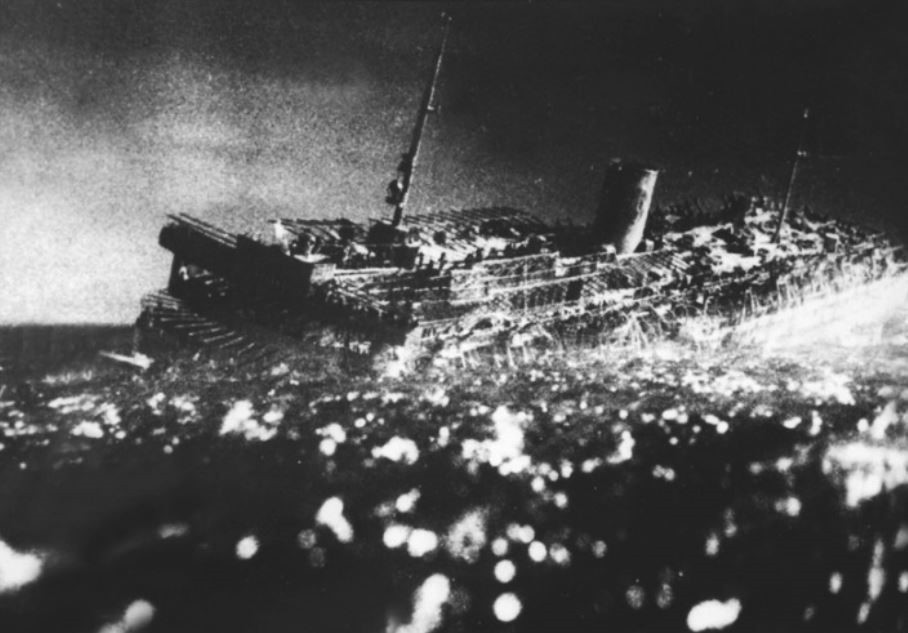
Wilhelm Gustloff Passenger List for January 30th, 1945
PDF
Lists 739 Survivors, 814 Missing / Dead
Lists 739 Survivors, 814 Missing / Dead
Official Listing (Not Complete) Members of the Kriegsmarine (2.U.L.D.) whom perished on the Wilhelm Gustloff
PDF
PDF
After Alexander Marinesko torpedoed the Wilhelm Gustloff, he continued to remain in the area's shipping channels. On February 9th in the middle of the night, he caught up with the 14,000 ton passenger liner General von Steuben. Like the Gustloff, she was a hospital ship, then a camouflaged accommodation ship. She is shown here in her full camouflage paint scheme.
She was sailing from Pillau to Kiel with roughly 2,700 wounded, 270 medical personnel, 900 refugees and a crew of 450 with an escort of two small torpedo boats. He carefully followed the liner and lined up his torpedoes, firing two at the ship and making direct hits. By survivor accounts, the ship sank in about 20 minutes and only 300 to 700 were saved of the estimated 4,000 to 5,000 on board.
Marinesko returned to the Soviet Union, but not as a hero. As noted before, his drinking, temper, and inability to give accurate details of his enemy targets eventually did him in. Many did not even believe he sunk the Wilhelm Gustloff. For a time, he was thrown in a Siberian prison, dishonorably discharged from the Navy, and eventually died in 1963. Finally in 1990, he was posthumously awarded the Hero of the Soviet Union medal and given credits for his sinkings during World War II.
The first 4 photos above of the General von Steuben, aka Steuben during the war. Photo #2: March 1941. Ship in the foreground named Ferdinand with the port of Wesermünde. This was the site of a naval academy, it is located close to Kiel. A luggage tag from the ship, a girl posing on the stairs during a peacetime voyage, and tissue paper deck plans of the ship.
She was sailing from Pillau to Kiel with roughly 2,700 wounded, 270 medical personnel, 900 refugees and a crew of 450 with an escort of two small torpedo boats. He carefully followed the liner and lined up his torpedoes, firing two at the ship and making direct hits. By survivor accounts, the ship sank in about 20 minutes and only 300 to 700 were saved of the estimated 4,000 to 5,000 on board.
Marinesko returned to the Soviet Union, but not as a hero. As noted before, his drinking, temper, and inability to give accurate details of his enemy targets eventually did him in. Many did not even believe he sunk the Wilhelm Gustloff. For a time, he was thrown in a Siberian prison, dishonorably discharged from the Navy, and eventually died in 1963. Finally in 1990, he was posthumously awarded the Hero of the Soviet Union medal and given credits for his sinkings during World War II.
The first 4 photos above of the General von Steuben, aka Steuben during the war. Photo #2: March 1941. Ship in the foreground named Ferdinand with the port of Wesermünde. This was the site of a naval academy, it is located close to Kiel. A luggage tag from the ship, a girl posing on the stairs during a peacetime voyage, and tissue paper deck plans of the ship.
After the sinking, the officials of the Third Reich did not want to lower the morale of those fighting the war on all fronts. News of the loss of large passenger liners like the Wilhelm Gustloff and General von Steuben would be devastating. While the German side was silent about the disaster, the Allied powers published news about the sinkings in German through propaganda newspapers made to inform Germans of what was really going on. The first came on February 6th in a newspaper titled Fieldpost: Edited by the American Army in Western Europe. The article was brief:
"Wilhelm Gustloff" Sinks.
Helsinki - The former "Strength through Joy" ship "Wilhelm Gustloff" was sunk after her exit from Danzig. 3,700 submariners and 5,000 fleeting NS officials were on board.
It was not until February 18th, that the paper Nachrichten für die Truppe, or News for the Troops featured a front page article about the sinking. It was also a propaganda newspaper that was dropped over German territory by the 8th US Air Fleet. Even though it was propaganda and originally began as psychological warfare, the paper compiled by 25 editors in Britain spread factual news to demoralize the Third Reich in the final months of the war.
"Wilhelm Gustloff" Torpedoed: 7,000 drown in Danzig Bay
Refugee ship sinks in 15 minutes. It was only yesterday that the people of Danzig were told that the many bodies of members of the Kriegsmarine, women and children, who had been swept along the coast of Danzig Bay for more than 14 days, are from the demise of the U-Boat-Accommodation-Ship "Wilhelm Gustloff", which sailed on January 30th with 8,000 U-boatmen and Eastern refugees on board from Gotenhafen, and was sunk in the Danzig Bay. Just an hour after its departure, precisely at 9 pm, the "Wilhelm Gustloff" was torpedoed by a submarine in the darkness of the Danzig Bay. The 25,000-ton ship sunk within a quarter of an hour.
Every man for himself
Of the 8,000 persons on board, scarcely a thousand were saved. 347 corpses have so far been washed on the coast of Danzig Bay. Survivors report horror scenes after the explosion. The whole ship was immediately shrouded in darkness. Hundreds of women and children were trampled to death in the corridors and steps, when everything pushed up. Others were ruthlessly thrown overboard in the fight in the few rescue boats. Petrified and drowned After 10 minutes, the "Wilhelm Gustloff" listed hard. Five minutes later, the ship capsized. All the people on deck were thrown into the icy waters. Many thousands were taken down into the depths with the ship. Many who were thrown into the sea fell into the wake of the sinking ship and disappeared into the floods. Thousands froze in the icy water and perished. On board the "Wilhelm Gustloff" were around 3,700 men from the submarine school flotillas in Gotenhafen. The other passengers were East refugees, mostly women and children evacuated by the Party. The names of other smaller ships, which were also sunk in the Bay of Danzig, have not yet been announced.
The sinking of the "Wilhelm Gustloff" means a particularly heavy blow
(Continued on page 4)(This page was missing from the translated article.)
Translated by Andreas Faßbender
"Wilhelm Gustloff" Sinks.
Helsinki - The former "Strength through Joy" ship "Wilhelm Gustloff" was sunk after her exit from Danzig. 3,700 submariners and 5,000 fleeting NS officials were on board.
It was not until February 18th, that the paper Nachrichten für die Truppe, or News for the Troops featured a front page article about the sinking. It was also a propaganda newspaper that was dropped over German territory by the 8th US Air Fleet. Even though it was propaganda and originally began as psychological warfare, the paper compiled by 25 editors in Britain spread factual news to demoralize the Third Reich in the final months of the war.
"Wilhelm Gustloff" Torpedoed: 7,000 drown in Danzig Bay
Refugee ship sinks in 15 minutes. It was only yesterday that the people of Danzig were told that the many bodies of members of the Kriegsmarine, women and children, who had been swept along the coast of Danzig Bay for more than 14 days, are from the demise of the U-Boat-Accommodation-Ship "Wilhelm Gustloff", which sailed on January 30th with 8,000 U-boatmen and Eastern refugees on board from Gotenhafen, and was sunk in the Danzig Bay. Just an hour after its departure, precisely at 9 pm, the "Wilhelm Gustloff" was torpedoed by a submarine in the darkness of the Danzig Bay. The 25,000-ton ship sunk within a quarter of an hour.
Every man for himself
Of the 8,000 persons on board, scarcely a thousand were saved. 347 corpses have so far been washed on the coast of Danzig Bay. Survivors report horror scenes after the explosion. The whole ship was immediately shrouded in darkness. Hundreds of women and children were trampled to death in the corridors and steps, when everything pushed up. Others were ruthlessly thrown overboard in the fight in the few rescue boats. Petrified and drowned After 10 minutes, the "Wilhelm Gustloff" listed hard. Five minutes later, the ship capsized. All the people on deck were thrown into the icy waters. Many thousands were taken down into the depths with the ship. Many who were thrown into the sea fell into the wake of the sinking ship and disappeared into the floods. Thousands froze in the icy water and perished. On board the "Wilhelm Gustloff" were around 3,700 men from the submarine school flotillas in Gotenhafen. The other passengers were East refugees, mostly women and children evacuated by the Party. The names of other smaller ships, which were also sunk in the Bay of Danzig, have not yet been announced.
The sinking of the "Wilhelm Gustloff" means a particularly heavy blow
(Continued on page 4)(This page was missing from the translated article.)
Translated by Andreas Faßbender
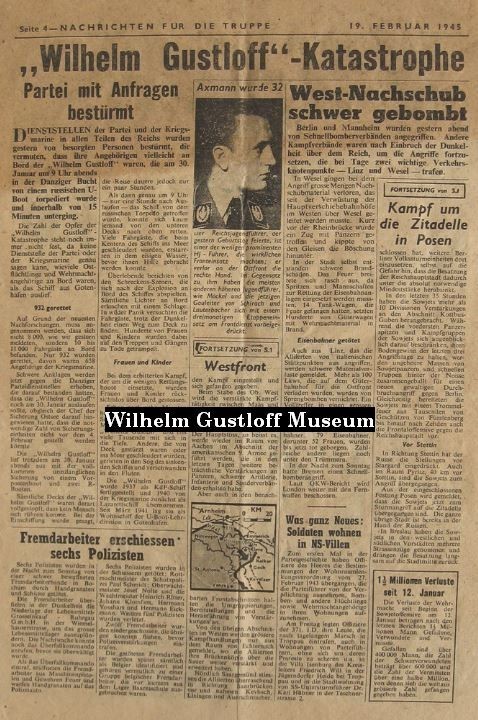
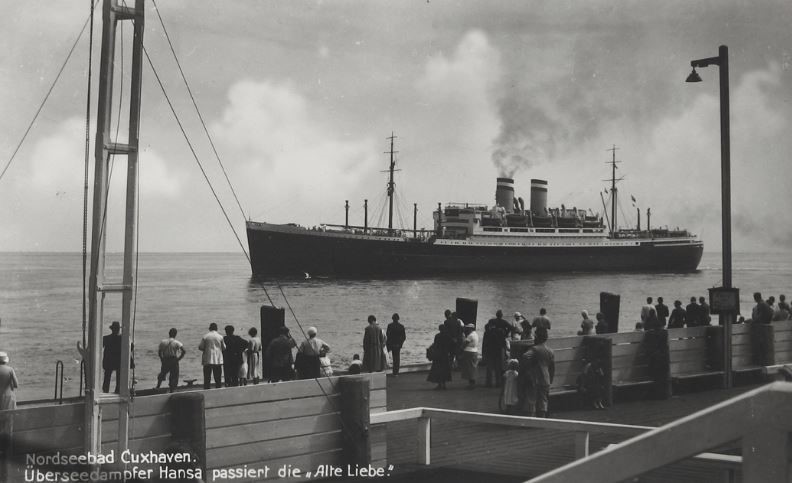
Ticket for access to Gotenhafen during WWII.
News of the sinking reached Helga Grahn in February and she discovered that her girlfriend and mother both did not survive the sinking. April 12th finally came when she left with her love Second Lieutenant Karl-Heinz Bruhn to Travemünde with the U-Boot 3018 (called U-Rose). Her daughter still has a picture from that day when she was landing and he was waiting for her at the pier when she arrived from Danzig with his submarine friends.
After landing they stepped immediately into the church in Travemünde to get married. Helga's daughter whom I purchased this from also put in the old wedding picture from Helga Grahn (Granowski) and her Second Lieutenant Karl-Heinz Bruhn in the envelope. Helga lived her whole life – born 1923 until 1945 in Zoppot - working at „Deutsche Reichspost Telegrafenamt“ in Danzig.
News of the sinking reached Helga Grahn in February and she discovered that her girlfriend and mother both did not survive the sinking. April 12th finally came when she left with her love Second Lieutenant Karl-Heinz Bruhn to Travemünde with the U-Boot 3018 (called U-Rose). Her daughter still has a picture from that day when she was landing and he was waiting for her at the pier when she arrived from Danzig with his submarine friends.
After landing they stepped immediately into the church in Travemünde to get married. Helga's daughter whom I purchased this from also put in the old wedding picture from Helga Grahn (Granowski) and her Second Lieutenant Karl-Heinz Bruhn in the envelope. Helga lived her whole life – born 1923 until 1945 in Zoppot - working at „Deutsche Reichspost Telegrafenamt“ in Danzig.
Wilhelm Gustloff Survivor Accounts
Click on the name to read their account of the sinking.
Originally posted by Dave Krawczyk
Click on the name to read their account of the sinking.
Originally posted by Dave Krawczyk
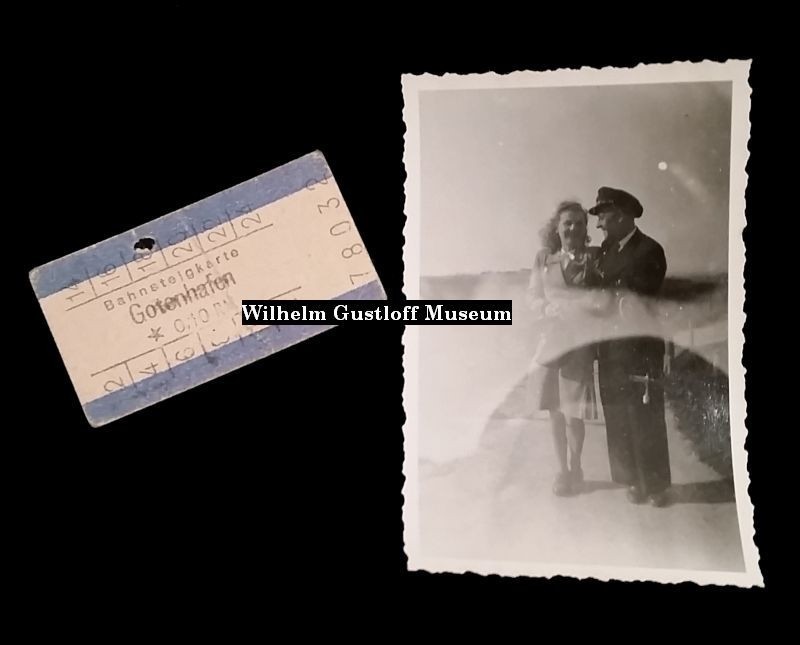
Aftermath - 1945

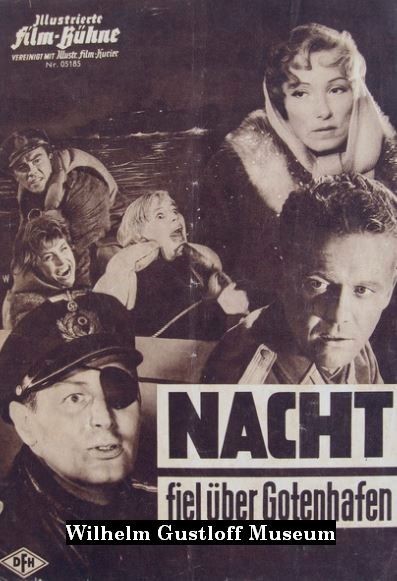

Playbill for Nacht fiel über Gotenhafen - 1960
For several years after the sinking, very little was said about the disaster. It wasn't until 1959 when a movie, Night Fell Over Gotenhafen, told the story of the sinking of the Wilhelm Gustloff. Heinz Schön, an 18 year old junior purser that survived the sinking, was brought on to assist in recreating the movie accurately. He was known as the premier historian on the disaster and ran the Gustloff Archive in Germany. He also assisted in the 2008 movie, Die Gustloff, which retold the disaster in color. He worked with authors and published books with the most complete lists of survivors and dead known to date. On April 7th, 2013, Heinz passed away and the his entire collection went into the private possession of a friend of Schön. He later placed the urn with Heinz Schön's remains on the wreck of the Wilhelm Gustloff as his final wishes.
Sailor's Memorial
A wall, decorated with German ships sunk in both World Wars, is part of a new Memorial Hall for German sailors killed in action. The hall, at Laboe, Germany, was designed by Annemarie Ewertsen, Laboe sculptor. At rear, left, are the words for the figure 120,000, meaning 120,000 German sailors lost their lives in action from 1939 to 1945. The silhouettes of the Wilhelm Gustloff and Robert Ley are visible towards the bottom center of the wall. This photo was taken in 1963.
For several years after the sinking, very little was said about the disaster. It wasn't until 1959 when a movie, Night Fell Over Gotenhafen, told the story of the sinking of the Wilhelm Gustloff. Heinz Schön, an 18 year old junior purser that survived the sinking, was brought on to assist in recreating the movie accurately. He was known as the premier historian on the disaster and ran the Gustloff Archive in Germany. He also assisted in the 2008 movie, Die Gustloff, which retold the disaster in color. He worked with authors and published books with the most complete lists of survivors and dead known to date. On April 7th, 2013, Heinz passed away and the his entire collection went into the private possession of a friend of Schön. He later placed the urn with Heinz Schön's remains on the wreck of the Wilhelm Gustloff as his final wishes.
Sailor's Memorial
A wall, decorated with German ships sunk in both World Wars, is part of a new Memorial Hall for German sailors killed in action. The hall, at Laboe, Germany, was designed by Annemarie Ewertsen, Laboe sculptor. At rear, left, are the words for the figure 120,000, meaning 120,000 German sailors lost their lives in action from 1939 to 1945. The silhouettes of the Wilhelm Gustloff and Robert Ley are visible towards the bottom center of the wall. This photo was taken in 1963.
Wreck and Artifacts of the Wilhelm Gustloff
1950 to 2022
1950 to 2022
World War II was now over but the Soviets soon turned their eye to the wreck of the Wilhelm Gustloff. To understand why, you first need a brief history lesson. Started in 1701, the Amber Room was a high ceiling 590 square foot room that was constructed out of 6 tons of amber and gilded in gold. Considered one of the eighth wonders, it ended up in Catherine Palace in Russia where it was admired by all who saw it. A hand-colored slide of the original room in 1931 is shown on Wikipedia. When World War II broke out, this room would've been near the top of Hitler's list to obtain for his Führermuseum which would never be realized. As the Germans entered Russia, it was soon realized that the fragility of the room wouldn't allow it to be taken apart to be saved. The workers at Catherine Palace quickly covered the room in wallpaper and fled the advancing Nazis. Quickly found once they entered the ground, the Nazis took the room apart anyway and transported it back to Germany in October of 1941. It soon reached the city of Königsberg and in November, it was announced it would be reassembled and shown in Königsberg Castle in an exhibition. Soon, the Russians turned the tables on the Germans and were on their way back for their precious Amber Room in 1944. Hitler ordered the priceless treasures he looted over the past few years hidden and the Amber Room was prepared.
By the end of 1944, the room was never seen again. Most historians believe that the room wasn't able to make it out of Königsberg Castle and was destroyed in its bombing in August of 1944. At the time, it was heavily rumored that the room was smuggled to Gotenhafen before the fall of East Prussia and that it was loaded onto the Wilhelm Gustloff for her final voyage. The Russians took control of the wreck after the war well into the 1950s, prohibiting any diving on the relatively shallow hulk. They cut into her hull and did extensive damage to the ship, only to come up empty handed. Whether anything else was taken by their divers was never disclosed. After several years, other divers began applying for permission to dive on the wreck through the Soviet Union before its collapse. Some of the first divers down noted how the ship was destroyed in the middle and had strong evidence of explosions and cutting not reminiscent of destruction through a sinking. These divers fueled the thoughts that Russia destroyed the wreck to cover up their search for the Amber Room.
Later in 1973, Jerzy Janczukowicz began making a name for himself in the Gustloff story through the number of dives he began doing on the wreck. The wreck was at a point where it was a free for all to dive on and remove anything of value or interest. During his dives, he recovered one of the large chandeliers from the Smoking Lounge on the Lower Promenade Deck, part of the ship's compass, and a piece of staircase railing with its wooden top intact. After one set of dives, he told a reporter who interviewed him, "Once I saw the skeleton of a soldier, still wearing its boots and a military belt." Today, the wreck pieces remain in his personal collection, the chandelier now a coffee table in his living room.
The next notable set of dives came in 1988 when Rudi Lange, her surviving radio technician, went on a series of three expeditions with Philip Sayers. The first dives took place in April of 1988. Their purpose for these dives was to recover pieces of the wreck for a museum exhibit that Rudi Lange was hoping a museum would create. Later in Philip Sayers' book Baltic Gold, he wrote about a secret secondary mission to recover secret boxes of gold bullion that were being transported on the Gustloff's final voyage. Fiction it seemed until November 2016 when both men went public believing that $100 million in gold bars were smuggled onboard. The first two expeditions were primarily research and to lay a memorial plaque on the wreck. By the time they returned for the third set of dives, the German and Polish governments declared the wreck a war grave and memorial site. As of 1994, diving was not permitted within 1,500 feet of the liner's hull. Their expedition had the go ahead and on their third dive, they recovered 3 portholes from the wreck. One had two iron bars welded across it and was from the strong room in Hitler's private cabin on B Deck. When they came into port, Heinz Schön called the authorities on them for grave robbing. Rudi openly claimed Heinz called the wreck 'his wreck' and was jealous that Rudi would remove anything before Heinz could. They had a rivalry brewing for several years. No charges were filed and the recovered portholes ended up where Rudi wanted them: donated to the Museum Ship Albatross.
In 1991, Ulli Restemeyer participated in a Belgian - German diving expedition with their ship, the M.S. Michael Glinka. A researcher of Baltic wrecks, Ulli completed 15 to 20 expeditions and roughly 60 dives on the wreck of the Wilhelm Gustloff. He also saw how mangled the wreck of the Gustloff was, but when I asked him why, he told me it wasn't necessarily the Russians. When the Wilhelm Gustloff sank on her port side, she came to rest in 45m (147 feet) of water. She would've risen off the sea floor 23.5m (77 feet), leaving only 70 feet of clearance between her wreck and the surface above. Since she went down in a major shipping lane, this would have posed a navigational hazard. While it probably was the Russians, the ship was imploded upon itself between the bow and stern where she posed the greatest threat to the ships above. When this was done is not known. I have also heard that the stern mast was blown up in 1973 because it was still sticking up at a depth of 21 meters. An attempt to detail the ship's wreck from 1945 to the present was done by Pawel Laskowski and can be read HERE in Polish. Some excerpts from his article are translated here:
"The first dive, a few years after the sinking, the Russians reached the wreck. Although sources indicate Polish divers as wreck finders. In the years 1948 - 1951, Soviet military divers from EPROM mining company were underwater for 3 seasons. The purpose and scope of the works carried out at that time remain a mystery of the Russian side. The Russians, until 1953, were the masters of Polish territorial waters. The Polish Maritime Office was not informed of anything, and the Polish Ship Rescue received from the Soviet authorities a strictly separated list of only 30 objects to be excavated. The effects of these underwater activities on the wreck are visible today. The Russians used many methods to penetrate the inside of the ship. The sapper method used to dismantle the sides and walls of the wreck was common. Dynamite was not a precise way to pave the way inside the hull. Classical EPROM divers in the area of the front hold chose two holes of 4 by 5 meters. In the second half of August 1955, the first documented Polish diving action took place on the wreck of the Wilhelm Gustloff. This was done by divers of Polish Ship Salvage from the ship Swiatowid, which has equipment for deepwater diving. The whole action was secret. In all documents and maps, the wreck was listed under the code name Leba 1. It was kept in strict secret in the Maritime Office in Gdynia for many years.
An attempt to open a secret sketch of the damage to the wreck was created in August 1955 on the basis of 10 or 12 different dives of the PRO. Drawings and measurements were made and it turned out there was no possibility of raising the wreck due to extensive damage. The Poles saw ruined amidships, which looked largely due to the work of the Russians - like a great battlefield. There were almost no signs of bodies and almost no remains of passenger's personal belongings in relation to the number of victims. After years in the Tri-City circulated stories of people who in the second half of the 1950s encountered Russian and Polish divers who penetrated the wreck right after the tragedy. Stanislaw Chomentowski, former vice president of training of the KDP / CMAS, divers with several decades of experience, dived several times on the wreck of the Gustloff as part of the PMW military during the 1950s and 1960s. He confirmed the fact of "cleansing" of the wreckage from the property of the refugees. As professionals, they had a large view, practical and theoretical, concerning underwater works, allowing them to identify the different techniques used to make the underwater cuts into the wreck based on the traces left behind. He was able to identify 3. Some of them were fresh tracks, while the Russians only used one method and the traces of these cuts were old. One of the types of cut was not a technology used by the Russians or Poles. Guesses presume and indicate a visit by one of NATO's marines, perhaps divers from a foreign military block who could do this secretly from a submarine."
Today, the wreck of the Wilhelm Gustloff lies at 55°04′22″N 17°25′17″E, 19 miles offshore from Leba, Poland. Listed only as Obstacle No. 73 on Polish navigation charts. She lays in a depth of about 45 meters depending on which part of the ship you dive on. The above sonar scan shows the full destruction of the middle of the ship, while her bow and stern almost look like they are ready to set sail. The Bridge and Sun Decks almost look like they have been peeled off and landed upside down above the wreck. It looks as if the starboard bridge wing was inverted and is sticking out above the top of the image. In 1994, the wreck of the Wilhelm Gustloff was recognized by Poland as a war grave. No diving is allowed on or within 500 meters of it. This issue was governed by Order No. 9 of the Director of the Maritime Office in Gdynia. (Dz.Urz.Woj.Pom.2006.62.1276).
Dives to the wreck of the Wilhelm Gustloff continued under special permit in the early 21st century. In 2003, Mike Boring dove on the wreck and noted the damage and twisted metal pointing in every direction. He noted how anything relating to human activity on the ship seemed to have disappeared as if removed to leave just the shell of a ship. I even heard that one of her lifeboats survived in a town in northern Poland until recently, when I was told it was destroyed. Another lifeboat was turned into a fishing vessel which survives to this day. You would never even know what it used to be. While the midship was destroyed, items like the wooden handrails around her stern remain intact, as if waiting for the next group of boarding passengers. In 2004, one of the last special permits was issued to film the documentary Ghosts of the Baltic Sea. Since then, the Gustloff has remained silent on the floor of the Baltic Sea waiting for the next divers to visit and tell more of her story.
Below: Wreck photos of the Wilhelm Gustloff in 1991 during a dive with Jerzy Janczukowicz. Photos 27 - 29 were on a later dive to film the documentary Ghosts of the Baltic with Dr. Robert Ballard. The final photo is with one of the salvaged Gustloff anchors in the port of Gdynia. The stern light in pictures 9 to 11 was eventually recovered by unknown persons and its current location is unknown. All images courtesy of Ulli Restemeyer.
By the end of 1944, the room was never seen again. Most historians believe that the room wasn't able to make it out of Königsberg Castle and was destroyed in its bombing in August of 1944. At the time, it was heavily rumored that the room was smuggled to Gotenhafen before the fall of East Prussia and that it was loaded onto the Wilhelm Gustloff for her final voyage. The Russians took control of the wreck after the war well into the 1950s, prohibiting any diving on the relatively shallow hulk. They cut into her hull and did extensive damage to the ship, only to come up empty handed. Whether anything else was taken by their divers was never disclosed. After several years, other divers began applying for permission to dive on the wreck through the Soviet Union before its collapse. Some of the first divers down noted how the ship was destroyed in the middle and had strong evidence of explosions and cutting not reminiscent of destruction through a sinking. These divers fueled the thoughts that Russia destroyed the wreck to cover up their search for the Amber Room.
Later in 1973, Jerzy Janczukowicz began making a name for himself in the Gustloff story through the number of dives he began doing on the wreck. The wreck was at a point where it was a free for all to dive on and remove anything of value or interest. During his dives, he recovered one of the large chandeliers from the Smoking Lounge on the Lower Promenade Deck, part of the ship's compass, and a piece of staircase railing with its wooden top intact. After one set of dives, he told a reporter who interviewed him, "Once I saw the skeleton of a soldier, still wearing its boots and a military belt." Today, the wreck pieces remain in his personal collection, the chandelier now a coffee table in his living room.
The next notable set of dives came in 1988 when Rudi Lange, her surviving radio technician, went on a series of three expeditions with Philip Sayers. The first dives took place in April of 1988. Their purpose for these dives was to recover pieces of the wreck for a museum exhibit that Rudi Lange was hoping a museum would create. Later in Philip Sayers' book Baltic Gold, he wrote about a secret secondary mission to recover secret boxes of gold bullion that were being transported on the Gustloff's final voyage. Fiction it seemed until November 2016 when both men went public believing that $100 million in gold bars were smuggled onboard. The first two expeditions were primarily research and to lay a memorial plaque on the wreck. By the time they returned for the third set of dives, the German and Polish governments declared the wreck a war grave and memorial site. As of 1994, diving was not permitted within 1,500 feet of the liner's hull. Their expedition had the go ahead and on their third dive, they recovered 3 portholes from the wreck. One had two iron bars welded across it and was from the strong room in Hitler's private cabin on B Deck. When they came into port, Heinz Schön called the authorities on them for grave robbing. Rudi openly claimed Heinz called the wreck 'his wreck' and was jealous that Rudi would remove anything before Heinz could. They had a rivalry brewing for several years. No charges were filed and the recovered portholes ended up where Rudi wanted them: donated to the Museum Ship Albatross.
In 1991, Ulli Restemeyer participated in a Belgian - German diving expedition with their ship, the M.S. Michael Glinka. A researcher of Baltic wrecks, Ulli completed 15 to 20 expeditions and roughly 60 dives on the wreck of the Wilhelm Gustloff. He also saw how mangled the wreck of the Gustloff was, but when I asked him why, he told me it wasn't necessarily the Russians. When the Wilhelm Gustloff sank on her port side, she came to rest in 45m (147 feet) of water. She would've risen off the sea floor 23.5m (77 feet), leaving only 70 feet of clearance between her wreck and the surface above. Since she went down in a major shipping lane, this would have posed a navigational hazard. While it probably was the Russians, the ship was imploded upon itself between the bow and stern where she posed the greatest threat to the ships above. When this was done is not known. I have also heard that the stern mast was blown up in 1973 because it was still sticking up at a depth of 21 meters. An attempt to detail the ship's wreck from 1945 to the present was done by Pawel Laskowski and can be read HERE in Polish. Some excerpts from his article are translated here:
"The first dive, a few years after the sinking, the Russians reached the wreck. Although sources indicate Polish divers as wreck finders. In the years 1948 - 1951, Soviet military divers from EPROM mining company were underwater for 3 seasons. The purpose and scope of the works carried out at that time remain a mystery of the Russian side. The Russians, until 1953, were the masters of Polish territorial waters. The Polish Maritime Office was not informed of anything, and the Polish Ship Rescue received from the Soviet authorities a strictly separated list of only 30 objects to be excavated. The effects of these underwater activities on the wreck are visible today. The Russians used many methods to penetrate the inside of the ship. The sapper method used to dismantle the sides and walls of the wreck was common. Dynamite was not a precise way to pave the way inside the hull. Classical EPROM divers in the area of the front hold chose two holes of 4 by 5 meters. In the second half of August 1955, the first documented Polish diving action took place on the wreck of the Wilhelm Gustloff. This was done by divers of Polish Ship Salvage from the ship Swiatowid, which has equipment for deepwater diving. The whole action was secret. In all documents and maps, the wreck was listed under the code name Leba 1. It was kept in strict secret in the Maritime Office in Gdynia for many years.
An attempt to open a secret sketch of the damage to the wreck was created in August 1955 on the basis of 10 or 12 different dives of the PRO. Drawings and measurements were made and it turned out there was no possibility of raising the wreck due to extensive damage. The Poles saw ruined amidships, which looked largely due to the work of the Russians - like a great battlefield. There were almost no signs of bodies and almost no remains of passenger's personal belongings in relation to the number of victims. After years in the Tri-City circulated stories of people who in the second half of the 1950s encountered Russian and Polish divers who penetrated the wreck right after the tragedy. Stanislaw Chomentowski, former vice president of training of the KDP / CMAS, divers with several decades of experience, dived several times on the wreck of the Gustloff as part of the PMW military during the 1950s and 1960s. He confirmed the fact of "cleansing" of the wreckage from the property of the refugees. As professionals, they had a large view, practical and theoretical, concerning underwater works, allowing them to identify the different techniques used to make the underwater cuts into the wreck based on the traces left behind. He was able to identify 3. Some of them were fresh tracks, while the Russians only used one method and the traces of these cuts were old. One of the types of cut was not a technology used by the Russians or Poles. Guesses presume and indicate a visit by one of NATO's marines, perhaps divers from a foreign military block who could do this secretly from a submarine."
Today, the wreck of the Wilhelm Gustloff lies at 55°04′22″N 17°25′17″E, 19 miles offshore from Leba, Poland. Listed only as Obstacle No. 73 on Polish navigation charts. She lays in a depth of about 45 meters depending on which part of the ship you dive on. The above sonar scan shows the full destruction of the middle of the ship, while her bow and stern almost look like they are ready to set sail. The Bridge and Sun Decks almost look like they have been peeled off and landed upside down above the wreck. It looks as if the starboard bridge wing was inverted and is sticking out above the top of the image. In 1994, the wreck of the Wilhelm Gustloff was recognized by Poland as a war grave. No diving is allowed on or within 500 meters of it. This issue was governed by Order No. 9 of the Director of the Maritime Office in Gdynia. (Dz.Urz.Woj.Pom.2006.62.1276).
Dives to the wreck of the Wilhelm Gustloff continued under special permit in the early 21st century. In 2003, Mike Boring dove on the wreck and noted the damage and twisted metal pointing in every direction. He noted how anything relating to human activity on the ship seemed to have disappeared as if removed to leave just the shell of a ship. I even heard that one of her lifeboats survived in a town in northern Poland until recently, when I was told it was destroyed. Another lifeboat was turned into a fishing vessel which survives to this day. You would never even know what it used to be. While the midship was destroyed, items like the wooden handrails around her stern remain intact, as if waiting for the next group of boarding passengers. In 2004, one of the last special permits was issued to film the documentary Ghosts of the Baltic Sea. Since then, the Gustloff has remained silent on the floor of the Baltic Sea waiting for the next divers to visit and tell more of her story.
Below: Wreck photos of the Wilhelm Gustloff in 1991 during a dive with Jerzy Janczukowicz. Photos 27 - 29 were on a later dive to film the documentary Ghosts of the Baltic with Dr. Robert Ballard. The final photo is with one of the salvaged Gustloff anchors in the port of Gdynia. The stern light in pictures 9 to 11 was eventually recovered by unknown persons and its current location is unknown. All images courtesy of Ulli Restemeyer.


Sonar image of the wreck of the Wilhelm Gustloff.
Project: SSS Testing, Year of survey, 2003.
Image © Czeslaw Dyrcz, Chief, Hydrographic Office of the Polish Navy.
Project: SSS Testing, Year of survey, 2003.
Image © Czeslaw Dyrcz, Chief, Hydrographic Office of the Polish Navy.
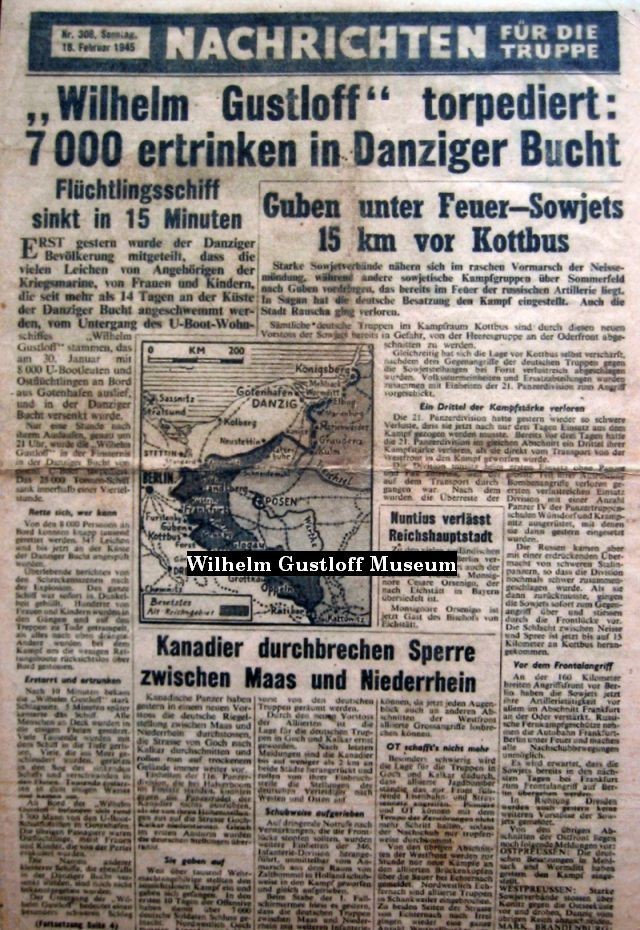
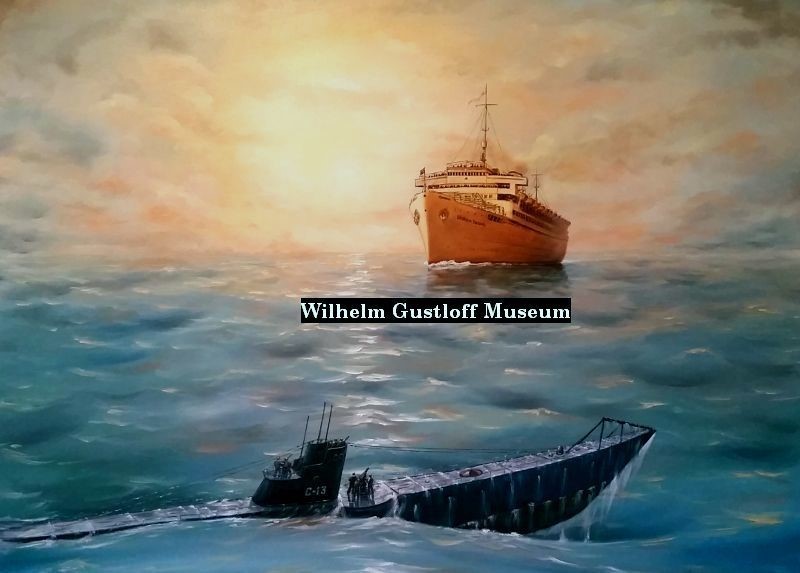
Left:
The Wilhelm Gustloff meets the S-13 Painting
Artist: Sejar Bekirow, 2006
60cm x 80cm
Oil on Canvas
This painting has made its rounds online, and I was able to add it to the museum collection in 2017. It is a fantasy piece, not accurate.
Right:
The Sinking of the Wilhelm Gustloff
Artist: Edward Petruskevich, 2018
12"x16" - Watercolor on Canvas
My first attempt at a Gustloff painting - admittedly not my best work.
The Wilhelm Gustloff meets the S-13 Painting
Artist: Sejar Bekirow, 2006
60cm x 80cm
Oil on Canvas
This painting has made its rounds online, and I was able to add it to the museum collection in 2017. It is a fantasy piece, not accurate.
Right:
The Sinking of the Wilhelm Gustloff
Artist: Edward Petruskevich, 2018
12"x16" - Watercolor on Canvas
My first attempt at a Gustloff painting - admittedly not my best work.
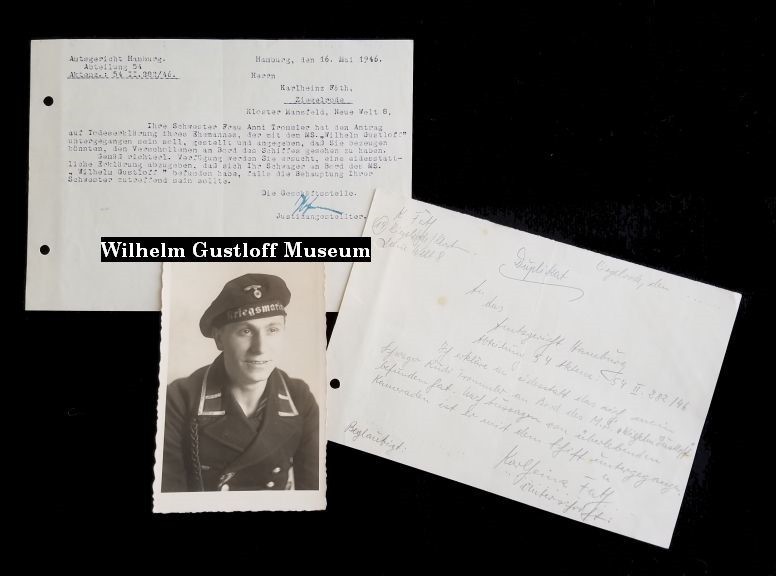
Confirmation of a Death on the Wilhelm Gustloff
*Thanks for Werner Hinke for translating as always!
Letter #1 - District Court Hamburg: Department 54
Hamburg, May 16, 1946.
Mr. Karlheinz Fäth,
Ziegelrode
Monastery Mansfeld, New World 8.
Your sister, Mrs. Anni Trommler, has filed an application for her husband's declaration of death having gone down with the M.S."Wilhelm Gustloff" and stated that you could testify to having seen the missing person aboard the ship. According to judge, you are requested to make an affidavit that your brother-in-law was aboard the M.S."Wilhelm Gustloff" if the claim of your sister was correct.
The Office of the Court Clerk.
Letter #2 - To the Hamburg District Court
Department 54, File No. 54 II / 282/46
I declare under oath that my brother-in-law, Rudi Trommler, was aboard the M.S. Wilhelm Gustloff. According to surviving comrades, he went down with the ship.
Karlheinz Fäth
Certified Signature
*The photo that came with it is of Karlheinz. These were part of a larger collection of documents from Karlheinz that dated from his time in World War II and afterwards.
*Thanks for Werner Hinke for translating as always!
Letter #1 - District Court Hamburg: Department 54
Hamburg, May 16, 1946.
Mr. Karlheinz Fäth,
Ziegelrode
Monastery Mansfeld, New World 8.
Your sister, Mrs. Anni Trommler, has filed an application for her husband's declaration of death having gone down with the M.S."Wilhelm Gustloff" and stated that you could testify to having seen the missing person aboard the ship. According to judge, you are requested to make an affidavit that your brother-in-law was aboard the M.S."Wilhelm Gustloff" if the claim of your sister was correct.
The Office of the Court Clerk.
Letter #2 - To the Hamburg District Court
Department 54, File No. 54 II / 282/46
I declare under oath that my brother-in-law, Rudi Trommler, was aboard the M.S. Wilhelm Gustloff. According to surviving comrades, he went down with the ship.
Karlheinz Fäth
Certified Signature
*The photo that came with it is of Karlheinz. These were part of a larger collection of documents from Karlheinz that dated from his time in World War II and afterwards.
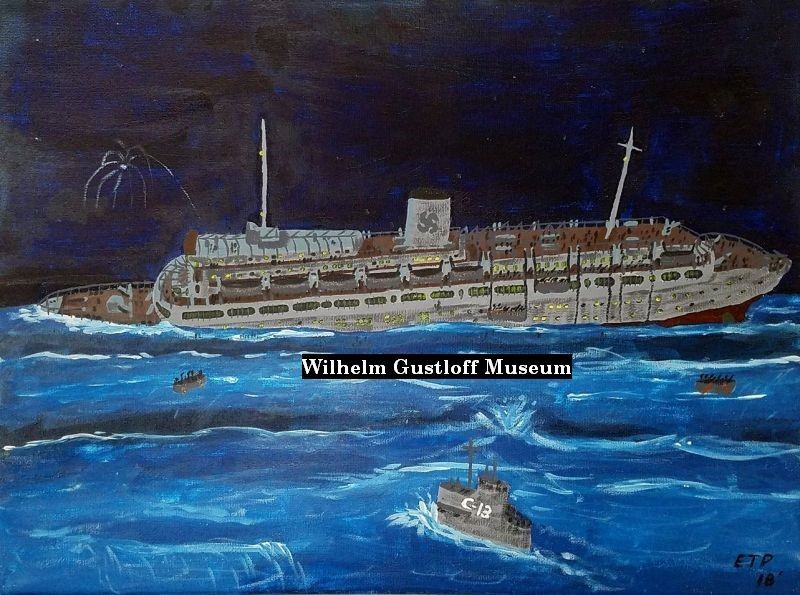

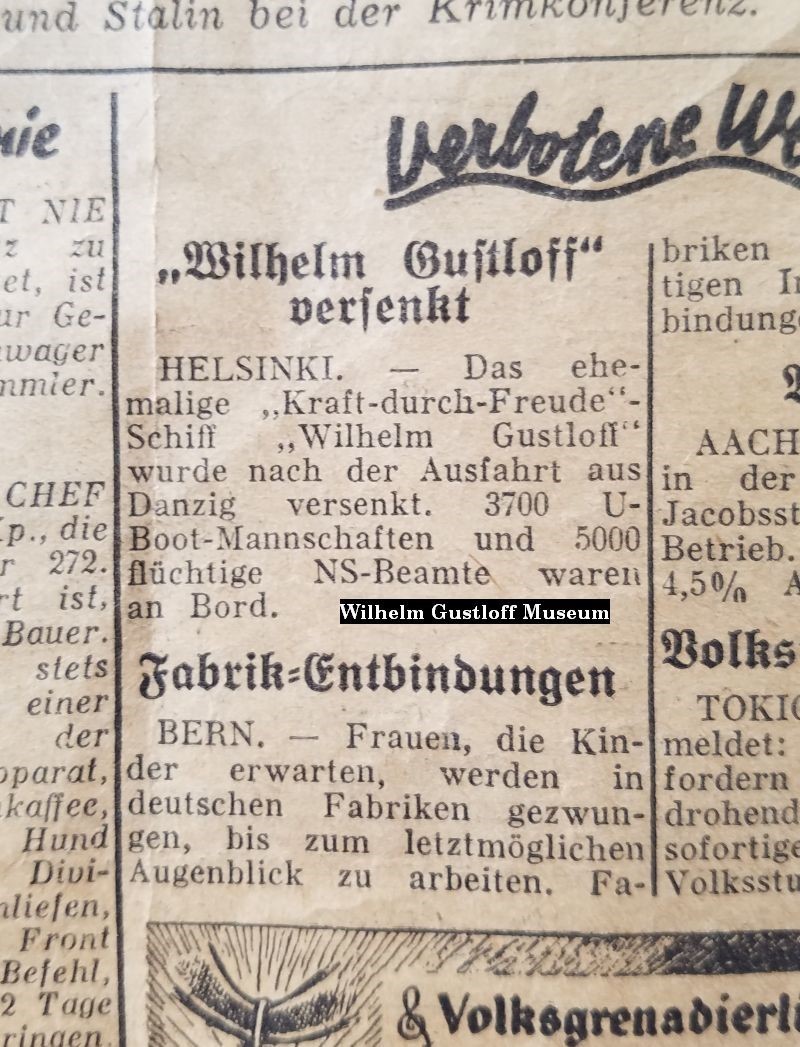
Feldpost - February 1945.
Edited by the American Army in Western Europe.
"Wilhelm Gustloff Sinks"
Helsinki - The former "Kraft durch freude" ship "Wilhelm Gustloff" was sunk after her exit from Danzig. 3,700 submariners and 5,000 fleeing NS officials were on board.
Edited by the American Army in Western Europe.
"Wilhelm Gustloff Sinks"
Helsinki - The former "Kraft durch freude" ship "Wilhelm Gustloff" was sunk after her exit from Danzig. 3,700 submariners and 5,000 fleeing NS officials were on board.
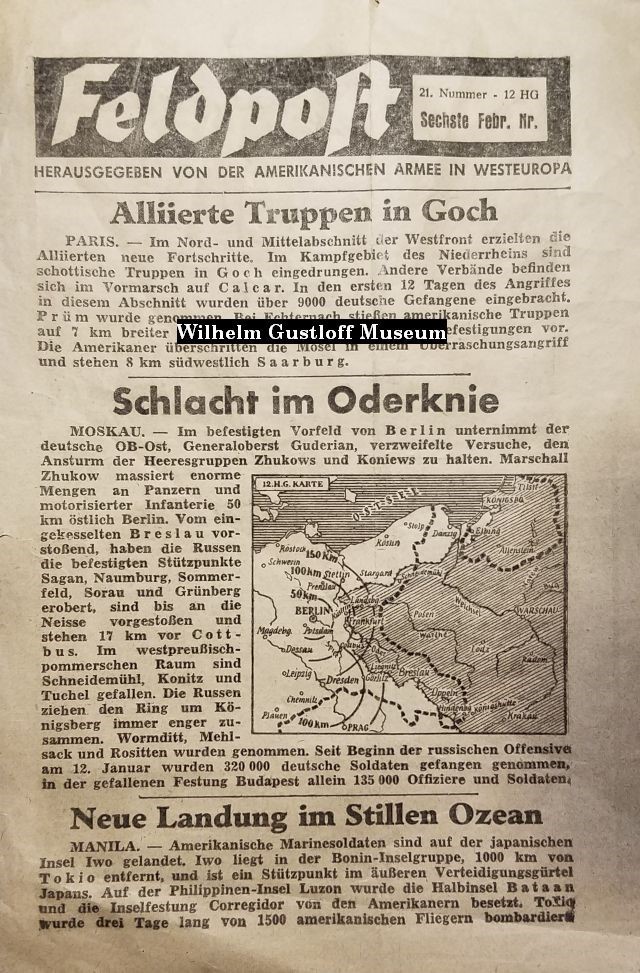
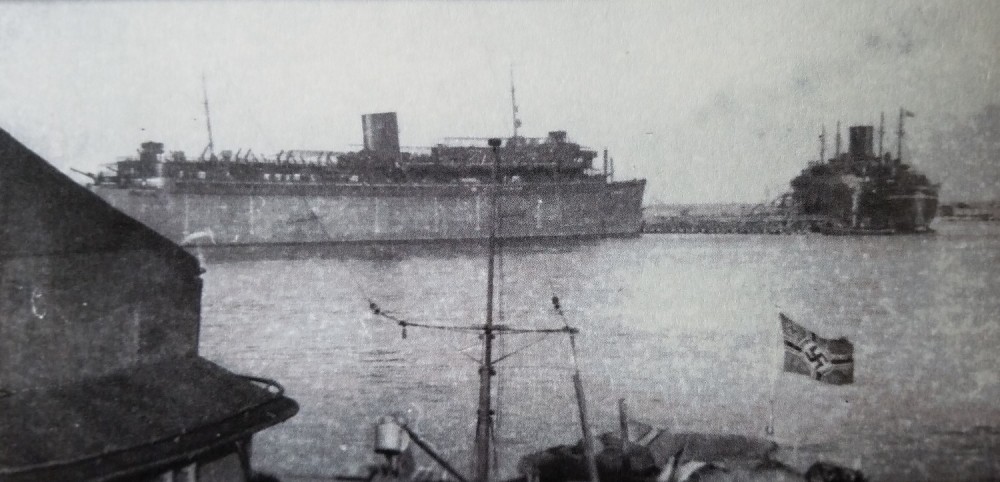
Georgi Family Documents from the Wilhelm Gustloff Sinking
- Letter from his parents residence to Mr. Georgi dated February 24th, 1945.
- Naval Document Centre's letter informing Mr. Georgi of his brother-in-law's death on the Gustloff. March 22nd, 1948.
- Newspaper article on the sinking from 1951. (Translations under Post-War Publications).
- Newspaper article on the sinking - undated, likely 1950s.
- Letter from his parents residence to Mr. Georgi dated February 24th, 1945.
- Naval Document Centre's letter informing Mr. Georgi of his brother-in-law's death on the Gustloff. March 22nd, 1948.
- Newspaper article on the sinking from 1951. (Translations under Post-War Publications).
- Newspaper article on the sinking - undated, likely 1950s.

*Mr. Georgi wrote a letter to his parents in Gotenhafen in February, 1945. The person that was staying at their address replied with this letter:
Translated by Werner Hinke.
Gotenhafen, February 24th, 1945
Dear Georgi Family,
It is difficult; it is terribly difficult for me to write you these lines.
First of all, my deepest condolences on the gravest loss of your parents and son-in-law unknown to me.
Do carry your pain with pride; you too gave your best for our port. I've been assigned this apartment by L. Lunger, the Marine staff assistant. I want you to know that everything remains as I found it, clean and tidy. One rarely finds such a clean and cozyhome, so sad for me to live here at the moment. I consider myself lucky to care for this home even if there were refugees in it, it was a sin, it will not happen that way.
The beds and linen are gone; everything seems to have been taken along, only all the dishes, and some sofa cushions and the furniture are there. I don't know if you already know. Your parents and son-in-law went out on the steamer W. Gustloff, Gustloff was torpedoed by the Russian, 1,100 people were saved from 5,000.
Please, dear family Georgi, do not be angry with me, I wanted to write to you, if you have any wish, please let me know. I have to stay here. I can't leave. My home Cottbus is also threatened, where my parents are I do not know at the moment either. Life is so hard and cruel, I wish it was all over.
Once again, my deepest condolences,
Greeting you, not having known you,
Your staff assistant Lisa Lunger
Gotenhafen Adolf-Hitlerplatz 18
C/o Obigl
Translated by Werner Hinke.
Gotenhafen, February 24th, 1945
Dear Georgi Family,
It is difficult; it is terribly difficult for me to write you these lines.
First of all, my deepest condolences on the gravest loss of your parents and son-in-law unknown to me.
Do carry your pain with pride; you too gave your best for our port. I've been assigned this apartment by L. Lunger, the Marine staff assistant. I want you to know that everything remains as I found it, clean and tidy. One rarely finds such a clean and cozyhome, so sad for me to live here at the moment. I consider myself lucky to care for this home even if there were refugees in it, it was a sin, it will not happen that way.
The beds and linen are gone; everything seems to have been taken along, only all the dishes, and some sofa cushions and the furniture are there. I don't know if you already know. Your parents and son-in-law went out on the steamer W. Gustloff, Gustloff was torpedoed by the Russian, 1,100 people were saved from 5,000.
Please, dear family Georgi, do not be angry with me, I wanted to write to you, if you have any wish, please let me know. I have to stay here. I can't leave. My home Cottbus is also threatened, where my parents are I do not know at the moment either. Life is so hard and cruel, I wish it was all over.
Once again, my deepest condolences,
Greeting you, not having known you,
Your staff assistant Lisa Lunger
Gotenhafen Adolf-Hitlerplatz 18
C/o Obigl

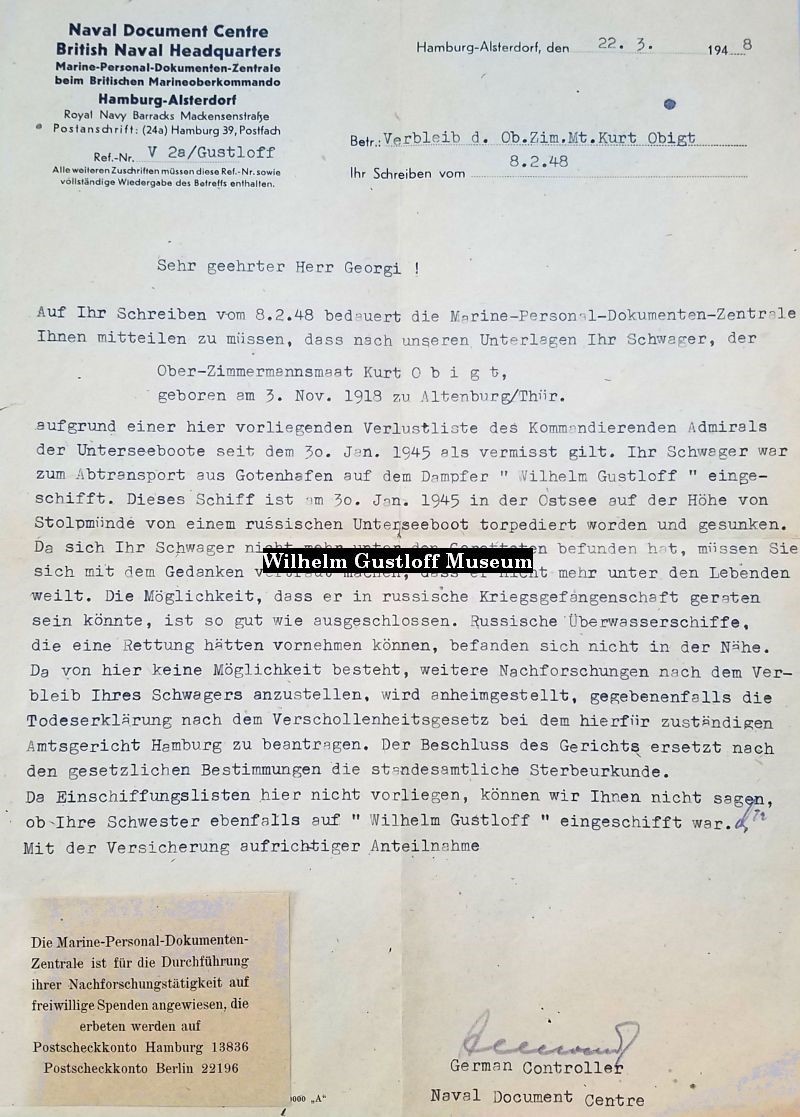
Naval Document Centre Hamburg-Alsterdorf, den March 22nd, 1948.
British Naval Headquarters
Navy - Personnel - Documents - Central
At the British Navy High Command
Ref-Nr. V28 / Gustloff
Re: Whereabouts of Ob.Zim.Mt. Kurt Obigt
Dear Mr. Georgi,
Regarding your letter of 8.2.48, the Marine Personnel Documentation Center is anxious to inform you that your brother-in-law,
The petty officer carpenter Kurt Obigt,
born on 3. Nov. 1918 in Altenburg / Thür.
Is considered missing because there is no list by the Commanding Admiral of the submarines from January 30, 1945. Your brother-in-law was embarked for transport from Gotenhafen on the steamer Wilhelm Gustloff. He has been listed as "missing " as of the 30.1.1945. The Commanding Admiral of the U-boats has included his name on the list of missing persons on 12.4.45. We have reviewed this list. This ship was torpedoed on 31.1.45 by a Russian submarine and sank near Stolpemünde in the Baltic Sea. He was not among the survivors. You must therefore accept the idea that he is no longer among the living. The possibility of him becoming a Russian prisoner is non existent. There were no Russian surface ships in the vicinity. We have no record of soldiers rescued or imprisoned by the Russians. Since there is no possibility to make further inquiries into the whereabouts of your brother-in-law, it is left to request, if necessary, the declaration of death according to the disappearance law at the competent district court of Hamburg. The decision of the court replaces that there are no embarkation lists, we can not tell you whether your sister was also inscribed on Wilhelm Gustloff. With the insurance sincerity,
German Controller
Naval Document Centre
The Navy Personnel Center is reliant on voluntary donations requested to carry out its investigative work.
British Naval Headquarters
Navy - Personnel - Documents - Central
At the British Navy High Command
Ref-Nr. V28 / Gustloff
Re: Whereabouts of Ob.Zim.Mt. Kurt Obigt
Dear Mr. Georgi,
Regarding your letter of 8.2.48, the Marine Personnel Documentation Center is anxious to inform you that your brother-in-law,
The petty officer carpenter Kurt Obigt,
born on 3. Nov. 1918 in Altenburg / Thür.
Is considered missing because there is no list by the Commanding Admiral of the submarines from January 30, 1945. Your brother-in-law was embarked for transport from Gotenhafen on the steamer Wilhelm Gustloff. He has been listed as "missing " as of the 30.1.1945. The Commanding Admiral of the U-boats has included his name on the list of missing persons on 12.4.45. We have reviewed this list. This ship was torpedoed on 31.1.45 by a Russian submarine and sank near Stolpemünde in the Baltic Sea. He was not among the survivors. You must therefore accept the idea that he is no longer among the living. The possibility of him becoming a Russian prisoner is non existent. There were no Russian surface ships in the vicinity. We have no record of soldiers rescued or imprisoned by the Russians. Since there is no possibility to make further inquiries into the whereabouts of your brother-in-law, it is left to request, if necessary, the declaration of death according to the disappearance law at the competent district court of Hamburg. The decision of the court replaces that there are no embarkation lists, we can not tell you whether your sister was also inscribed on Wilhelm Gustloff. With the insurance sincerity,
German Controller
Naval Document Centre
The Navy Personnel Center is reliant on voluntary donations requested to carry out its investigative work.
Captain Paul Vollrath Walter Salk Horst Woit Rose Petrus Helga Knickerbocker Leonilla Zobs Bill J. Hans Rittner Milda Bendrich Irene E.
The Monte Rosa / HMT Empire Windrush
One of the few KdF liners to survive the war was the Monte Rosa (Photo No. 1). Captured by the British in 1945, she was renamed the HMT Empire Windrush and used as a troopship for the British Government. On March 28th, 1954, a fuel line ruptured and the ship caught fire off the coast of Algiers with 1,276 personnel and 222 crew. There were only 4 killed in the initial explosion, and while being towed, she broke free and sank beneath the waves a day later.
Right: Photos of the Empire Windrush on fire and the evacuation to other ships. The last two photos are of a Variety Concert Pamphlet that was held aboard the Windrush on September 17th, 1947.
One of the few KdF liners to survive the war was the Monte Rosa (Photo No. 1). Captured by the British in 1945, she was renamed the HMT Empire Windrush and used as a troopship for the British Government. On March 28th, 1954, a fuel line ruptured and the ship caught fire off the coast of Algiers with 1,276 personnel and 222 crew. There were only 4 killed in the initial explosion, and while being towed, she broke free and sank beneath the waves a day later.
Right: Photos of the Empire Windrush on fire and the evacuation to other ships. The last two photos are of a Variety Concert Pamphlet that was held aboard the Windrush on September 17th, 1947.
JD-Contractor A/S Denmark. Joint Wreck Expedition to the Baltic Sea.
Spring 2019 scans and sonar video of the wreck of the Wilhelm Gustloff.
Webpage HERE.
Spring 2019 scans and sonar video of the wreck of the Wilhelm Gustloff.
Webpage HERE.
Wilhelm Gustloff Lighting Switch
In March of 2020, I was contacted by the same diver that I purchased the above mosaic from. He was doing some cleaning and came across this piece which he forgot about and offered it to me. It was the last item he had which he recovered from the wreck.
Recovered in 1993, he found this Beleuchtung 2 switch, or Lighting 2 switch within the debris field of the Gustloff. Unfortunately, there isn't any more information to go with it, but being in the main debris field, it was likely recovered near one of the upper decks or by the hole in the bow. He said he believed it was blown off the hull when the dynamite was detonated to collapse the wreck onto itself.
I thought I might be able to find similar switches in the few photographs of the bridge that I have, but I was not able to. The closest I've come was in a still of the movie Die Gustloff (below) where the navigation lights are switched on at night. It is interesting to think which lights these would've turned on within the ship.
In March of 2020, I was contacted by the same diver that I purchased the above mosaic from. He was doing some cleaning and came across this piece which he forgot about and offered it to me. It was the last item he had which he recovered from the wreck.
Recovered in 1993, he found this Beleuchtung 2 switch, or Lighting 2 switch within the debris field of the Gustloff. Unfortunately, there isn't any more information to go with it, but being in the main debris field, it was likely recovered near one of the upper decks or by the hole in the bow. He said he believed it was blown off the hull when the dynamite was detonated to collapse the wreck onto itself.
I thought I might be able to find similar switches in the few photographs of the bridge that I have, but I was not able to. The closest I've come was in a still of the movie Die Gustloff (below) where the navigation lights are switched on at night. It is interesting to think which lights these would've turned on within the ship.
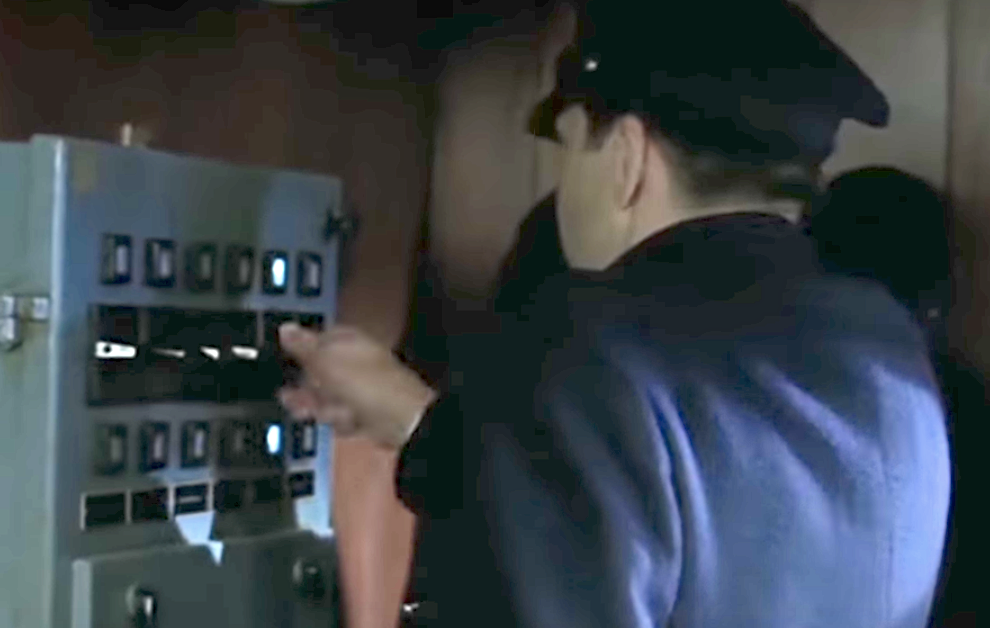
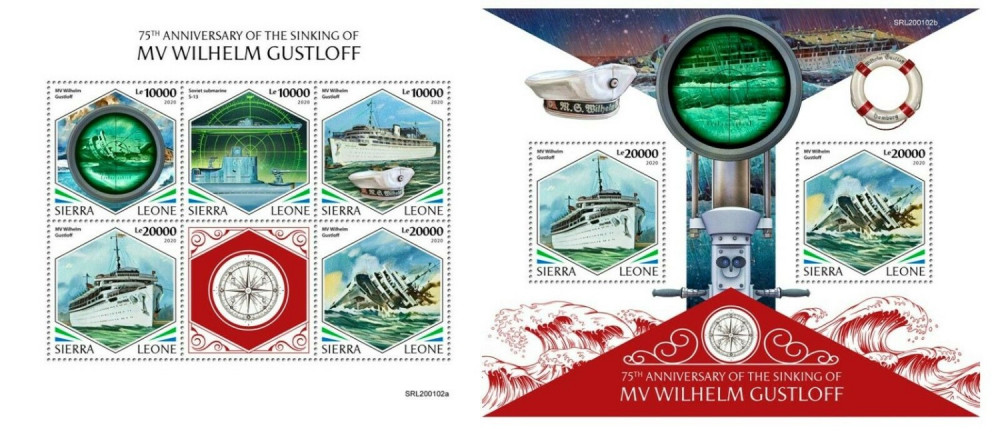
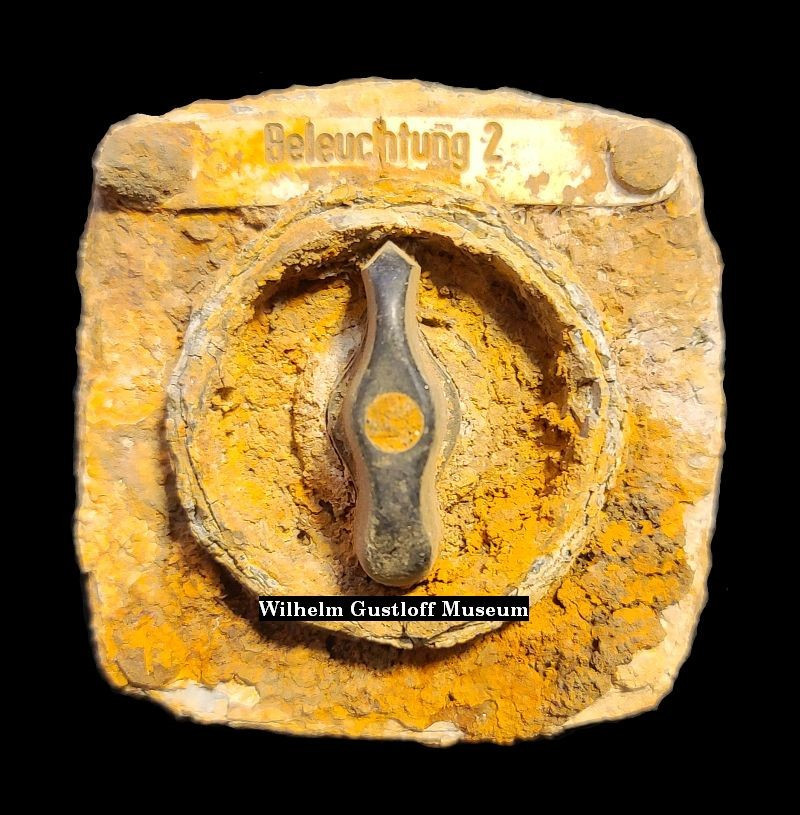

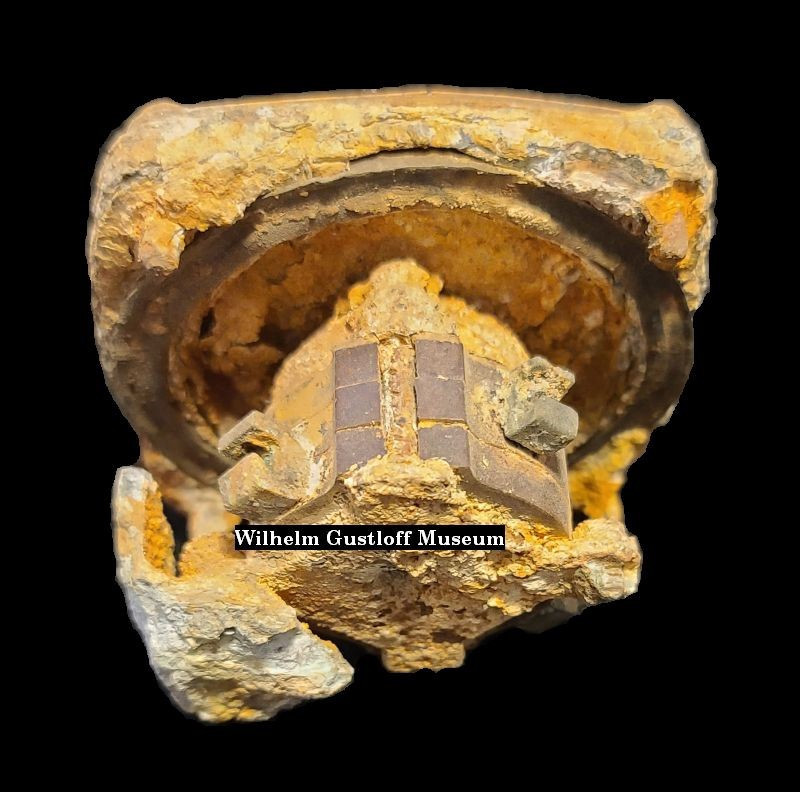

1940s Newspaper Article on the Sinking of the General von Steuben
Click Here
Click Here
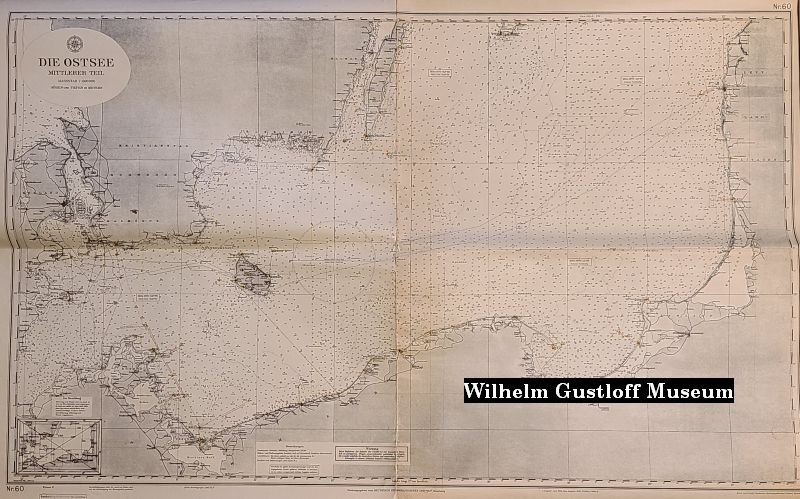
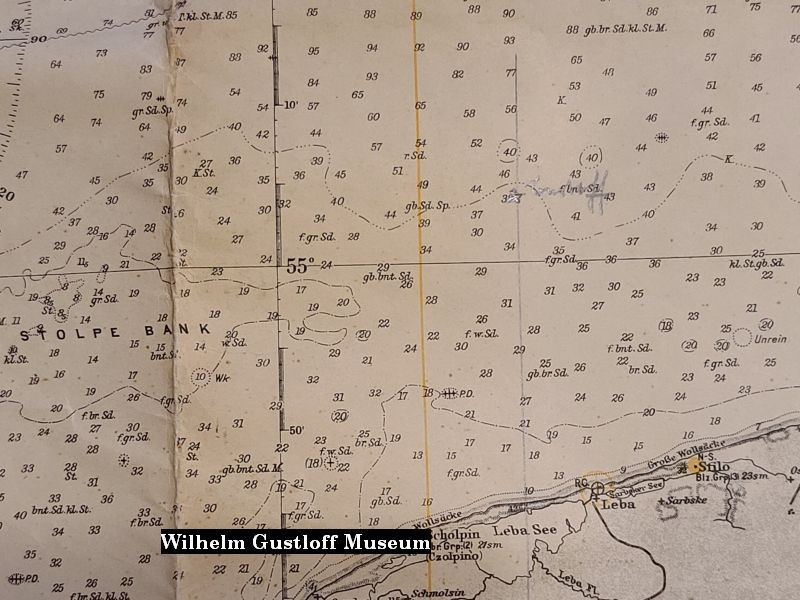
1968 navigation chart of the Baltic Sea with the location of the Wilhelm Gustloff marked in pencil. Donation of this map was made in memory of Manuel Hinke, German Navy, SSS Horst Wessel, renamed USCG Eagle.
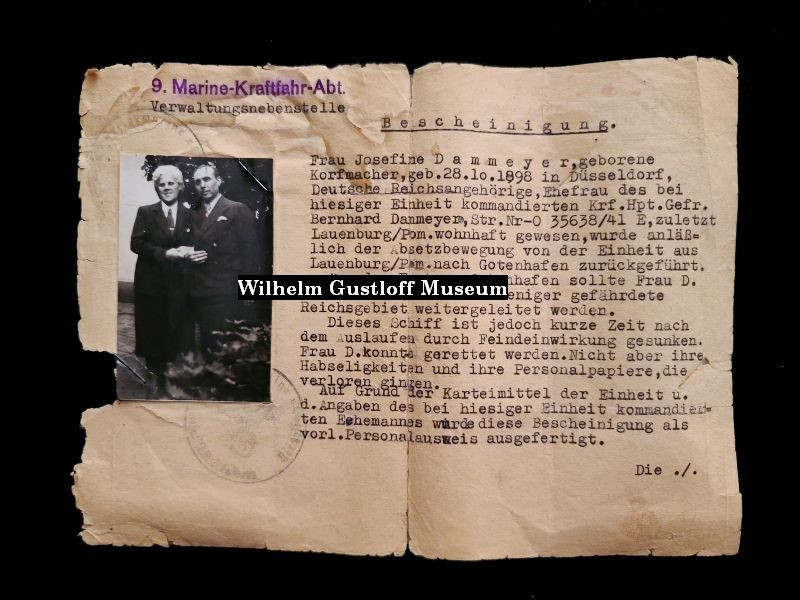
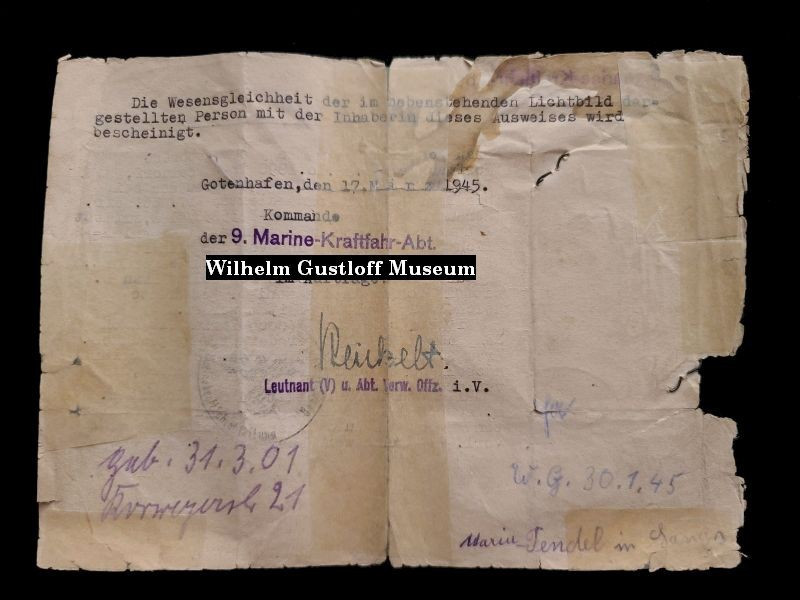
Personal document for Mrs. Josefine Dammeyer, who was aboard the Wilhelm Gustloff when it was torpedoed and survived.
The back has W.G. 30.1.45 written in to identify the ship sunk. Issued in Gotenhafen on March 17th, 1945.
"At the Gotenhafen fortress, Ms. D. was to be transferred by ship to the less endangered area of the Reich. However, this ship sank due to enemy action a short time after sailing. Mrs. D. could be saved, but not her belongings and her personal papers, which were lost.... this certificate was issued as a preliminary identity card.
The identity of the person presented in the adjacent photo with the holder of this ID is certified.
Gotenhafen, March 17, 1945."
The back has W.G. 30.1.45 written in to identify the ship sunk. Issued in Gotenhafen on March 17th, 1945.
III Copy at Gotenhafen on March 6, 1945.
In front of me, the undersigned notary representative Rechtsanwelt Erich Lau, Gotenhafen, as the officially appointed representative of the notary Dr. Otto Luck in Gotenhafen appeared today:
the business owner, Ms. Lilly Neudeck, née Albrecht in Gotenhafen, Ganghofer-Weg 7 flat 5. The person appearing is not known personally to the notary's representative. She proves herself by showing her return ID No. 003665 with a photo.
The person appearing stated:
My following family members were on board the steamer "Wilhelm Gustloff"
1. My daughter Ilse Kallaste née Neudeck, born on October 17, 1926.
2. Her husband, the thiologist Vaino, born on May 14, 1916.
3. Their children Valdo, born on October 27th, 1939 and Inge, born on October 9th, 1942.
4. My daughter Siegrid Neudeck, born on February 4, 1924.
5. the mother of my sister-in-law, Mrs. Lieu Kallaste 53 years old.
According to the information from the sea commandant for West Prussia in Gotenhafen on February 26, 1945, the aforementioned persons are considered missing due to the sinking of the steamer "Wilhelm Gustloff" on January 30, 1945. I haven't received any further messages in the meantime.
These are my lone daughters and grandchildren. According to his announcement, the father of my son-in-law has been dead for 26 years, my son-in-law had no siblings. My husband, the merchant Paul Neudeck, is still alive. Like both, therefore, come into Prague alone as heirs. However, the inheritance certificate can still be issued, as the death declaration of the family members who have been denied is not yet possible for the time being.
I affirm in lieu of an oath that the information I have given above is true in all respects. are taken from the certificate of the sea commander dated 02.26.1945. I was informed of the importance of an affidavit by the notary's representative.
The minutes were read out, approved and signed by the person appearing:
total Lilly Neudeck née Albrecht
total Erich Lau Notary Representative
This negotiation is being carried out for the third time, and this copy has been issued to the business owner, Ms. Lilly Neudeck, née Albrecht in Gotenhafen, Gangholfer-Weg 7, apartment 5.
Gotenhafen, March 9, 1945
Notary Representative.
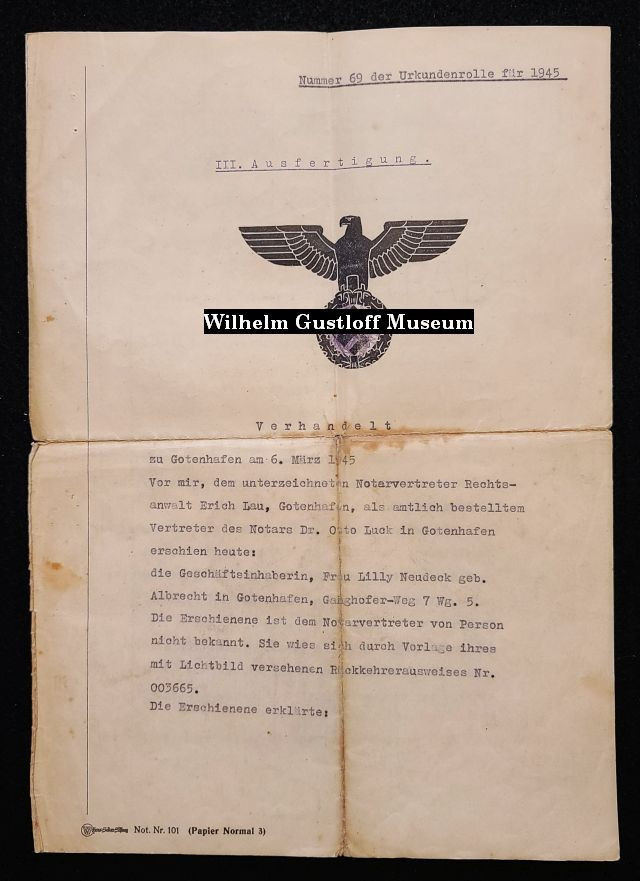
LOST / STOLEN AUSWEIS FUR M.S. WILHELM GUSTLOFF FROM USPS NORFOLK / HAMPTON!
On December 31st, 2021, I found and purchased another Wilhelm Gustloff Ausweis and newspaper clipping from Germany. After arriving in Norfolk, VA, it left their facility on January 25th, 2022 and never arrived in Hampton at my post office box. I also ordered additional paperwork the day after I purchased the boarding passes from the same person that went with the ausweis. It left Norfolk the day after and arrived a day later. (Last three photos).
The ausweis is for Maria Wischeropp, Throdor Storm-Weg 12, Gotenhafen. It was likely in a plain brown envelope with a tracking number ending in 1756. It contained both ausweis and newspaper clipping - "Da liegt die "Wilhelm Gustloff" - Das Grab fur 5300 Menschen". I have no idea why it made it from Germany to Chicago, then Norfolk and all of a sudden got lost. Tracking number RR797281756DE. If someone is reading this who found it and it trying to look up something about it, please return it to my NEW ADDRESS on the Introduction Page.
The ausweis is for Maria Wischeropp, Throdor Storm-Weg 12, Gotenhafen. It was likely in a plain brown envelope with a tracking number ending in 1756. It contained both ausweis and newspaper clipping - "Da liegt die "Wilhelm Gustloff" - Das Grab fur 5300 Menschen". I have no idea why it made it from Germany to Chicago, then Norfolk and all of a sudden got lost. Tracking number RR797281756DE. If someone is reading this who found it and it trying to look up something about it, please return it to my NEW ADDRESS on the Introduction Page.
The Jerzy Janczukowicz Wilhelm Gustloff Artifact Collection
Jerzy Janczukowicz. The most famous name in diving on the wreck of the Wilhelm Gustloff. Not only because he holds the record for the most dives anyone has ever taken to the wreck, but because of the artifacts he recovered from the wreck. President of the diving club "Rekin" in Gdansk, Jerzy took dives with his club in 1973 to make an inventory and check the condition of the wreck with the cooperation of the local authorities. There was a cover story that they were searching for the lost Amber Room, which created a media sensation at the time, but this was not the primary reason for the expedition.
During these dives, Jerzy - along with team members including Michal Rybicki - recovered several artifacts including:
- A bronze chandelier from the Gustloff's Smoking Lounge - one of 9 ever made. It was only brought up because it was originally thought it was a safe.
- An optical viewfinder that would've gone on top of the ship's compass on the bridge wing. Recovered near the bridge and likely used the night of the sinking.
- A pane of porthole glass without the bronze surrounding. Possibly from one of the Gustloff's dining rooms, since these portholes had the glass section rotate open for air.
- Two staircase boards with metal grips which would've been used on the outside decks.
- Their anchor snagged on a section of staircase railing, which was also raised from one of the outside staircases.
- Other items were recovered, including a rear mast light, but disappeared shortly afterwards.
In August of 1973, all of the artifacts ended up at the Maritime Office in Gdynia initially, but later, were returned to Jerzy at Club Rekin. A silver decorative pot with handkerchiefs was also recovered and given to a woman who lost her mother and sisters in the sinking.
During these dives, Jerzy - along with team members including Michal Rybicki - recovered several artifacts including:
- A bronze chandelier from the Gustloff's Smoking Lounge - one of 9 ever made. It was only brought up because it was originally thought it was a safe.
- An optical viewfinder that would've gone on top of the ship's compass on the bridge wing. Recovered near the bridge and likely used the night of the sinking.
- A pane of porthole glass without the bronze surrounding. Possibly from one of the Gustloff's dining rooms, since these portholes had the glass section rotate open for air.
- Two staircase boards with metal grips which would've been used on the outside decks.
- Their anchor snagged on a section of staircase railing, which was also raised from one of the outside staircases.
- Other items were recovered, including a rear mast light, but disappeared shortly afterwards.
In August of 1973, all of the artifacts ended up at the Maritime Office in Gdynia initially, but later, were returned to Jerzy at Club Rekin. A silver decorative pot with handkerchiefs was also recovered and given to a woman who lost her mother and sisters in the sinking.
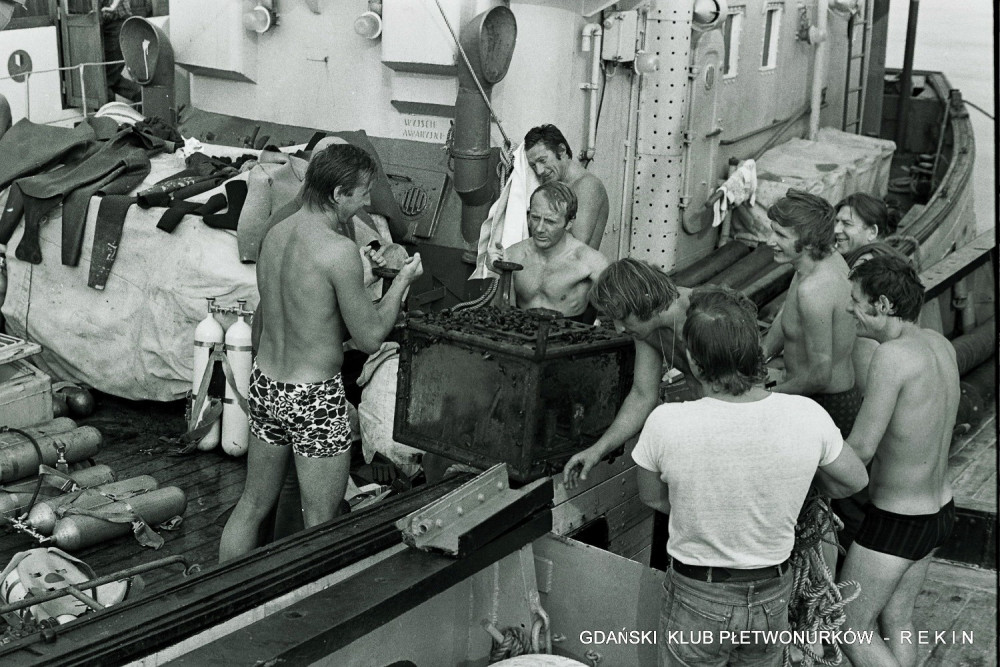

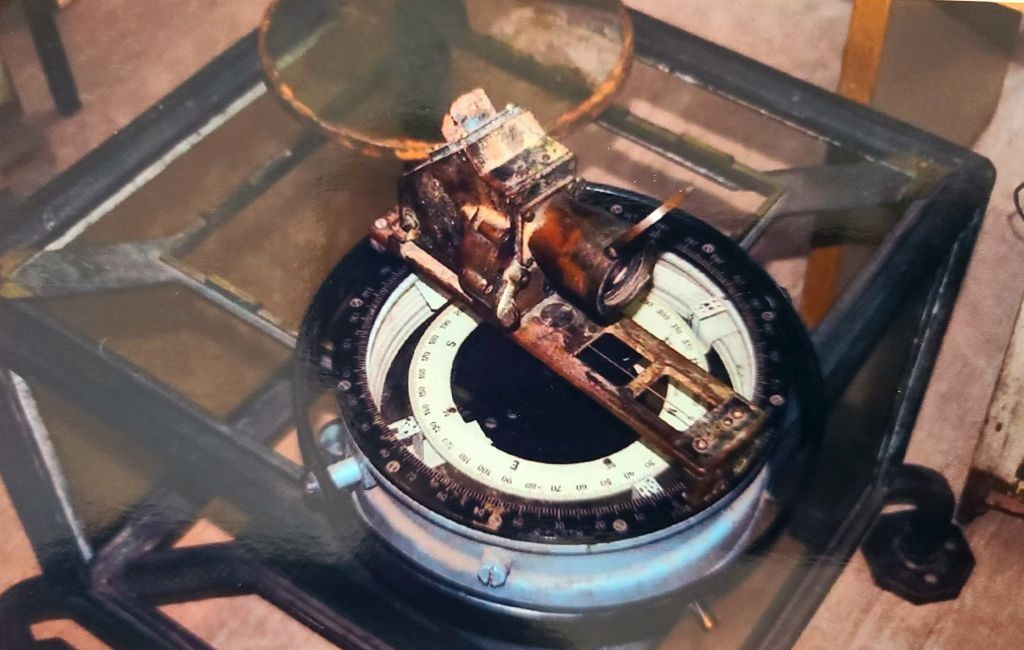
From 1973 onward, all of these artifacts sat proudly at Jerzy's home in Poland (below). Above Right: The chandelier being recovered. Left: Jerzy with the viewfinder. Right: The chandelier, viewfinder and glass porthole in Jerzy's living room.
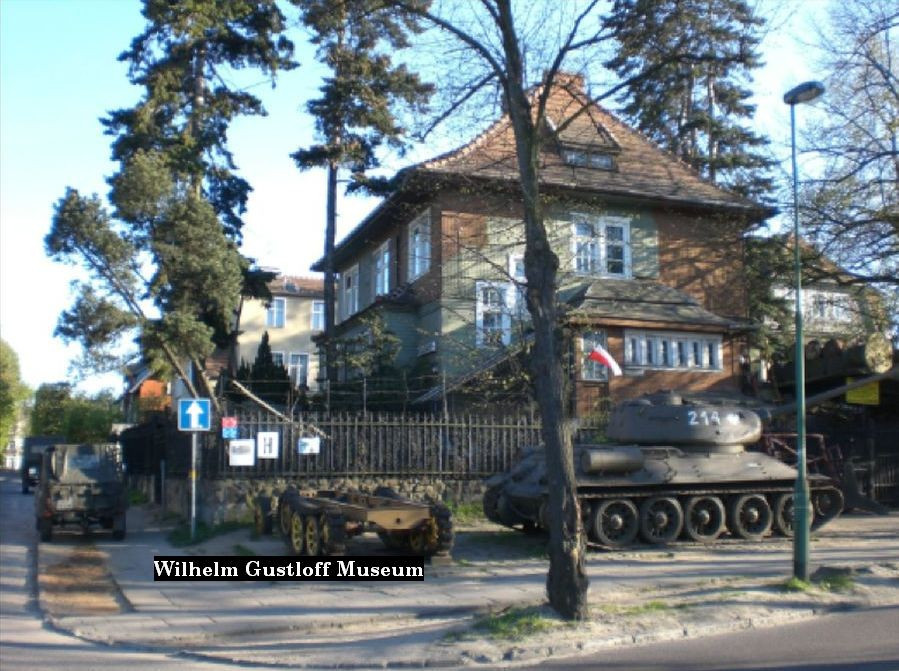
In 2015, while author Ruta Sepetys was working on her book "Salt to the Sea", she was able to visit Jerzy at his home as so many other Gustloff enthusiasts have done before. During that time, I was also assisting her with information on the Wilhelm Gustloff from my archives and we had a shared interest over the recovered items. She was able to meet with Jerzy, Michal Rybicki, and her translator to view, discuss, and hold the Wilhelm Gustloff artifacts. Ruta was kind enough to share her images with me of her time there.
1: Ruta viewing the artifacts in Jerzy's living room. 2: Ruta and Jerzy with his collection. 3: An internet sourced photo with a clear view of Jerzy's artifacts. 4: The porthole, viewfinder, and one of the stair boards. 5: Jerzy holding his porthole. 6: Jerzy discussing the viewfinder while Michal holds it. 7: Ruta with her interpreter holding the porthole. 8 & 9: The staircase railing recovered, which sat outside to the entrance. 10: Jerzy showing the interpreter where one of the wooden boards went into the slat on the railing edge.
1: Ruta viewing the artifacts in Jerzy's living room. 2: Ruta and Jerzy with his collection. 3: An internet sourced photo with a clear view of Jerzy's artifacts. 4: The porthole, viewfinder, and one of the stair boards. 5: Jerzy holding his porthole. 6: Jerzy discussing the viewfinder while Michal holds it. 7: Ruta with her interpreter holding the porthole. 8 & 9: The staircase railing recovered, which sat outside to the entrance. 10: Jerzy showing the interpreter where one of the wooden boards went into the slat on the railing edge.
Sadly, on July 27th, 2020, Jerzy passed away in Gdansk. Over the course of the next year, it was unclear what would happen to Jerzy's artifact collection, though it would likely remain with Club Rekin at their headquarters in Poland.
August 16th, 2021 - 5:12pm EST. A writer named Natalia contacted me on Facebook explaining that she was working on a book about Jerzy and his life. She asked me if I had any other information about him I could share for her publication. While I told her what I knew, the conversation quickly turned to his artifacts, and my interest in tracking down their current whereabouts. As fate would have it, she informed me that she knew who had inherited the collection and he was willing to take offers on some of the pieces. She gave me his email, and after a year of negotiations, I was able to purchase the porthole glass, optical viewfinder, and two stair boards that once proudly sat in Jerzy's living room since 1973!
August 16th, 2021 - 5:12pm EST. A writer named Natalia contacted me on Facebook explaining that she was working on a book about Jerzy and his life. She asked me if I had any other information about him I could share for her publication. While I told her what I knew, the conversation quickly turned to his artifacts, and my interest in tracking down their current whereabouts. As fate would have it, she informed me that she knew who had inherited the collection and he was willing to take offers on some of the pieces. She gave me his email, and after a year of negotiations, I was able to purchase the porthole glass, optical viewfinder, and two stair boards that once proudly sat in Jerzy's living room since 1973!
I wanted to make an offer on the staircase railing, but realistically knew that it would be almost impossible to get something of that size safely from Poland to Virginia. I had also hoped to acquire the Smoking Lounge chandelier, however, it was not something he was willing to yet part with. Perhaps someday it will also make its way into the collection.
I am still humbled and honored that he would allow me to add these to the collection, and along with the photographs, keep the memory of Jerzy Janczukowicz alive within the Wilhelm Gustloff community. The artifacts finally arrived on February 22nd, 2022 and took their new place in the museum room.
I am still humbled and honored that he would allow me to add these to the collection, and along with the photographs, keep the memory of Jerzy Janczukowicz alive within the Wilhelm Gustloff community. The artifacts finally arrived on February 22nd, 2022 and took their new place in the museum room.
I have also created a binder that documents everything imaginable related to these pieces and their journey from 1938 to 2022. It includes all email correspondence, receipts, conversations, photographs, newspaper clippings, and translated online articles relating to Jerzy and his collection. The magazine OKRETY also belonged to Jerzy, and was given to Ruta Sepetys during her visit. She graciously donated it to the museum collection. A full copy of the 1973 diving report was provided by the Gdansk Maritime Office in Poland.
Below: Jerzy Janczukowicz's artifacts now in the Wilhelm Gustloff Museum collection.
Right: The original locations of the recovered artifacts from the Wilhelm Gustloff. Smoking Lounge, portholes, compass on the bridge, staircases on the outer decks.
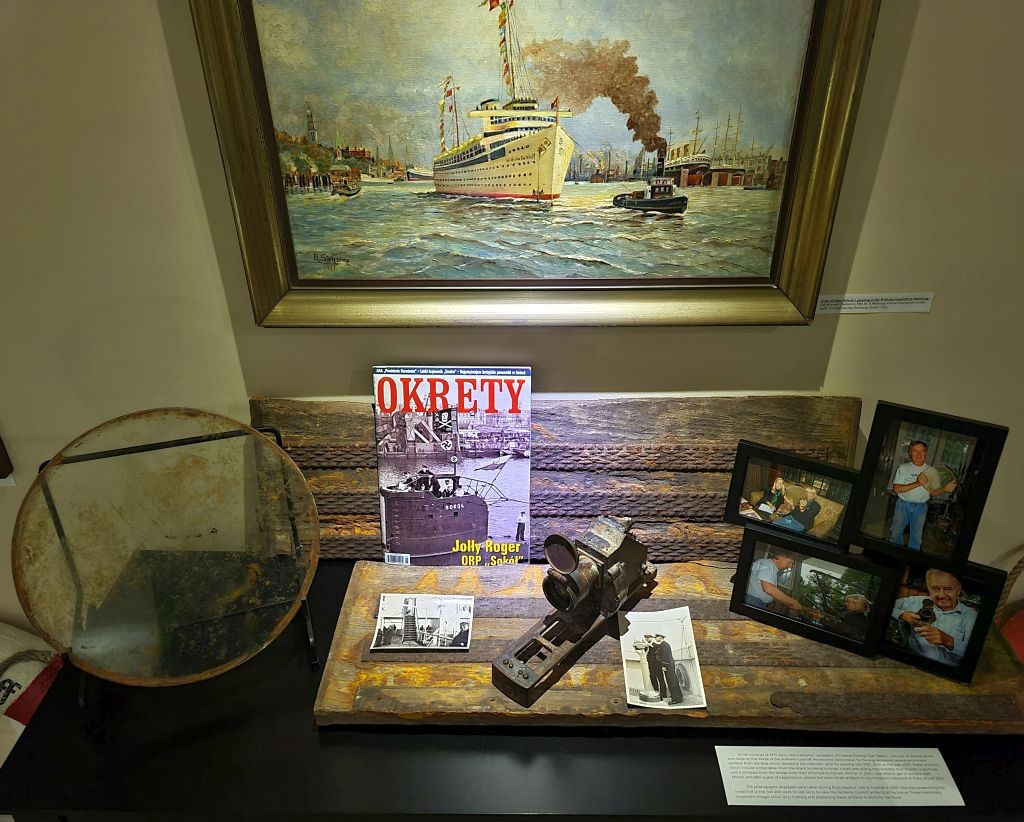
In 2022, I received the following email:
"Dear Mr. Petruskevich, With great pleasure I have studied the comprehensive information and exhibits that you have compiled. Thank you very much for taking on this subject. In this way, the many victims of this tragedy will not be forgotten. In particular, I became aware of the obituary of Gertrud Schmitt (née Herings) on display. I grew up with the story of the Wilhelm Gustloff, as my mother Helene Wenner (née Herings) was the sister of the deceased Gertrud Schmitt (née Herings). The obituary you issued therefore refers to my aunt. My aunt fled the approaching Eastern Front in 1944/1945, and was a naval aide during the war years. Brief description of our family on my mother's side: My grandfather Leonhard Herings married Mrs. Gertrud Junker. Nine children were born of this marriage. The two sons died in infancy. The remaining seven girls survived. My mother Helene Wenner was born on 19.10.1925. Her older sister Gertrud was born on 21.03.1921. The family lived in *******. The house is still in my possession today. I have once enclosed a copy of the birth certificates , as well as a picture of my Aunt Gertrud. Only this one picture of my aunt exists. Nevertheless, I was very pleased that I could give a face to the dead in your obituary.
"Dear Mr. Petruskevich, With great pleasure I have studied the comprehensive information and exhibits that you have compiled. Thank you very much for taking on this subject. In this way, the many victims of this tragedy will not be forgotten. In particular, I became aware of the obituary of Gertrud Schmitt (née Herings) on display. I grew up with the story of the Wilhelm Gustloff, as my mother Helene Wenner (née Herings) was the sister of the deceased Gertrud Schmitt (née Herings). The obituary you issued therefore refers to my aunt. My aunt fled the approaching Eastern Front in 1944/1945, and was a naval aide during the war years. Brief description of our family on my mother's side: My grandfather Leonhard Herings married Mrs. Gertrud Junker. Nine children were born of this marriage. The two sons died in infancy. The remaining seven girls survived. My mother Helene Wenner was born on 19.10.1925. Her older sister Gertrud was born on 21.03.1921. The family lived in *******. The house is still in my possession today. I have once enclosed a copy of the birth certificates , as well as a picture of my Aunt Gertrud. Only this one picture of my aunt exists. Nevertheless, I was very pleased that I could give a face to the dead in your obituary.
Kind regards - and again many thanks for your efforts.
V.W.
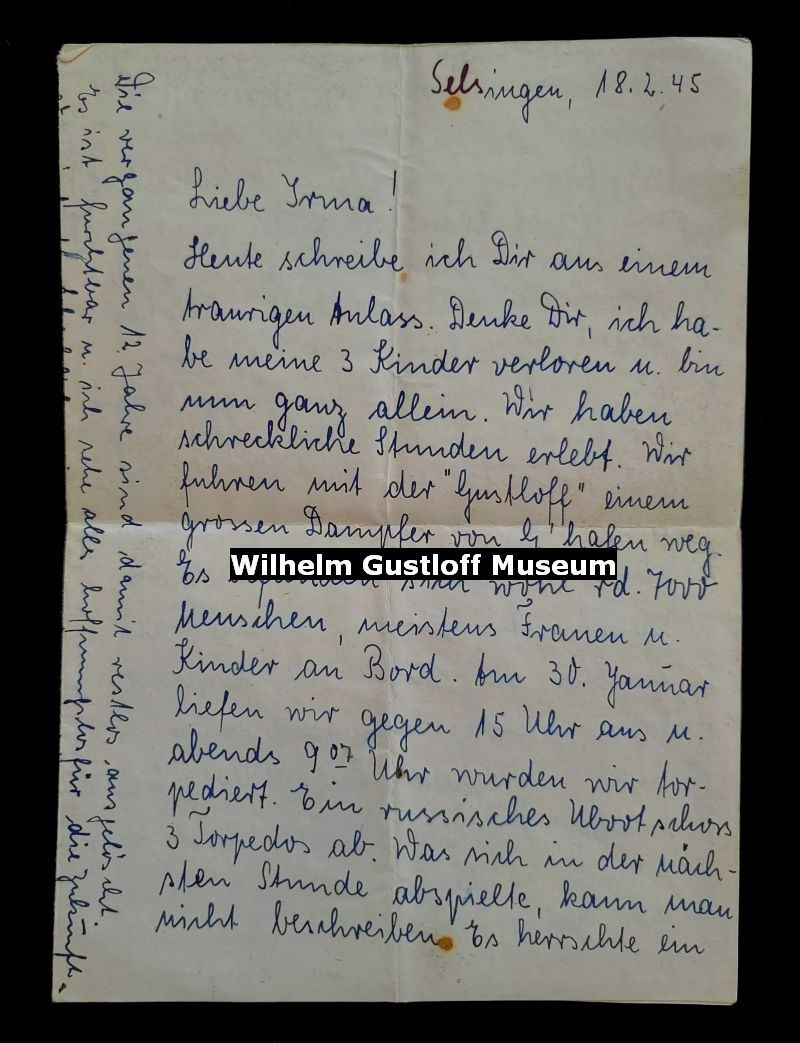
A poignant letter written by Betty Falk to her sister Irma on February 18th, 1945 regarding her survival of the sinking of the Wilhelm Gustloff. This generous donation to the museum collection was provided through Irma's grandchildren, who found it upon cleaning out her estate. I am honored to share this once lost letter to allow Betty's voice to be heard again after 78 years:
Selsingen, 18.2.45
Dear Irma,
Today I am writing to you due to a sad incident. Just think, I have lost my three children and now I am all alone. We have experienced horrible hours. We left Gotenhafen with the Gustloff, a large vessel. There were about 7,000 people on board, predominantly women and children. On the 30th of January we cast off at about 3pm and in the evening at 19:07 we were torpedoed. A Russian submarine shot 3 torpedoes. What happened during the next three hours is impossible to describe. A strong storm was blowing and everything was covered in ice, so that no lifeboat got to sea. On top of all, I had a small boy with me aged two and a half years. We were all wearing life vests. A sudden explosion catapulted me with a huge fountain up in the air, sat me back on deck, the next water took us. I had Helga on one hand and Edith (two daughters of Betty) on the other hand several meters up on a crane, and as the water arrived next time we were carried into the sea far away from the vessel, sank so deep that for a long time we were not able to make it back to the surface, and then I still had my children.
I steered in the direction of a raft floating in the sea and wanted to bring my children into it, but due to the heavy seas I was not able to. Only now I lost my consciousness. By chance a passing lifeboat picked me up and I came on board of a torpedo boat. Here I found myself in despair and more dead than alive and came then to Kolberg without any goods. I had nothing on me, just a blanket, because my skirt was ruined due to the oily water and the efforts of soldiers to get me out of it. In Kolberg nothing held me up except the thought that somewhere might be a child. Shoes and clothes I got from a charity (“Volksopfer”) and then I came with a van to Swinemünde. But also there was no information regarding my children.
To further move on we, a nurse and me, went on board of a picket and maneuvered through mine stricken seas and air raid warnings to Kiel. Thus, I travelled another 12 days and arrived grieving in body and soul at my parents. Ludwig (her husband, a marine) picked me up there and now I am in a village close to his camp. Now I am poor, destitute; have no more children! I cannot cry anymore, day after day I keep myself in the notion of being only on a journey and that the kids must come back one day. I just cannot believe it. With the vessel too all our possessions got lost consisting of 11 boxes with garments, clothes, books, tableware, carpets, beds, and mattresses, as well as all pictures and photos from the kids.
The past 12 years are hence completely annihilated. It is horrible and for the future all seems hopeless to me. Whoever will take responsibility for the horrors? I wish you, dear Irma, sincerely all the best for your Willy (husband of Irma, soldier at the front) and hope, that you have good news from him. To you and the small Inge (daughter of Irma) I send warm regards.
Yours deeply saddened, Betty
I forgot to write that Edith was sick with scarlet fever.... (the rest is unintelligible).
* I did make a mistake in the above porthole photo, which actually shows the port side windows of the rear dining room, and a possible location of the glass would've come from the starboard side.